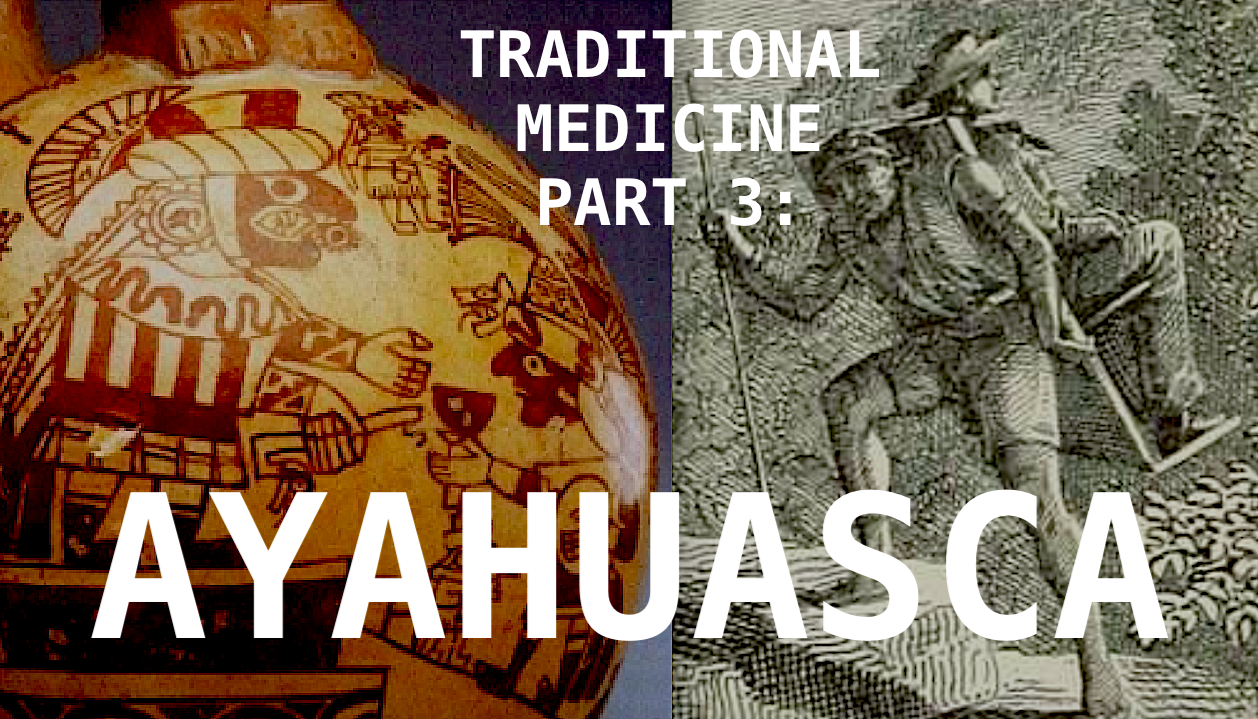The Amazing World of the Coca Leaf

CANNABIS CULTURE – “It will be shown by ample testimony that Coca is not only a substance innocent as is tea or coffee – which are commonly accepted popular necessities – but that Coca is vastly superior to these substances . . .”
- Golden Mortimer, M.D., Peru – History Of Coca – “The Divine Plant” Of The Incas, 1901 (1)

Image #1: doctorlib.info
One fact I’ve learned in my 30 years as a cannabis historian and drug peace activist that is very important, quite astonishing and demonstrably true is that non-proprietary medicines – mostly herbal medicines – are routinely demonized, stigmatized and under-appreciated by the medical establishment. The only thing many doctors and nearly all pharmacists seem to care about, have faith in or knowledge of are medicines that can be patented. If big pharma can’t carve out exclusivity for themselves, they’re not interested – even if the non-proprietary medicine is cheaper, safer and more effective than the synthetic version. And what big pharma wants, doctors and pharmacists tend to also want. The near-total abandonment of cannabis as a medicine between the 1930s and the 1990s by the vast majority of the global medical community is only one of many examples of this.

Image #2: doctorlib.info
High up on the list of demonized/stigmatized and under-appreciated herbal medicines is the coca plant. Sure, the coca leaf is where cocaine comes from, but the coca leaf is so much more than cocaine – and even cocaine can be used in ways that are beneficial, if used properly.

Image #3: Cocaine Handbook: An Essential Reference, David Lee, 1983
Aside from the non-proprietary nature of the coca plant and the establishment’s predictable reaction to that aspect, the other thing that coca and cannabis have in common is the contempt elites have for the general population who use these herbal medicines – as if regular people have no idea what’s good for them. As if accreditation makes someone more knowledgeable than those with first-hand, personal experiences. As if the average adult is a child who needs their rulers to hold their hands at all times to keep them safe from demonic influence and/or dangerous drugs. This is evident from examining the reactions of many of the first European invaders to coca users, right up to the reactions of today’s academic community and their nearly-universal contempt for medical autonomy.
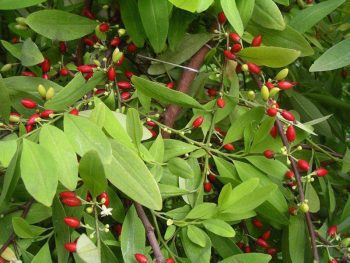
Image #4: Wikipedia: coca
The present-day attempt to control the stimulant economy through the prohibition or cartelization/monopoly of coca is the latest stage of the evolution of the conquest of the Americas by Europeans, the latest in a series of attempts to control and enslave – if not exterminate – the conquered.

Image #5: Wikipedia: coca
In this article I intend on sharing what I have recently learned about coca – its ancient and modern history, its medical uses, the proper and improper way to use it – and the history of attempts to demonize and stigmatize both the coca leaf and cocaine. Finally, I’ll share with you recent signs of the beginning of coca’s return to legitimacy today, similar to how cannabis began to return to legitimacy in the 1990s, as well as how legalized cocaine could solve many problems associated with the black market in cocaine.
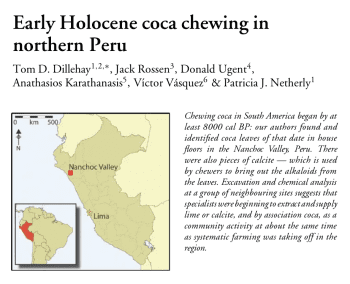
Image #6: scribd.com
The Ancient History of Coca
The use of coca began long before the earliest evidence of that use. The dawn of coca continues to be a date which is regularly re-evaluated to be even earlier than previously believed every few years or so. At this time, there is evidence of coca leaves found with lime – an alkaline mineral that activates the alkaloids in the leaf – that dates back to around 6000 BCE. (2) Pots with lime have been found that date back to 7000 BCE. (3) There is some evidence that coca was a domesticated crop by 3000 BCE. (4)

Image #7: evolutionofdruguse.wordpress.com
In spite of some coca prohibitionists and elitists claiming that coca was reserved for religious ceremonies and for elites, (5) most historians argue that coca was used also as a stimulant for work and a euphoric for recreation by all social classes, (6) mainly due to the fact that most of the earliest reports from the Spanish conquest – and the early Spanish coca prohibitionists – indicate this to be so. (7) There are many more reports of common use than exclusive use. Claims of ancient exclusivity may be attempts to rationalize modern-day exclusivity. It may be true that the Inca state had a monopoly on cultivation and distribution, but these monopolies may have been as disrespected then as they are now, and people could still wildcraft coca leaves from wild coca trees. Cultivated coca grows in bushes, but wild coca can get pretty tall, and qualify as an actual tree by some definitions.
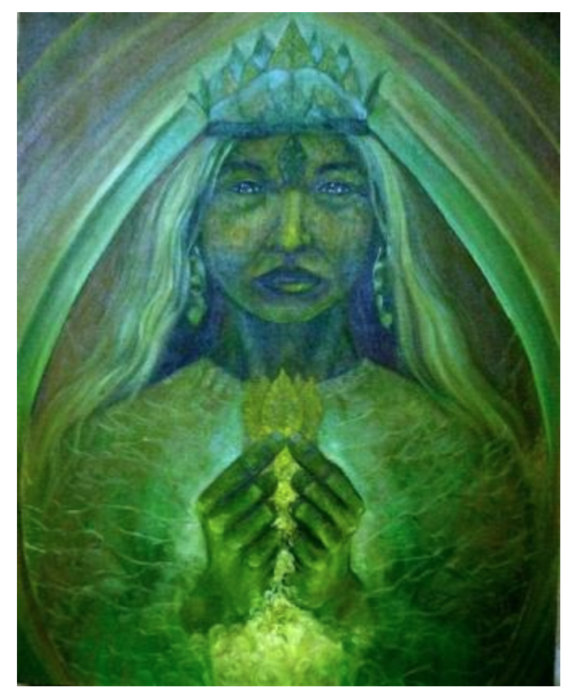
Image #8: “Mama Coca”. Image from viajeslibres.com
The word “coca” comes from the Aymara word “khoka”, which means “the tree”. (8) One legend involving an alternative origin of the word comes from the tale of Kuka, a woman of such beauty that her charms became threatening to the Inca establishment, who cut her in half and buried her. From her grave sprang the first coca plant, which “gave strength and vigor and alleviated pain and suffering.” (9) There is also the tale of Incan king Mayta Ceapac, who reigned between 1290 to 1330 CE (10) and his wife Mama Coca – the “mother of coca”, who was worshipped along with coca itself as a manifestation of the divine. (11) The Kuka legend and the Mama Coca tale are sometimes confused as being parts of the same story. (12)
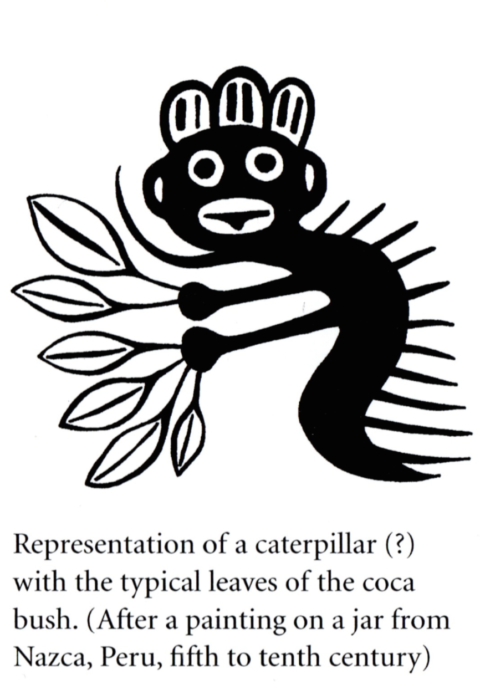
Image #9: The Encyclopedia of Psychoactive Plants, Christian Ratsch, 1998, p. 259
There are pre-conquest images of coca leaves from at least a thousand years ago, in the form of a caterpillar holding coca leaves in its hands, painted on a jar from Nazca, Peru. (13) Jars from the Moche civilization in Peru depict shamans chewing coca – using lime containers, lime-grabbing spoons or sticks, and bags containing leaves – date from around 500 CE. (14)
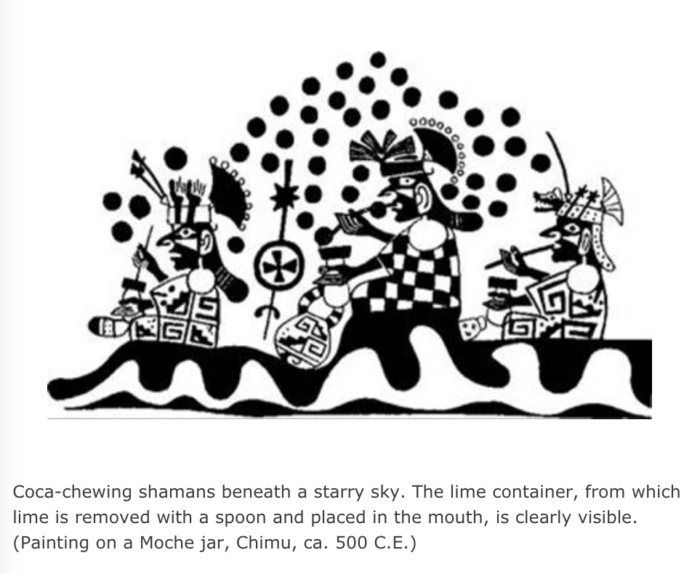
Image #10: The Encyclopedia of Psychoactive Plants, Christian Ratsch, 1998, p. 259
There are many pre-conquest ceramic depictions of coca chewers – figures with lumps in one cheek, indicating a “quid” or “acullico” (something that is chewed but not swallowed) of coca being sucked on. Many of these chewers appear to be regular people as they are not wearing the trappings of royalty or elites. Some say these coca chewer ceramics date as far back as 3000 BCE – from the ancient Valdivia culture. (15)

Image #11: Coca leaf chewing figure from the Nariño culture, a people who once lived in communities in the mountains of Nariño, Colombia from 800 to 1500 AD. Image from Frans Vanderwalle on flickr.com
It is claimed that the first European to witness, record and – in 1504 – publish an account of the use of coca was the Italian explorer (and slave kidnapper) Amerigo Vespucci (16), whom the continents of North and South America – and the United States of America – are appropriately named after. Initial images from the Spanish conquistadors in the early 1600s show the Incans gathering coca, or sharing the leaves. Eventually, in the 1800s, detailed depictions of coca plantations – and of scientifically accurate botanical illustrations of the coca plant – begin to appear.

Image #12: Detail, ‘The grower’ – Illustration from the Chronicle of Felipe Guaman Poma de Ayala. Early 17th century. Image from National Geographic Magazine, storicang.it
The Modern History of Coca and Cocaine
For the sake of simplicity, the “modern” period will be from 1700 onward, which brought with it the age of enlightenment, the first encyclopedia, and a desire to investigate, understand and explain things such as herbs and medicines by scientists and writers. From this period onward, the coca plant appears in many botanical illustrations, chemical analysis, histories, patent medicines and other works.

Image #13: Ruiz, H., Pavon, J., Drawings of the Royal Botanical Expedition to the Viceroyalty of Peru, 1777. Image from plantillustrations.org
The first introduction to coca in English language newspapers may have been in The Times of London, on January 20th, 1855, when an excerpt of the 1854 book The Chemistry of Common Life, by James F. W. Johnston, (17) provided this bit of insight into the marvels of the coca leaf:
“The Indian of the Peruvian Andes, and many also of the intruding white race, indulge in the silent and contemplative mastication of the coca leaf. Our highest and greatest emotions we prefer to enjoy by ourselves, and this particular pleasure is one that dispenses with company, and would have been an invaluable addition to Milton’s Penseroso. You may drink it as a tea; you may exhibit it as a powder; but the most usual method is to troll it as a quid. Like tobacco, it stays the approaches of hunger, and, like tobacco, it diffuses over the frame a serene felicity; but it does something more than this – it has a further specific effect, we are told, making toil altogether easy to be borne, and mountains, however precipitous, easy to be surmounted . . .” (18)
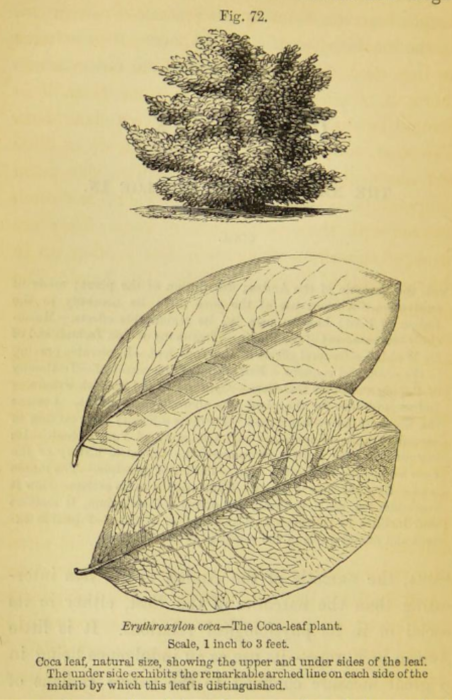
Image #14: The Chemistry of Common Life by James F. W. Johnston, 1854, p. 138
The first major introduction of coca to the European medical community was the 1859 essay of the Italian neurologist, physiologist, anthropologist and senator Paola Mantegazza, (19) which was reprinted in English in 1860. (20) Titled “ON THE DIETETIC AND MEDICINAL PROPERTIES OF ERYTRHROXYLON COCA,” it touted the utility of coca leaves as both medicine and food for all classes to enjoy. (21) He famously stated that;
“I would rather have a life span of ten years with coca than one of 1,000,000 centuries without coca.” (22)

Image #15: proquest.com
The same year of Mantegazza’s essay, a German chemist named Albert Niemann became the first person to extract cocaine from the coca leaf. He published his process on January 1st, 1860. (23)
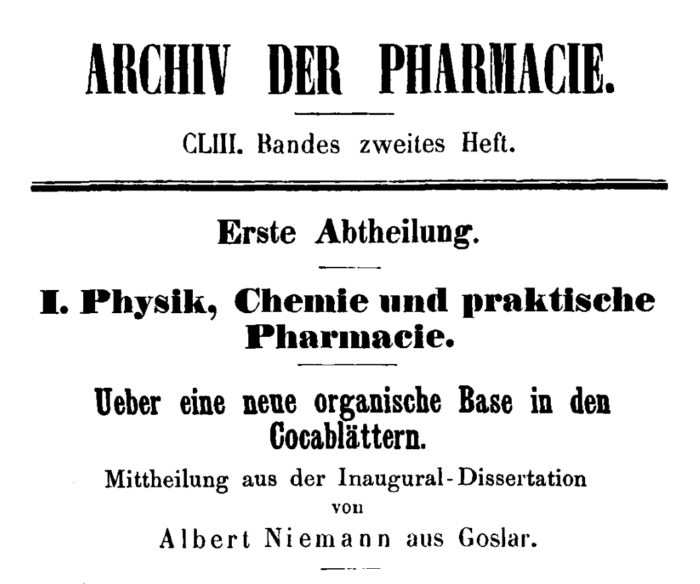
Image #16: zenodo.org
The next major milestone in modern coca history is the birth of coca wine. Angelo Mariani – the son of a Corsican pharmacist – was an assistant in his father’s pharmacy before moving to Paris sometime between 1860 and 1863. While working as an apprentice, he began making new tonics. First he made “Quinquina Mariani”, an extract of the cinchona bark which was a popular anti-malarial herbal medicine. Then he learned of the coca plant, and sometime between 1863 and 1869 he created “Vin Mariani” – coca-infused wine. (24) He then promoted his new product with a massive amount of celebrity endorsements and an even greater number of stunning visual advertisements, earning him the reputation of being “the father of modern advertising”. (25) For example, some of the endorsement highlights – a tiny fraction of the total – include the following:
“Enthusiastic testimonials were showered on Mariani by Thomas Edison, H.G. Wells, Henrik Ibsen, General Lyautey (conqueror of Morocco), President McKinley, mathematician Henri Poincare, astronomer Flammarion, playwright Edmond Rostand, sculptor Auguste Rodin, composers Gounod and Massenet, legendary actress Elenora Duse, Louis Bleriot (who sipped Mariani’s wine as he flew the Channel for the first time in 1909), Jules Verne, and Emile Zola.” (26)

Image #17: Sketch by Gustave Jossot, 1905, Coca Wine, Aymon De Lestrange, 2016, p. 84
Mariani would even help create a beautifully illustrated children’s story that featured bottles of his coca wine as the cure for horrible diseases. Titled “Le Chateau de la Grippe” (Flu Castle), it was written by famed graphic artist and novelist Albert Robida, illustrated by his daughter Emilie, and published in 1904. A copy is available online. (27)
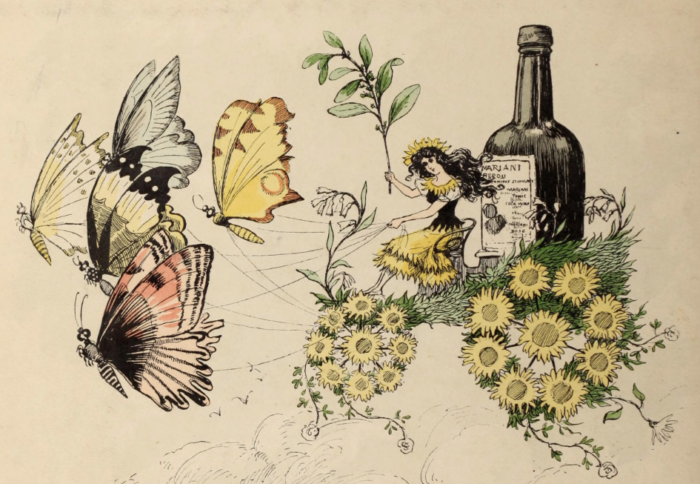
Image #18: From archive.org: Le château de la grippe /par A. Robida, 1904.
In 1885, an unknown, impoverished Austrian neurologist wrote an article extolling the virtues of cocaine, after trying it out on himself and sharing it with as many people as possible. The article would open the door to its medical use, both as an anti-depressant and stimulant, and as a pain-killer. Titled “Uber Coca”, the neurologist was Sigmund Freud, who would go on to global recognition as the founder of the branch of psychology known as psychoanalysis. There will be more about Freud the coke pusher below.

Image #19: “COCAINE: AMERICA’S 100 YEARS OF EUPHORIA AND DESPAIR”, Life Magazine, May 1984, p. 57
In 1886, a pharmacist named John Stith Pemberton invented a non-alcoholic version of Vin Mariani. Pemberton was a veteran of the Confederate Army who had been wounded in the Battle of Columbus, and had been experimenting with alternative painkillers to morphine, which he was addicted to. (28) In 1884 he began advertising his own Pemberton’s French Wine Coca, (29) which was inspired by Vin Mariani but contained two additional ingredients: the kola nut (which contained caffeine) and damiana (an aphrodisiac). (30) Near the end of 1885, Atlanta passed an alcohol prohibition law, so Pemberton cut the alcohol and the damiana out of his drink and Coca Cola was born. (31)

Image #20: cnn.com
Also in 1886, a Scottish author named Robert Louis Stevenson published his Gothic novella Strange Case of Dr. Jekyll and Mr. Hyde, writing 10 thousand words per day for six days, all while very ill. Rumour has it Stevenson was under the influence of cocaine. (32)

Image #21: Poster from the 1880s. simple.wikipedia.org: Dr Jekyll and Mr Hyde
In 1887, a 28-year-old physician and eventual friend of Stevenson’s (33) named Arthur Conan Doyle published the first Sherlock Holmes novel, “A Study In Scarlet,” which had Dr. Watson notice that Holmes had “a dreamy, vacant expression in his eyes” and had “suspected him of being addicted to the use of some narcotic”. (34) In the second Sherlock Holmes novel, “The Sign Of The Four” (published three years later), Doyle revealed that the drug Holmes was on was cocaine, which Holmes injects with a hypodermic syringe. He then offers some to Watson;
“‘It is cocaine,’ he said, ‘a seven-per-cent solution. Would you care to try it?’” (35)

Image #22: From stage adaption of ‘Sherlock Holmes’, AF Fotografie/Alarmy Stock Photo, haaretz.com
By this time both coca leaves and cocaine could be found in nearly every drugstore, supplied by most of the major pharmaceutical firms. The number of products containing coca leaf or cocaine probably numbered in the hundreds if not more. The following list of products is only a list of confirmed products, and is by no means a comprehensive list.

Image #23: Advertisement in the Practical Druggist and Review of Reviews, August, 1907. Coca Wine, Aymon De Lestrange, 2016, p. 162
F. Boehringer & Soehne sold Hydrochlorate of Cocaine, Cocaine Muriate, and “Pure crystals” (in large crystals, small flakes or powdered form), and advertised themselves to be the “LARGEST MAKERS IN THE WORLD OF QUININE AND COCAINE”. Eli Lilly supplied Cocaine Hydrochloride, Fluid Extract of Coca Leaves, Nausea Tablets containing cocaine hydrochloride and Mentholated Throat Tablets containing cocaine. Parke, Davis & Co supplied Cocaine Hydrochloride Hypodermatic Tablets, Cocaine Hydrochlorate, Nausea Tablets containing Cocaine Hydrochloride and/or Hydrochlorate, Coca Cordial, Powdered Extract of Coca, small packages of Coca Leaves and cocaine cigarettes and cigars.

Image #24: mhc.andornot.com
John Wyeth & Brother sold pure Cocaine Hydrochloride, Nausea pills containing Cocaine Hydrochloride, as well as various Preparations of Coca Leaves, including tincture, infusion, wine and syrup. Burroughs Welcome supplied the pure alkaloid of Cocaine, as well as Cocaine Hydrochloride, and “Forced March” tablets, containing “the combined active principles of Kola Nut and Coca Leaves”. Sharp & Dohme sold Cocaine Hydrochloride Hypodermic Tablets. E.R. Squibb & Sons sold Cocaine Hydrochlorate. Mallinckrodt sold Cocaine Hydrochloride. American Druggists Syndicate sold Fluid Extract of Coca. Lloyd Manufacturing Co. made Cocaine Toothache Drops. Merck sold Cocaine Hydrochloride, Cocaine Hydrochlorate, Cocaine Carbolate, Cocaine Nitrate, Cocaine Salicylate, Cocain Sulphate and hydrochloric crystals of cocaine.

Image #25: addictionrecoveryebulletin.org
Some of the smaller or lesser known firms also were in the coca/cocaine supply game. Palisade Manufacturing Co. made Kola-Cardinette, with coca extract. Rio Chemical Co. made Celerina, which contained coca in an alcohol and ether solution. Nelson Baker & Co. made Compound Extract of Celery with coca extract. Nyal’s sold Compound Extract of Damiana with Coca extract. Allen Cocaine Manufacturing Co. made Cocaine Nasal Tabloids. Robinson Apothecary and Masonic Temple supplied Cocaine Hydrochlorate. Dr. Nathan Tucker of Mt. Gilead, Ohio provided an Asthma Specific which included 7.5 grains of cocaine per ounce. C. L. Mitchell, M.D. supplied “Coca-Bola” coca paste – or gum – for chewing, made from coca leaves.
 Image #26: Advertisement for Coca-Bola chewing gum, Coca Wine, Aymon De Lestrange, 2016, p. 153
Image #26: Advertisement for Coca-Bola chewing gum, Coca Wine, Aymon De Lestrange, 2016, p. 153
The Vitarine Co. sold Cocaine Hydrochloride half gram ampuls. D. P. sold Menthol Borate & Cocaine. Burgoyne sold Guttae Cocainae B. P. C.. Lotterer & Speidel sold Coca Praeparate. Allenburys made several different types of Cocaine Throat Pasteilles in England, and Laboratoires Midy made Throat Pastilles in France. Cocabacco Co. – headquartered in Saint Louis – made coca cigarettes called “Cocarettes”: half Virginia tobacco, half Bolivian coca leaf. The Churchill Hospital had its own Cocaine Hydrochloride in a 5% solution. And Ogden Pharmacal Co. of Ogden, Utah sold bottles of Cocaine in a 7% solution, just like Sherlock Holmes used.
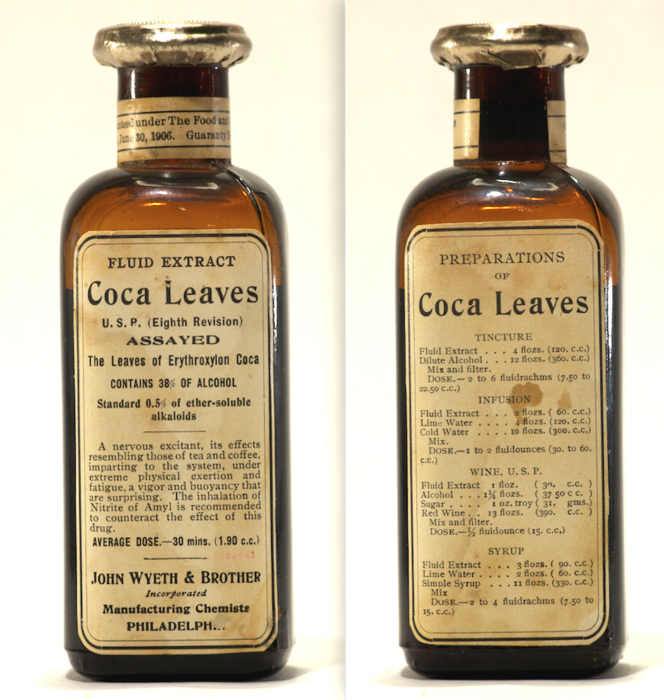
Image #27: Fluid Extract of Coca Leaves, John Wyeth & Brother, herbmuseum.ca – photo by Bert Easterbrook
There was a product called “Burnett’s Cocoaine” – sometimes spelled “cocaine” – but it was just made with coconut oil – had no cocaine in it – and was just trying to capitalize on the trend of coca-based medical products. Today, there are many fake antique medical cocaine bottles for sale online – sometimes they say they are “handcrafted” and “vintage style” bottles, but sometimes they are put up for sale as genuine. It takes some practice – and knowledge of what genuine bottles are marked, stickered or embossed by – to be able to identify real antiques from fakes.

Image #28: “Heritage Inspired Vintage Style” (fake) cocaine bottles, etsy.com
After the 1920s, cocaine’s legal, legitimate uses would be limited to its pain-killing properties, mostly used as a local anaesthetic and blood vessel constrictor in surgery. Merck and Eli Lilly continued to sell Cocaine Hydrochloride. Today, Roxane Laboratories supplies Cocaine Hydrochloride. Sandoz sells Cocaine in a topical 10% solution. Lannett and Genus sell Cocaine Hydrochloride in a Nasal Solution.
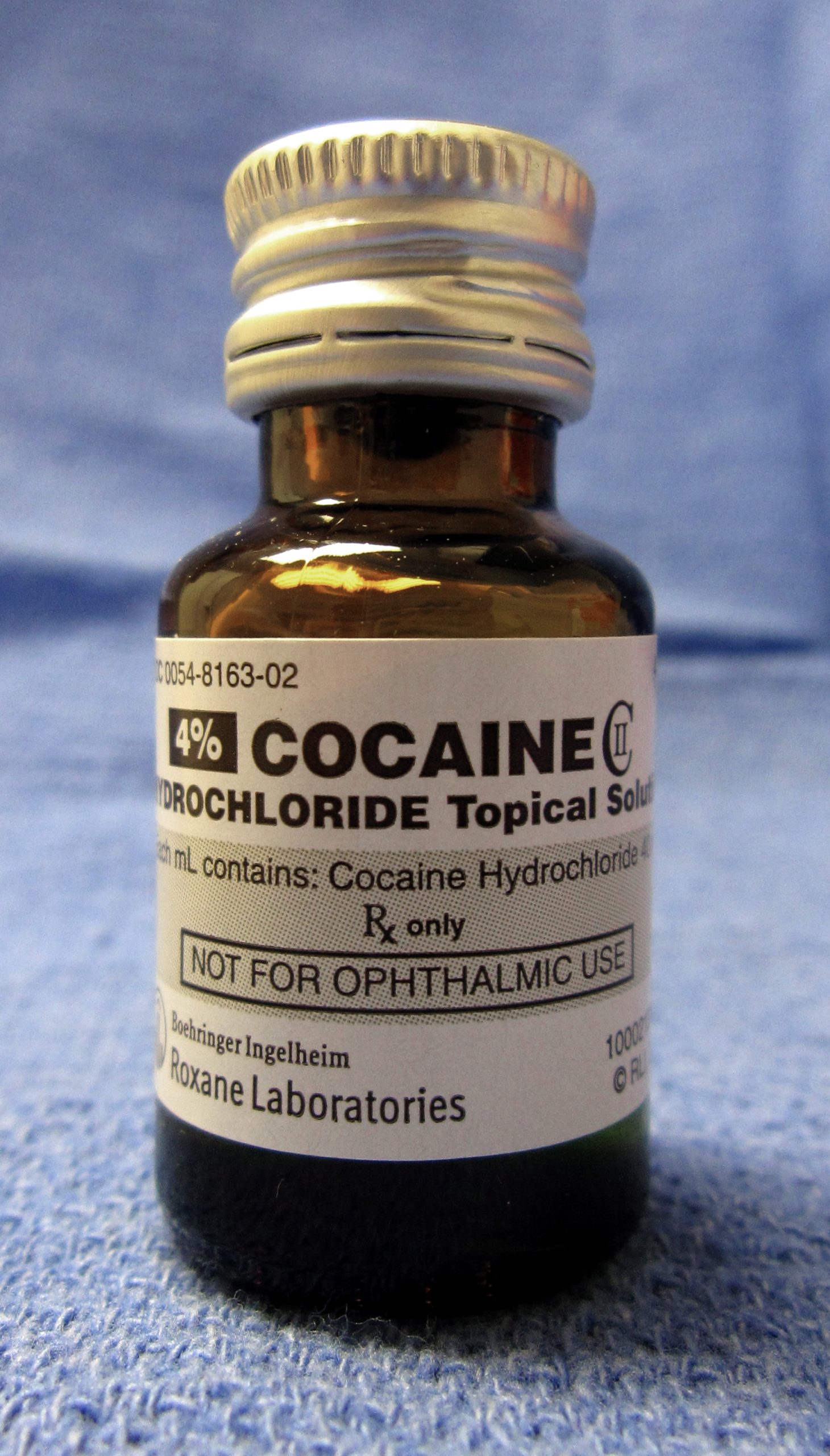
Image #29: Cocaine hydrochloride for medicinal use. commons.wikimedia.org
Beginning in the 1860s, cocaine began to appear in the various dispensatories, pharmacopoeias and indexes of the medical establishment. The U.S. National Dispensatory of 1894 provided two full pages to coca and another seven more to cocaine. In it, it was written that;
“Coca was used by the aborigines of South America long before their conquest by the Spaniards. They regarded it as a divine gift, employed it in religious ceremonies, and spoke of it as ‘that heavenly plant which satisfies the hungry, strengthens the weak, and makes men forget their misfortunes.’ These reasons were sufficient to render it abominable in the sight of the fanatical invaders, who forbade its use and culture. But when they discovered that it enabled the conquered people to perform the work of their taskmasters, they winked at its diabolical origin and virtues.” (36)

Image #30: “Natives of Columbia chewing coca” from Angelo Mariani, COCA and its Therapeutic Application, 1896. Courtesy National Library of Medicine: nlm.nih.gov
This is a recurring theme in the history of drug policy – the prohibition never has anything to do with a genuine concern over the population subjected to it – it is always for the benefit of the rulers, and disappears the instant it no longer meets the needs of the rulers. Prohibitions that are removed by rulers are usually replaced with monopolies or cartels – which also meet the needs of rulers. This is true for coca, for cocaine, for cannabis – for virtually all medicine with the possible exception of the non-controversial, non-psychoactive herbal medicines. This is discussed matter-of-factly in many of the histories of coca, but when one points out the same thing is happening with cannabis today, one is either dismissed as a conspiracy theorist, or else the myth of cannabis psychosis is trotted out as justification for the cartel.

Image #31: COCA PLANTATION, Peru, 1854, illustrated by Lieut. L. Gibbon, United States Navy. Herb Museum collection, photo by Bert Easterbrook.
In 1901, the first and only truly comprehensive history of coca was published. Titled “Peru – History Of Coca – ‘The Divine Plant’ of the Incas”, it was written by Dr. W. Golden Mortimer, who decided to only write one book during his life, but to make it the most detailed and complete book possible. Many clues regarding the applicability of coca to medicine were provided, including the following passage:
“The child and the feeble old man seize with eagerness the leaves of the wonderful herb, and find in it indemnification for all suffering and misery.” (37)

Image #32: “Peru – History Of Coca – ‘The Divine Plant’ of the Incas”, W. Golden Mortimer, M.D., 1901, p. 148
It was around this time that U.S. racist and classist elites who wished to blame non-whites and poor people for the misery and injustice they suffered – rather than the racist and classist institutions they suffered under – began to stigmatize the use of drugs in newspapers and magazines. They did this by confusing immoderate use with all use, and argued that drug abuse led to poverty rather than the reverse. For Asians, elites used their use of opium as a target of their stigmatization campaign. For Mexicans, elites used their use of cannabis. For African Americans, elites used their use of cocaine. A detailed analysis of this process can be found in the “Demonization and Stigmatization of of Coca and Cocaine” section below.

Image #33: “Pen Pictures of Cocaine Fiends, Showing Some of the Effects the Drug Works Upon Its Unfortunate Victims”. “HOW HUMAN VICTIMS ARE WRECKED BY THE TERRIBLE COCAINE HABIT,” The Atlanta Constitution, Atlanta, Georgia, January 15th, 1905, p. 7
Right around the turn of the century, a series of laws were written – some national, and some international – that began to have an effect on the cocaine industry. At first, these were regulatory in nature – the 1906 U.S. Pure Food and Drug Act sought to make sure drugs were properly labelled. Drugs such as “alcohol, morphine, opium, cocaine, heroin, alpha or beta eucaine,” and “cannabis indica” were mentioned by name. (38)

Image #34: Collier’s Magazine, June 3rd, 1905, p. 5 and May 13th, 1912, cover.
While requiring accurate labels is an excellent idea and totally justified, the real reason behind the move became quite apparent just a year later, when a bunch of Skull & Bones frat boys who had put themselves in positions of power and influence in the U.S. federal government began to experiment with drug prohibition in the Philippines – at that time a U.S. colony. They outlawed some of the very same drugs there that the U.S. required labelling for the year before;
“Sec. 31. Any unauthorized person owning, carrying, holding, having, controlling, having possession of, or knowingly having on his premises, any opium, cocaine, alpha or beta eucaine, or any derivative or preparation of such drugs or substances, on and after March first, nineteen hundred and eight, shall be punished by a fine not exceeding ten thousand pesos, or by imprisonment for not exceeding five years or by both such fine and imprisonment, in the discretion of the court . . . ” (39)

Image #35: May, 1968 Ramparts Magazine cover.
In other words, the punishment for simple possession of opium or cocaine in the Philippines was up to five years in prison or a potentially massive fine, or both, whereas just a year earlier simple possession was completely legal. At the time the new law became effective, there had been 12,668 registered habitual users of opium in that country. (40)
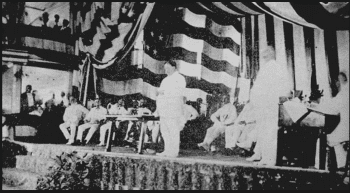
Image #36: William Howard Taft addressing the First Philippine Assembly in the Manila Grand Opera House, October 16th, 1907 (one day before the Philippine drug prohibition law was to be put into effect). wikipedia.org: Philippine Assembly
From this point on, these Skull & Bones members – one of which was William Howard Taft, who was Governor-General of the Philippines from 1901 to 1903, President of the United States from 1909 to 1913, and Chief Justice of the Supreme Court from 1921 to 1930 – used their power and influence to shape drug policy both domestically and internationally. (41) They made sure the major botanical medicines of the world – cannabis, opium and coca (and their extracts and derivatives) – were illegal, so that future Skull & Bones members in the CIA could become rich and powerful, (42) just like the Skull & Bones benefactors (and opium smugglers) who began that fraternity in the 1800s had been made rich and powerful from the prohibition of opium. (43) This historical fact only sounds controversial to those who haven’t bothered to familiarize themselves with the mountain of evidence of US military intelligence involvement in the global trade in illicit drugs since World War 2, and outright control of the lion’s share of the global drug trade by the CIA from 1967 onward. (44)

Image #37: Sources of evidence of CIA control of the global illegal drug smuggling economy.
The money the CIA makes from illegal drug smuggling goes on to fund “black ops” – assassinations, coups, secret wars, not-so-secret wars, and death squads – some of the worst human rights abuses in human history. The CIA’s job was (and is) to make sure the right people are in power – regardless of how many people they have to kill and torture to do it. By now there is quite a lot of evidence gathered and put before the public – such as that which is found in the 2017 book The CIA As Organized Crime by Douglas Valentine – available free online – (45) – that would convince any open-minded person of this being true.

Image #38: The best book on the subject: The CIA As Organized Crime by Douglas Valentine, 2017, available free online.
It could be argued that these smuggling operations are a key component of the CIA’s subjugation and enslavement of humanity on behalf of Wall St. Arguably, by eliminating the black market in illegal drugs, that key component could be removed, and democratic institutions might have a chance of functioning properly. This very well might be the best reason to legalize cocaine – it would cut deeply into the death-squad budget.

Image #39: Vansterdam Comix, 2018 – written by David Malmo-Levine and illustrated by Bob High – has over 100 pages on CIA drug trafficking history.
The process of first identifying stigmatized drugs in the US in 1906, and then prohibiting these drugs outright once they were clearly identified, reminds this author of the similar tactic used by the Nazis to first identify and then eliminate the Jews of Europe. Requiring certain stigmatized groups (in this case, stigmatized drugs and the users, growers/producers and dealers of such drugs) to be identified is now considered one of the tell-tale signs of looming genocide by the international community. (46)

Image #40: Thomas Szasz’s Ceremonial Chemistry, 1974, compares the scapegoating of Jews to the scapegoating of drug users. Available free online at archive.org
Elihu Root wasn’t a member of Skull & Bones, but he was both an employee and an employer of powerful Skull & Bones members, and was one of the architects of today’s system of international drug prohibition. Root organized the 1909 Shanghai Commission, (47) which was the process which led to the first of many international drug control treaties in 1912. (48) Subsequent treaties were created in 1925, 1931, 1936, 1946, 1948, 1953, 1961, 1971, and 1988.

Image #41: Elihu Root, 1902. wikipedia.org: Elihu Root
The stated purpose of the treaties was for “narcotics control”, but as can be plainly seen from news coverage of the drafting of the 1961 Single Convention (a consolidation of all the treaties created thus far), the real aim of the treaties was to stigmatize useful plant medicines, only one of which was an actual “narcotic”;
“The aim of this draft convention is to simplify the law relating to narcotics control, to simplify the international control machinery, to ensure control of the cultivation and harvesting of narcotic-producing plants, and to achieve international prohibition of such activities as opium smoking, opium eating, and marijuana and coca-leaf consumption.” (49)

Image #42: Narcotic “control” or plant-medicine stigma? “Bishop Griffiths, Dr. Re On Holy See U.N. Unit”, The Tablet, Brooklyn, New York, February 4th, 1961, p. 16
As was outlined in the United Nations document “SINGLE CONVENTION ON NARCOTIC DRUGS OF 1961 as amended by the 1972 Protocol”, “Coca leaf chewing must be abolished within twenty-five years”, (50) but the right of Coca Cola to use coca leaf as a “flavouring agent” will be protected – just as it was by America’s first national drug prohibition, the Harrison Narcotic Act of 1914. (51) This exclusive market has made Coca Cola, The Stepan Company (the company that extracts the cocaine from Coca Cola’s leaves), and Mallinckrodt Inc. (the company that takes Stepan’s extract and prepares it for sale to the pharmaceutical industry) very, very wealthy. (52) Due to a change in law in 1969 that states that Coca Cola no longer has to prove to the U.S. government that its product is cocaine-free, more than one researcher has indicated that there may indeed be tiny amounts of cocaine in that product today. (53)

Image #43: killercoke.org
And what does Coca Cola do with the massive profits resulting from their exclusive coca importation privileges? Aside from their negative impact on human health and the environment, they conduct racist business practices, (54) their associates in the Columbian bottling industry consort with death squads in order to murder union leaders and crush unions, (55) they make major campaign contributions to far right politicians in Israel, (56) and huge campaign contributions to American politicians, (57) including Donald Trump. (58) Their reputation for far right support is so tarnished that it’s been immortalized in song: Drink of the Death Squads. (59)
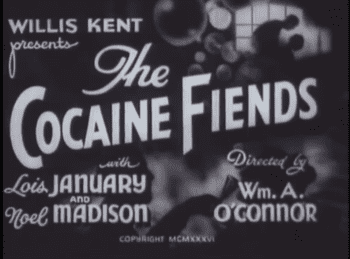
Image #44: The 1935 film The Cocaine Fiends, AKA Cocaine Madness or The Pace That Kills, youtube.com
Beginning in 1909, a series of “drugsploitation” movies focusing on cocaine came out, making sure the audience knew for certain that the abuse of cocaine was the only type of use possible. It began with The Curse of Cocaine (1909) and included For His Son (1912), Cocaine (1922), The Pace That Kills (1928), Cocaine Fiends – AKA The Pace That Kills (1935), Cocaine – The Thrill That Kills (1949/1951), Superfly (1972) and Scarface (1983). To this list we must also add a subset of movies that handled the issue of cocaine differently – putting a comedic spin on the concept. The Mystery of the Leaping Fish (1916), Modern Times (1936) and Manhattan (1979) made audiences laugh about cocaine, and in doing so, made it just a little bit less frightening.

Image #45: A coked-up Charlie Chaplin in the 1936 film Modern Times
The 1983 film Scarface, which was written by subversive screenplay author and film director Oliver Stone, both stigmatized the use of cocaine and introduced audiences to the idea that governments were involved in the trade – including the U.S. government;
“And here is our friend Charles Goodson from Washington.” (60)

Image #46: Scarface, 1983
Given what was actually happening in South and Central America in 1983, the character of Charles Goodson might have represented George H.W. Bush associates Donald Gregg or Oliver North – both of whom were involved in CIA drug smuggling operations in that area during that time period, both of whom were veterans of CIA drug trafficking operations since at least the Laos opium/heroin operations during the Vietnam war, both of whom worked in both Latin America and Washington. (61)

Image #47: REUTERS/Stringer
Subsequent films such as Air America (1990), Double Crossed (1991), Kill the Messenger (2014), and American Made (2017) brought more attention to the reality of CIA drug trafficking to the general public, but not enough to bring it to an end – or even result in an investigation that wasn’t itself under the control of former Skull & Bones members. (62) Because there has never been any real consequences for the CIA perpetrators of illegal CIA drug operations, there is no reason to believe that such operations don’t continue today – especially considering the hundreds of billions of dollars they generate.

Image #48: Quote from The CIA As Organized Crime, Douglas Valentine, 2017, p. 98
Many songs about cocaine – or songs referencing cocaine – also floated through the collective consciousness. Most of them were cautionary tales. Notable examples are Luke Jordan’s Cocaine Blues (1927), Victoria Spivey’s Dope Head Blues (1927), The Memphis Jug Band’s Cocaine Habit Blues (1929), Dick Justice’s Cocaine (1930), and Cab Calloway’s Minnie The Moocher (1931) – the last of which became a Betty Boop cartoon produced by Max Fleischer and released in 1932. Other examples from the 1930s include Florence Desmond’s Cigarettes, Cigars! (1933), Leadbelly’s Honey, Take A Whiff On Me (1935), Chick Webb & Ella Fitzgerald’s Wacky Dust (1938) and Cab Calloway’s The Ghost of Smoky Joe (1939).

Image #49: Max Fleischer’s Minnie The Moocher, 1932, music by Cab Calloway
Various versions of these songs were re-recorded in the subsequent years. Bob Dylan helped bring cocaine back into vogue in 1962 with his version of Cocaine Blues, which he titled as simply Cocaine. Country and Western singer Hoyt Axton wrote both Snowblind Friend, which he recorded in 1969, and The Pusher, which Steppenwolf performed for the Easy Rider soundtrack that same year, and released as a single the following year. Black Sabbath released Snowblind in 1972, which was also the year Curtis Mayfield released Pusherman. J.J. Cale wrote and recorded Cocaine in 1976, and then Eric Clapton put out his version of Cale’s song the next year and it became a smash hit, and one of his most popular works. 1976 was also the year David Bowie recorded Station To Station, which not only referenced cocaine, but was created and produced while Bowie was using so much of it he doesn’t even remember making the album. (63)

Image #50: The German picture sleeve cover of the single Cocaine by J.J. Cale, 1976
Many other songs have been written about cocaine since the 1970s, and I will mention three more: Public Enemy’s 1988 song Night Of The Living Baseheads – a rail against the effects of crack cocaine (a cheap and smokeable form of cocaine) on the black community; The Reverend Horton Heat’s 1993 tune Bales Of Cocaine – a song about a farmer coming across bales of cocaine dropped from a low-flying plane, selling the bales, becoming rich, and then going down to Peru to become a coca farmer; The Weeknd’s 2015 hit Can’t Feel My Face – a song about the face-numbing effects of cocaine. One can find dozens more examples just by searching for “songs about cocaine” on the internet.

Image #51: grailed.com
The Medical Uses of Coca Leaf
While there are many different types of coca leaf, there are two main types of leaf used in medicine. There is the Bolivian coca, which is rich in cocaine, and there is the Peruvian coca, richer in other alkaloids. It is the Peruvian coca that is preferred for chewing by the indigenous people of South America. (64) It appears that – similar to coffee – “the higher the altitude the shrub can be cultivated without frost, the better is the quality of the product”. The yield is less but the alkaloids are more abundant and of better quality. (65) This “does best in tall warm mountains” aspect explains why the coca plant only grows in a few places on earth.

Image #52: “This shrub was domesticated in Peru perhaps 7,000 years ago, theorizes Chicago Field Museum botanist Timothy Plowman, framed by a few of the some 230 species of Erythroxylum. Only E. coca, at top right, and three other cocas developed from it contain useable amounts of cocaine.” “COCA: An Ancient Indian Herb Turns Deadly”, National Geographic magazine, January 1989, p. 14
Western medicine has made the mistake of evaluating coca’s medicinal potential entirely on the basis of the cocaine content, and have ignored the other alkaloids. (66) Just like cannabis, coca is not just one medicine, but many. Cannabis has over 100 cannabinoids and over 200 terpenes (or terpenoids), none of which are toxic, many of which have proven medical efficacy, all of which may one day be understood as medically effective. (67) And coca has “at least 14 separate alkaloids”, (68) most of which show some type of medical efficacy.
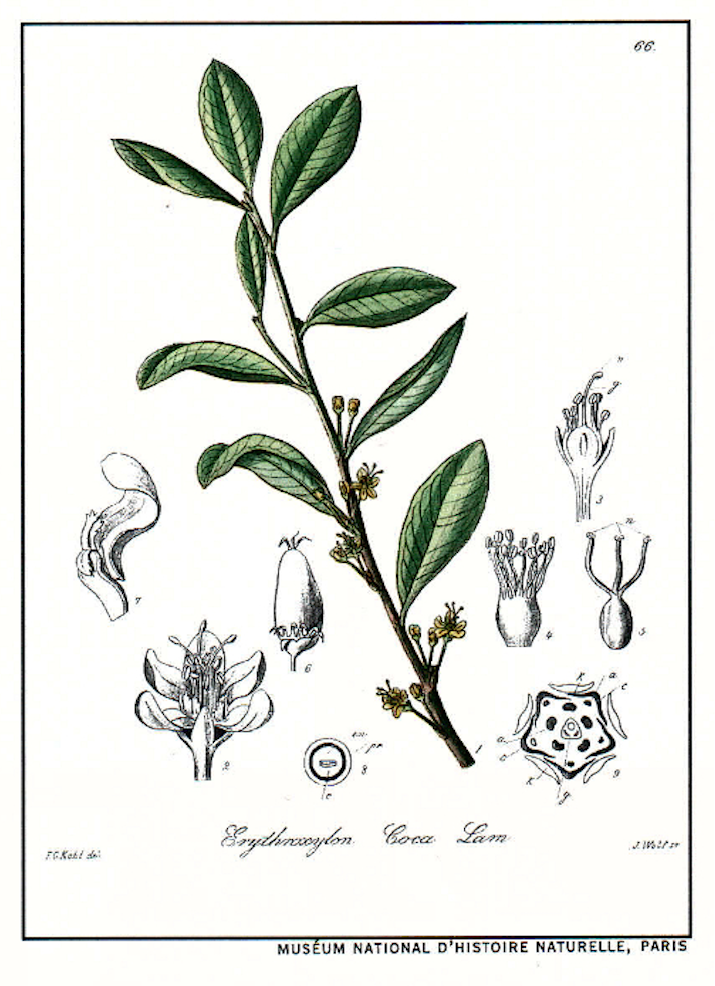
Image #53: “Mislabeled in this 1895 print, E. novogranatense var. novogranatense is the coca grown by the Kogi.” “COCA: An Ancient Indian Herb Turns Deadly”, National Geographic magazine, January 1989, p. 14
Cocaine shares another trait with cannabis above and beyond a) being maligned and ignored by the medical establishment, and b) containing many different types of medicines: c) the whole plant medicine has an “entourage” or “ensemble” effect – the different medical constituents act together to create a more beneficial effect than each isolated element would on its own. In the case of coca, the other alkaloids “directly bear upon the muscular system.” (69) An online monograph written by a Peruvian academic summarizes what is currently known about these alkaloids;
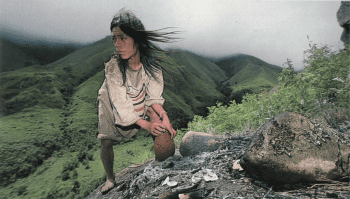
Image #54: “To make the lime alkali, the Kogi trade cattle for Caribbean seashells, which they fire and crush.” “COCA: An Ancient Indian Herb Turns Deadly”, National Geographic magazine, January 1989, p. 13
“Coca has 14 natural alkaloids: Cocaine: It is the metal ester of benzoyl egnonine, it has anesthetic and analgesic properties. Egnonine: It is a carboxylated derivative of atropine, it has properties to metabolize fats and carbohydrates, and to thin the blood. Pectin: It is absorbent and antidiarrheal, together with vitamin E, it regulates the production of melanin for the skin. Papain: This protease (which in greater proportion is contained in papaya) is very similar in structure to animal cathepsin, it is a ferment that accelerates digestion. Hygrine: It excites the salivary glands when there is oxygen deficiency in the environment. Globulin: It is a cardiotonic that regulates the lack of oxygen in the environment, improving blood circulation, prevents “soroche” (altitude sickness) Pyridine: Accelerates the formation and functioning of the brain, increases blood supply to the pituitary and glands. Quinoline: Prevents tooth decay along with phosphorus and calcium. Conina: anesthetic. Cocamine: pain reliever. Reserpine: Regulates blood pressure in hypo and hypertension and helps the formation of bone cells. Benzoin: Therapeutic properties for gastritis and ulcers. Inulin: Refreshes and improves the functioning of the liver, the secretion of bile and its accumulation in the gallbladder, it is a diuretic, it helps to eliminate harmful and non-physiological toxic substances. Atropine. These 14 alkaloids, the amino acids they contain, the acids and vitamins A, B1, C and E, thiamine, niacin and riboflavin, make it the most complete plant in non-protein nitrogen, which is the one that eliminates toxins and pathologies of the human body and provides two properties of solubility and hydration, obtaining optimal combinations with medicinal fruits (Asociación Shamánica y Ecológica de Colombia, 1998).” (70)

Image #55: “Kogi men with poporos”, wikipedia.org: Kogi people
The one alkaloid mentioned above that wasn’t followed by a summary of possible beneficial effects was atropine. According to Wikipedia, atropine is “used to treat certain types of nerve agent and pesticide poisonings as well as some types of slow heart rate, and to decrease saliva production during surgery.” (71)

Image #56: Exhibit, Coca Museum of Cusco, Peru. Photo from Google Maps.
Many of the alkaloids found in coca tea have not been fully researched (72) – at least not by those who use the English language – in part due to the fact that they are non-proprietary herbal medicines, which we see, over and over again, that the medical establishment has no desire to investigate. (73) Yet understanding what these alkaloids do would have enormous benefits for humanity. There is some evidence that one of the alkaloids – cuskohygrine – survives the de-cocainization process and makes it into Coca Cola. (74) Its effect on the drinker is unclear.

Image #57: Ad for Coca Cola, circa 1897. Image from thedrinksbusiness.com
There is also some indication that coca leaves – or cocaine – combined with alcohol creates a separate euphoriant called “cocaethylene” (75) which might explain the popularity of Vin Mariani, and might also serve to become a cheap, relatively safe and effective antidepressant (when used properly and in moderation).

Image #58: Ad for Vin Mariani, 1893. Image from thedrinksbusiness.com
While the effects of isolated coca leaf alkaloids have not been fully researched, the effects of the coca leaf on human physiology has had more attention. (76) The following summary of effects on the body was already familiar to at least some in the medical community by the 1970s;
“Aside from its ability to clear the mind, elevate mood, and make energy available, it appears to exert good influences on many physical functions. For example, it tones and strengthens the entire digestive tract, probably enhancing the assimilation of foods. A hot-water infusion of coca sweetened with a little raw sugar (called agua de coca) is an excellent remedy for indigestion and stomach-ache that was widely used even by non-Indians throughout South America until relatively recently. Coca appears to maintain the teeth and gums in a good state of health; it keeps teeth white. The leaf is rich in vitamins, particularly thiamine, riboflavin, and C. An average daily dose of coca leaves (two ounces) supplies an Indian of the high sierra with much of his daily vitamin requirement. Coca appears to have a beneficial influence on respiration, and it is said to effect rapid cures of altitude sickness. It also rids the blood of toxic metabolites, especially uric acid. Indians say that regular use of coca promotes longevity as well . . . By contrast, cocaine is much less pleasant to consume, easily becomes associated with dependent behaviour, is not very useful, and is very hard to leave alone. Yet in our society a great many people are using cocaine, and hardly anyone has seen a coca leaf. How have we managed to create such a situation?” (77)
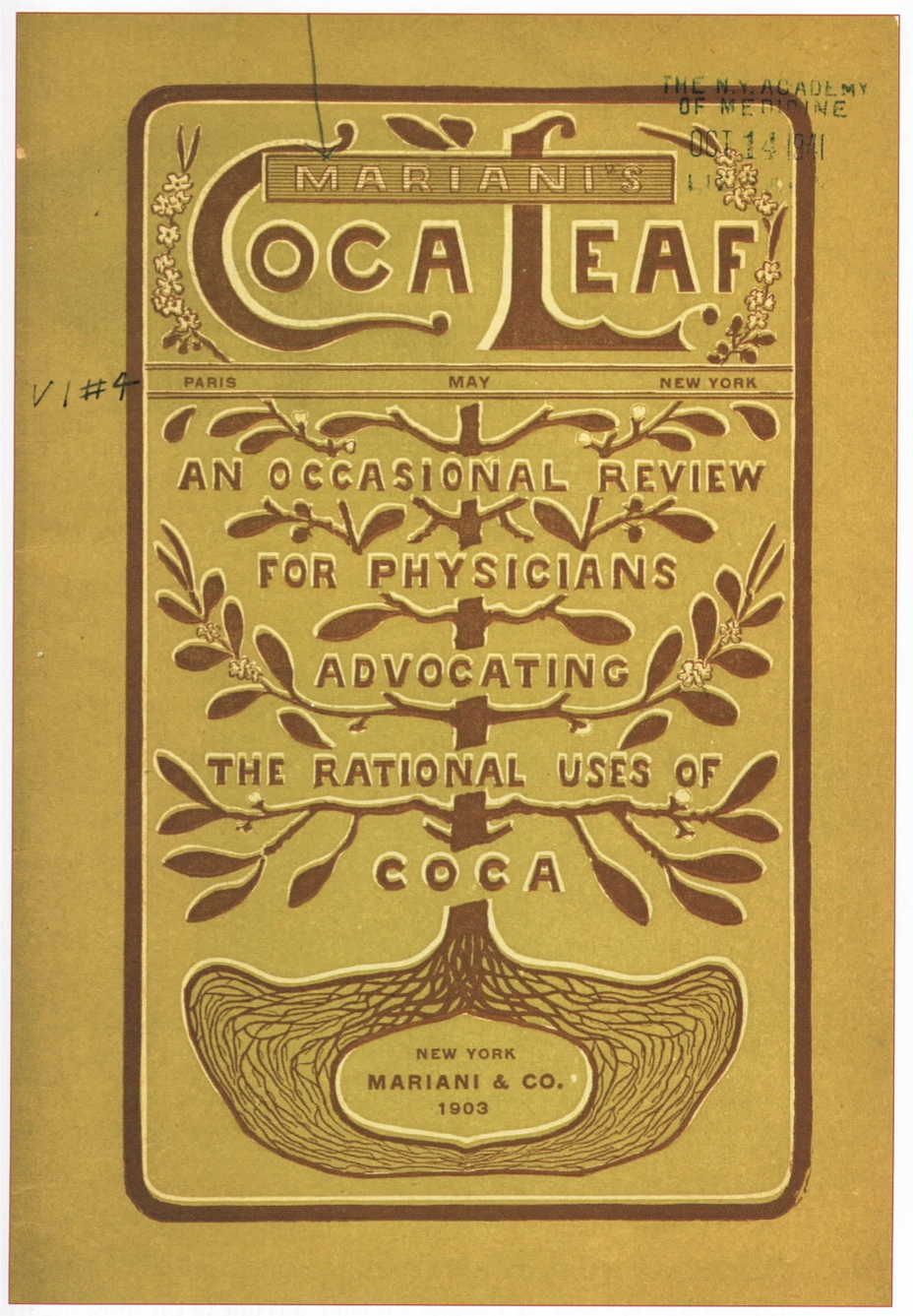
Image #59: Mariani’s Coca Leaf, 1903. Coca Wine, Aymon De Lestrange, 2016, p. 63
In addition to this, there is some evidence of coca being used to combat influenza, (78) and even a sore throat. (79) In fact, coca seems to be somewhat of a panacea. According to Angelo Mariani in his 1892 tract: Coca and its therapeutic application, coca;
“. . . prolongs life and promotes muscular energy. He advises its use, locally, for stomatitis, gingivitis, aphthous ulceration, and generally for painful and difficult digestion, gastric disturbance in phthisis, and also for obesity.” (80)
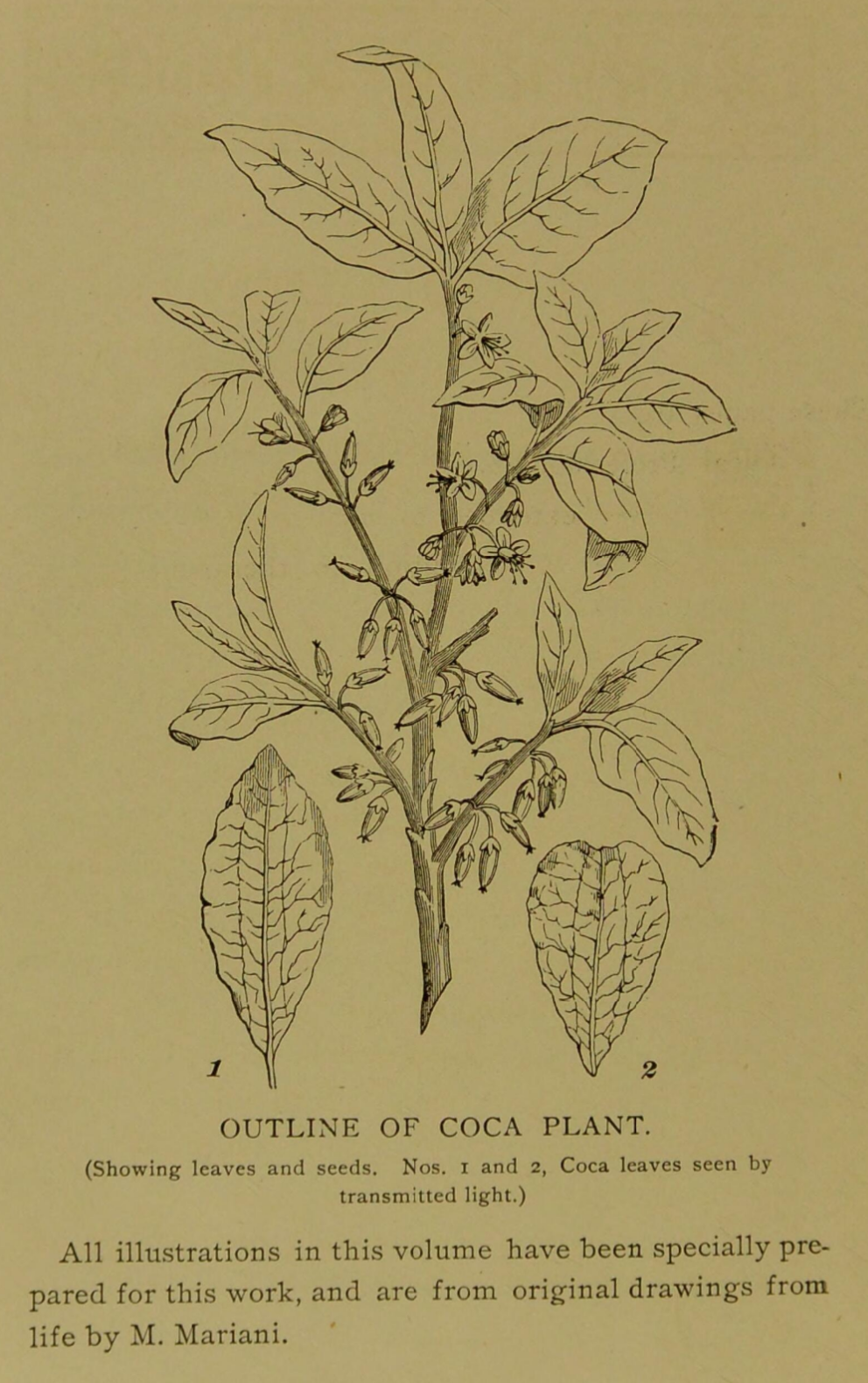
Image #60: Angelo Mariani, Coca and its therapeutic application, p. 4, online at wellcomecollection.org
“Stomatitis” is a fancy word for “sore mouth”, an “aphthous ulceration” is more commonly called a “canker sore”, and “phthisis” is either tuberculosis or something similar. This and other sources also mention coca’s use as an aphrodisiac. (81) More recently Dr. Andrew Weil summarized the medical uses of coca;
“Coca appears to be a useful treatment for various gastrointestinal ailments, motion sickness, and laryngeal fatigue. It can be an adjunct in programs of weight reduction and physical fitness and may be a fast-acting antidepressant. It is of value in treating dependence on stronger stimulants. Coca regulates carbohydrate metabolism in a unique way and may provide a new therapeutic approach to hypoglycemia and diabetes mellitus. With low-dose, chronic administration it appears to normalize body functions. In leaf form coca does not produce toxicity or dependence. Coca can be administered as a chewing gum or lozenge containing a whole extract of the leaf, including alkaloids, natural flavors, and nutrients.” (82)

Image #61: “A Gourmet Coca Taster’s Tour of Peru”, Andrew Weil, High Times #9, May 1976, p. 44. Taken from charlienumbers.blogspot.com
Most authorities on the subject agree that coca leaves are a relatively harmless herbal stimulant – there is no evidence that coca tea is any more damaging to humans than coffee, or green tea, or herbal tea. (83) And, considering the caffeine in coffee and tea can sometimes involve a headache from withdrawal, (84) and considering the fact that low-doses of coca involve no withdrawal, (85) some might even argue – and some have argued – that coca is a superior stimulant to coffee and tea, in that it doesn’t cause headaches, it keeps the head clear and uncongested, is beneficial to the stomach, and improves circulation. (86)
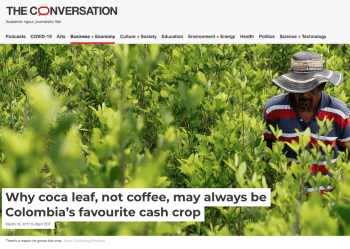
Image #62: theconversation.com
In addition, while cases of caffeine abuse (87) and caffeine poisoning (88) and overuse deaths (89) and overdose deaths (90) are on record, there are zero cases of coca leaf abuse or over-use deaths or overdose deaths or poisoning of any kind on record. (91) I suppose one could possibly misuse coca tea by drinking it before going to sleep, which might prevent one from sleeping. The cure for this form of abuse is simple – avoid drinking coca tea at least six hours before bedtime. Easy peasy.

Image #63: insider.com
One might reasonably argue that we are comparing apples with oranges – that caffeine is an extract, whereas coca leaf is a non-problematic herb. My reply is, of course, that caffeine-containing herbs like coffee beans and tea leaves are also minimally problematic, and that there are regulations and guidance issued by the FDA and Health Canada that control concentrated caffeine-powder or caffeine-pill products or educate consumers in order to keep abuse to a minimum. (92)
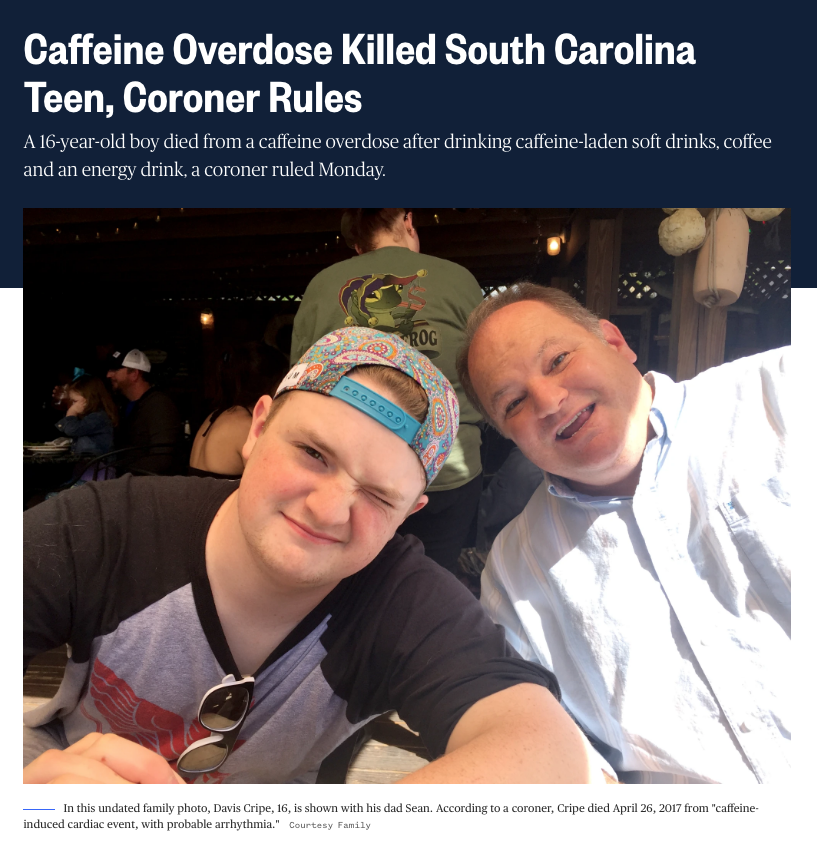
Image #64: nbcnews.com
Such measures might also work for cocaine – at the very least, it might work better than the current system of allowing the CIA or their proxies to bring billions of dollars worth of cocaine in on military cargo planes every year, have the authorities look the other way, and have black market distributors cut it with whatever and sell it to whomever, with zero harm-reduction information available to the customers. In fact, the minimal education our society provides to prevent caffeine abuse may very well be improved upon, if we took a small fraction of the massive resources currently available for prohibition enforcement and instead used it for the creation of genuine, realistic, robust, stimulating, engaging and easily accessible harm-reduction education from drug educators, so that the abuse of caffeine, and cocaine, and alcohol, and all the other drugs could be truly minimized.
The Use and Abuse of Cocaine
“Medicinally employed, cocaine in appropriate dosage is a stimulant that is not only harmless, but usually phenomenally beneficial when indicated.”
- Golden Mortimer, M.D., Peru – History Of Coca – “The Divine Plant” Of The Incas, 1901 (93)
“Hey baby, you better come here quick
This old cocaine is making me sick
Cocaine, all around my brain
Cocaine’s for horses and it’s not for men
Doctor said it kill you, but he don’t say when
Cocaine, all around my brain”
“Cocaine”, Bob Dylan, 1962 (94)
“Crystal world with winter flowers
Turn my days to frozen hours
Lying snowblind in the sun
Will my ice age ever come?”
“Snowblind”, Black Sabbath, 1972 (95)
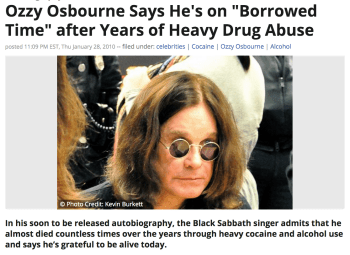
Image #64: nbcnews.com
Students of the history of cocaine end up with two opposite impressions of its predictable effects. From a series of authors, scientists and criminals from the late 1800s to the early 1900s we have dozens of testimonies to its benefits, and then from jazz musicians in the 1920s and 1930s and rock & rollers in the 1960s and 1970s we have dozens of warnings of the negative effects of excessive use. The key in understanding the difference between cocaine use and cocaine abuse is certainly understanding the predictable effects of different doses.
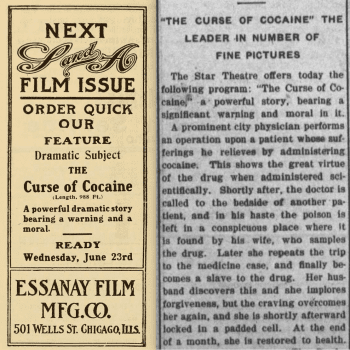
Image #66: “Curse of Cocaine” from moviessilently.com and “STAR OFFERS FINE PROGRAM”, Daily Republican-Register, Mount Carmel, Illinois, August 4th, 1909, p. 1
As was pointed out in Mortimer’s 1901 History Of Coca, the importance of dose in the proper use of medicine has been understood for centuries;
“Linnaeus considered that a medicine differed from a poison not so much in its nature as in its dose …” (96)
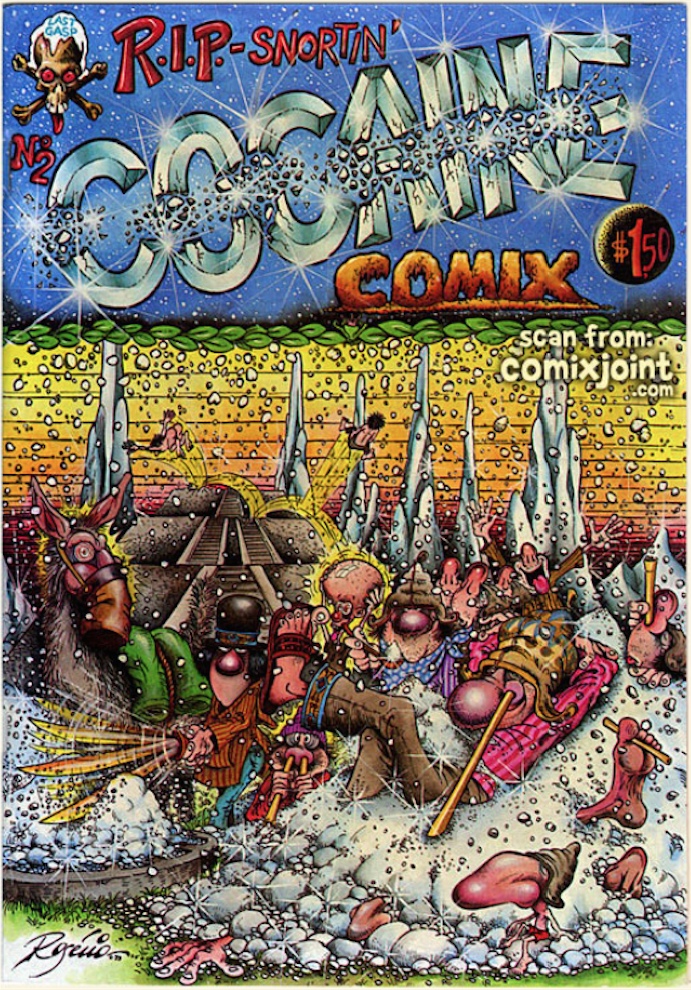
Image #67: Cocaine Comix #2, February 1981, from comixjoint.com
The importance of dose was again stressed by drug researchers of the 1970s;
“… the various alkaloids present in coca leaf- including cocaine – are both harmless and life-enhancing if taken orally and in moderation.” (my emphasis) (97)
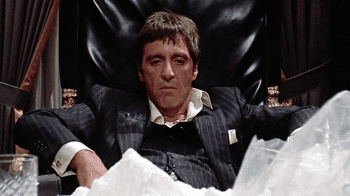
Image #68: Scarface, 1983. Image from gq-magazine.co.uk
Unfortunately, our society does not encourage moderation in practically anything. Capitalism encourages excessive, conspicuous consumption – be it drugs, or food, or consumer goods. Added to this problem is the fact that the medical establishment prefers isolated extracts that are easier to study, control and monopolize, (98) disregarding any benefits that whole-plant medicine might offer (such as built-in moderation or the synergy of multiple medical components or self-titration through smoke/vapour-based modes of administration) as being less important than commercial-related considerations. Finally, drug prohibition itself encourages the concentration of active ingredients to reduce the bulk of contraband: it’s easier to smuggle whiskey, hashish or cocaine than it is to smuggle beer, cannabis flowers or coca leaves, and it’s easier to use concentrated drugs immoderately than it is to over-use their less potent versions. (99)

Image #69: CBS 60 Minutes: The CIA’s Cocaine, NOV 21, 1993
A lesson can be drawn about the use and abuse of cocaine from the experiences of Sigmund Freud. He used it to treat his own depression, with great success. (100) Freud summarized cocaine’s other potential medical uses;
“1) As a stimulant if one wishes to do extra physical/mental work. 2) In gastric indigestion. 3) In the cachexia. 4) In combating the effects of morphine and alcohol. 5) In asthma. 6) As an aphrodisiac. 7) As a local anesthetic.” (101)
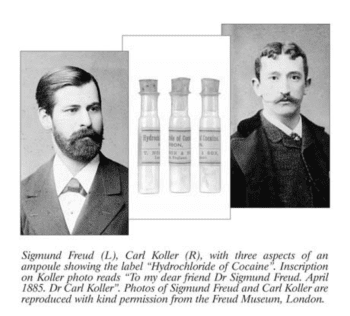
Image #70: “Local Anaesthesia – Freud, Koller and Cocaine”, from journals.sagepub.com
The definition of “cachexia” is the “weakness and wasting of the body due to severe chronic illness”. Furthermore, he began to prescribe it to everyone around him;
“Freud even sent some of his precious cocaine to Martha, ‘to make her strong and give her cheeks a red color.’ Indeed, Dr. Jones writes, ‘he pressed it on his friends and colleagues, both for themselves and their patients; he gave it to his sisters. In short, looked at from the vantage point of our present knowledge, he was rapidly becoming a public menace.’” (102)
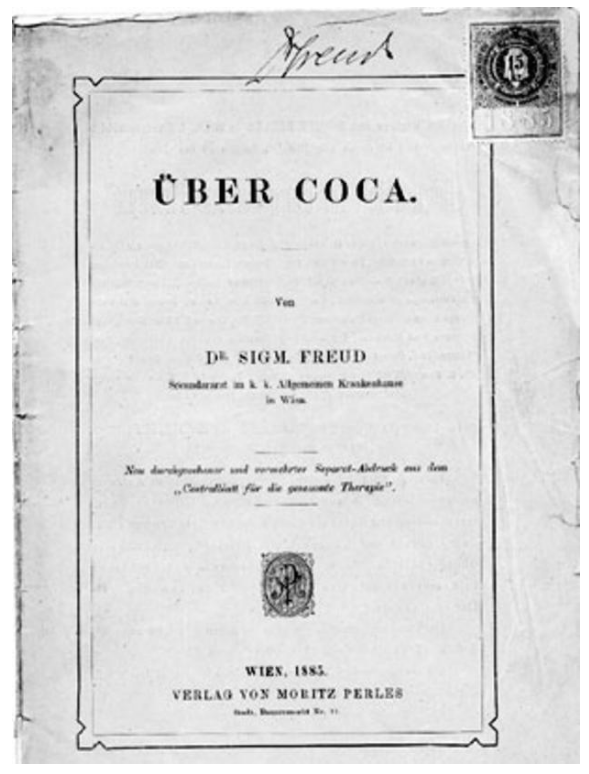
Image #71: cbsnews.com
As well as its use as an antidepressant, Freud also intended on evaluating its aphrodisiac potential by experimenting with it with his fiancée;
“In a subsequent letter to Martha, Freud wrote more on his personal experience with cocaine: ‘Woe to you, my Princess, when I come. I will kiss you quite red and feed you till you are plump. And if you are froward you shall see who is the stronger, a gentle little girl who doesn’t eat enough or a big wild man who has cocaine in his body. In my last severe depression I took coca again and a small dose lifted me to the heights in a wonderful fashion. I am just now busy collecting the literature for a song of praise to this magical substance.’” (103)
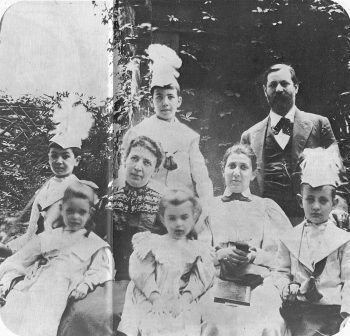
Image #72: Sigmund and Martha had six children between 1887 and 1895 – all during his cocaine-taking years. Freud family, 1898. wikipedia.org: Freud family
Freud used cocaine periodically for about three years (and occasionally for another 9 years) after which he reportedly had “no difficulty in stopping” (104) – probably due to the fact that his habit was moderate. Researchers speculate that the reason he quit was because one of his patients – Dr. von Fleischl-Marxow – who was in “excruciating pain” with “multiple tumors” and who was looking for an alternative to morphine – developed a massive cocaine habit and soon suffered from full-blown cocaine-induced psychosis. (105) The over-simplified lesson to draw from Freud’s cocaine experience: moderate use: happy, productive fuck-machine. Immoderate use: snakes under the skin.
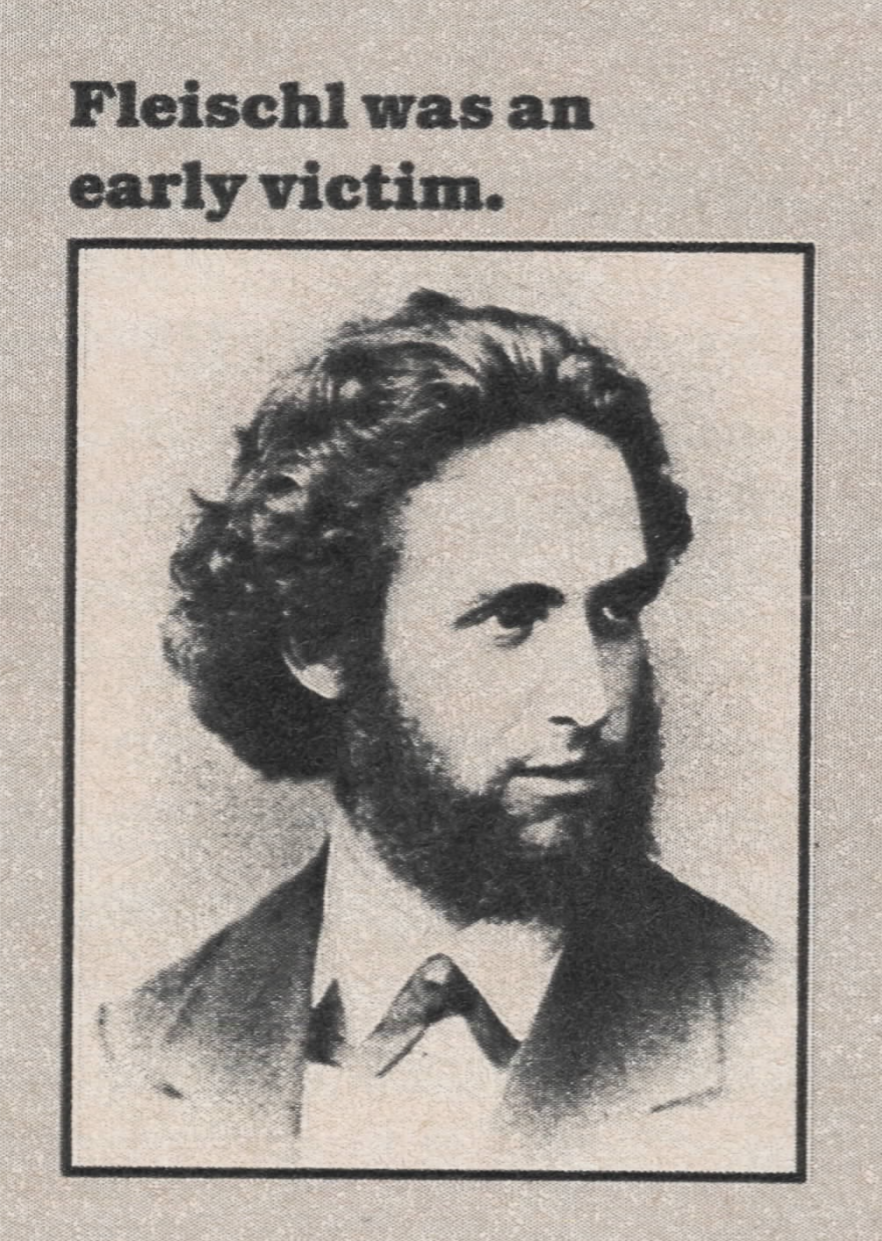
Image #73: Life Magazine, May 1984, p. 57
There are reports that in the late 1800s, one doctor would cure people’s breathing problems with a cocaine spray, but hide the identity of the therapy behind the latin name: “a solution of the erythroxylon plant” – in order to prevent patients from knowing what they were taking, and then self-administering cocaine and picking up a habit. (106)
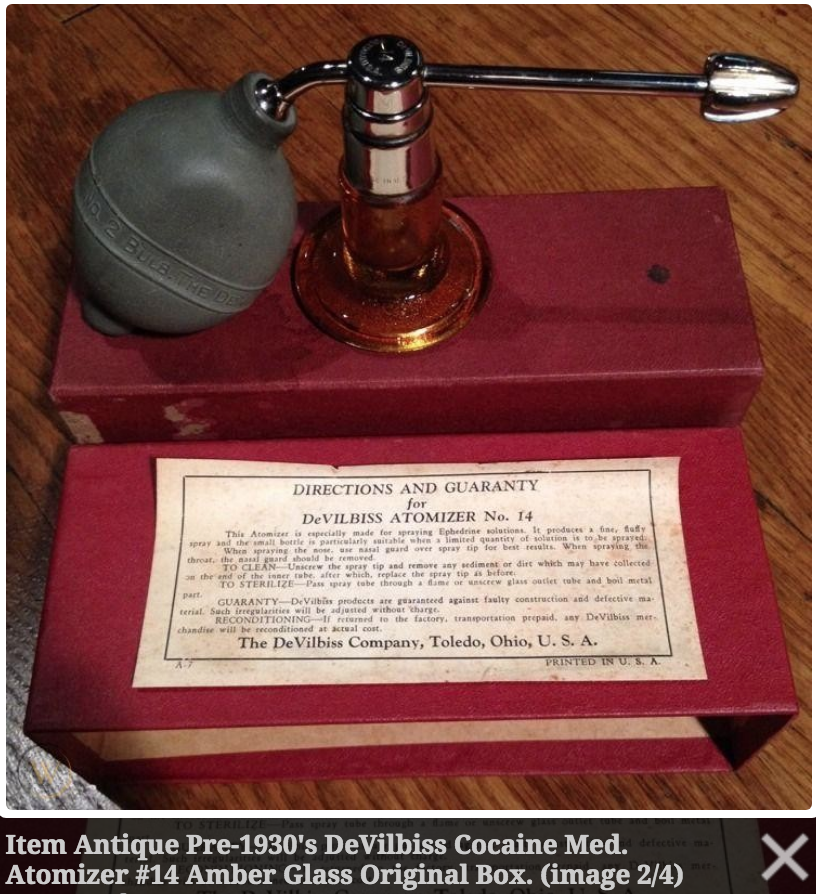
Image #74: Cocaine/Ephedrine atomizer. From worthpoint.com
There are other problems aside from cocaine-induced psychosis that arise from immoderate use. There’s the fact that cocaine floods the brain of dopamine, which results in the inability to feel happy without cocaine if you do it too many times in a row – the exact amount of time that is varies from person to person.
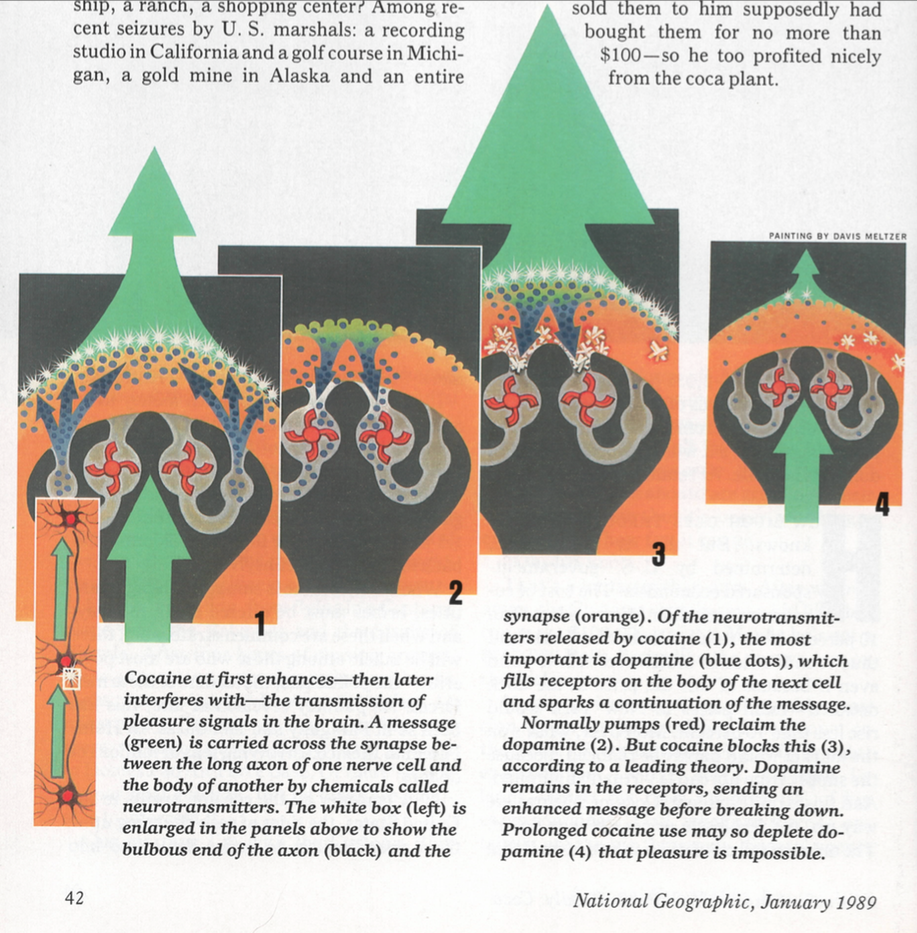
Image #75: “COCA: An Ancient Indian Herb Turns Deadly”, National Geographic magazine, January 1989, p. 42
The effects are short lived and tolerance quickly develops, which means a cocaine habit can quickly deplete one’s cash reserves and can quickly spiral out of control into excessive use if one isn’t very careful. One can get paranoid, irritable, restless, hypersensitive to stimuli, and/or aggressive from too much cocaine, even in the short term. A long-term habit can result in high blood pressure, collapsed veins and/or fast or irregular heartbeats. Nosebleeds and/or deviated septums can result from not keeping one’s nose moisturized, and diseases and infections can result from improper use of needles. And then there’s death from overdose or a cocaine-induced heart attack. (107)

Image #76: yonkerstimes.com
According to cocaine aficionados, the best way to quit cocaine is abruptly, because the physical withdrawal symptoms are so mild – “less severe than breaking a caffeine habit.” (108) The psychological withdrawal symptoms are more severe, (109) requiring some users to use herbal tools such as cannabis, (110) the non-proprietary health-food supplement n-acetyl cysteine or “NAC”, (111) or the herbally derived craving-interrupter ibogaine (112) to mitigate the extreme psychological dependence. Some people can take long breaks with no problem – other people need help.

Image #77: herbmuseum.ca
There is a double standard upon non-proprietary medicine made evident from the medical establishment: botanical medicines – even the extracts from botanical medicines such as cocaine – are not allowed to be palliative – not allowed to provide relief rather than outright cures – but synthetic medicines are. An example of this can be seen in this excerpt from the 1980 book Cocaine: The Mystique and the Reality, by Joel Phillips and Ronald Wynne;
“In fact, cocaine, in the form of cocaine-laced tonics and elixirs, provided few or no medicinal benefits in treating any of these illnesses. It did act as a stimulant and euphoriant; sufferers would at least feel better, even though the illness itself was not being treated.” (113)
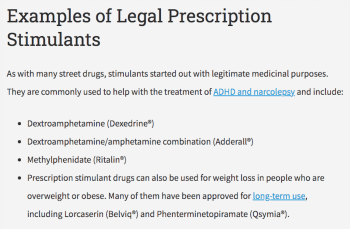
Image #78: pinnacletreatment.com
Does a legal, prescribed synthetic stimulant treat the underlying conditions that leads to fatigue – conditions such as a chronic disease or perhaps being exploited and over-worked by a merciless employer? Does a legal, prescribed synthetic antidepressant treat the underlying condition that leads to depression – conditions such as suffering from a broken heart, or systemic oppression, or discrimination from institutional racism or institutional sexism, or the feeling of impending doom from imminent climate collapse? How the quality of the cocaine-derived stimulation or euphoria differs from the quality of stimulation or euphoria from synthetic medicine is beyond my ability to understand. The only real difference between the two is that synthetics can be patented but you can’t patent a plant extract so some of the cocaine money goes to South American farmers rather than chemical companies.
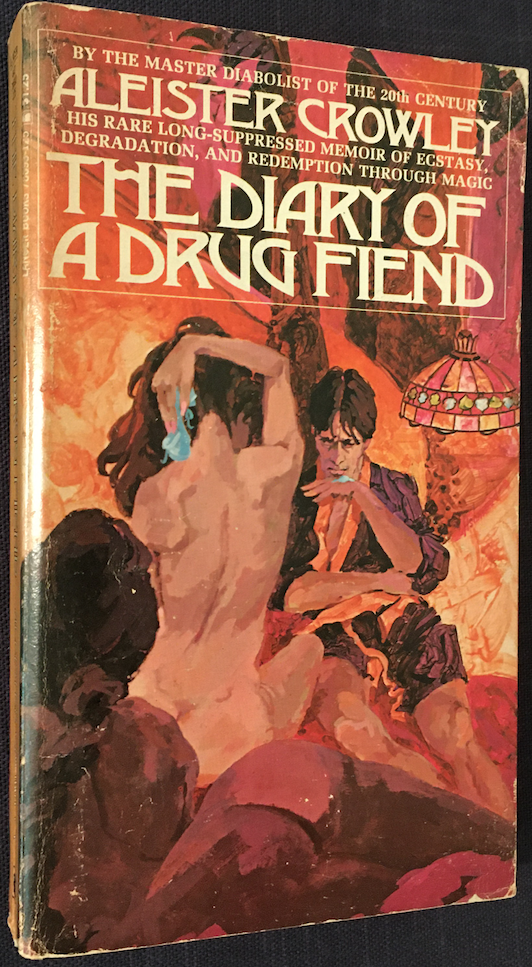
Image #79: iberlibro.com
The demand for cocaine will never ever disappear, because of its reputation as an aphrodisiac. Take, for example, this ringing endorsement from Aleister Crowley, taken from his 1922 semi-cautionary tale Diary of a Drug Fiend;
“Until you get your mouth full of cocaine, you don’t know what kissing is. One kiss goes on from phase to phase like one of those novels by Balzac and Zola and Romain Rolland and D. H. Lawrence and those chaps. And you never get tired! You’re on fourth speed all the time, and the engine purrs like a kitten, a big white kitten with the stars in its whiskers. And it’s always different and always the same, and it never stops, and you go insane, and you stay insane, and you probably don’t know what I’m talking about, and I don’t care a bit, and I’m awfully sorry for you, and you can find out any minute you like by the simple process of getting a girl like Lou and a lot of cocaine. What did that fellow Lamus say? ‘Stab your demoniac smile to my brain, Soak me in cognac, kisses, cocaine.’” (114)

Image #80: The Wolf of Wall Street, 2013
This reputation for cocaine being an aphrodisiac has been solidified through dozens of similar works of fiction, and word-of-mouth, and Hollywood movies such as the 2013 blockbuster The Wolf Of Wall Street, where it appears repeatedly during various sex scenes.

Image #81: The Wolf of Wall Street, 2013
The demand for any drug with such a reputation for enhancing the sexual experience can never be – nor should ever be – eradicated. We must learn to create rituals of moderation and respect instead, and embrace cocaine as a special once-per-year treat for adults with strong hearts rather than something that either needs to be eliminated entirely or that can be regularly consumed without any problems whatsoever. And if grown-ups want to use more often than once per year, they should have access to low-dose cocaine beverages or cannabis as recommended substitutes, as well as plenty of education regarding the hazards of immoderate use, and then allow people to decide what to do with their own lives and their own bodies. The benefits of medical autonomy (combined with robust education) outweigh the drawbacks, and the downside of society denying medical autonomy is far worse than the downside of society accepting it.
The Demonization and Stigmatization of Coca and Cocaine
“The cases of cocaine poisoning and addiction often sensationally reported are even open to grave doubt.”
- Golden Mortimer, M.D., Peru – History Of Coca – “The Divine Plant” Of The Incas, 1901 (115)
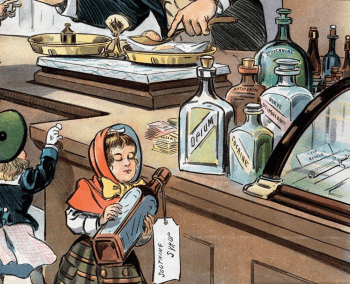
Image #82: Detail, “The Age Of Drugs”, by Louis Dalrymple, Puck magazine, October 1900. Image from clickamericana.com
The very real potential to abuse drugs justifies certain types of drug warnings and drug education requirements as a criteria for legal access. Even new types of drug rituals and drug-using role models could encourage proper drug use. But drug prohibitions stem from something other than concern over drug abuse. In spite of stated pretexts regarding the health and well-being of drug users, drug prohibitions are actually created out of a desire to a) scapegoat, control, exploit or eradicate certain populations of drug users, and/or b) monopolize the sale of inferior substitutes of the drug being prohibited.
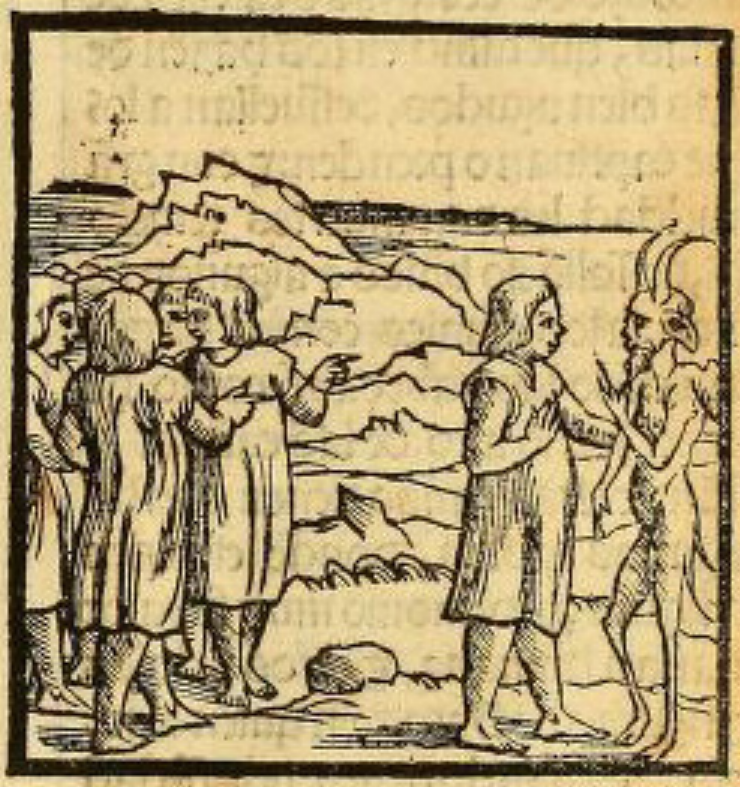
Image #83: “The viewpoint of the Spaniards: The indigenous people communicate with the Devil (Cieza de León 1553 Chronica del Peru, fol. 17r) From the copy of the John Carter Brown Library, Providence, Rhode Island, USA.” From dedenbachsalazar.stir.ac.uk
An example of the former can be found in the early history of the conquest of South America by Spain. By 1569, the Church Council had ordered the elimination of the coca plant due to its “satanic powers”. (116) The following passage is an example of the demonization of coca and coca users by the Spanish as a way to both explain its medical properties and as an excuse to subjugate indigenous people – to “save them” from demonic influence;
“Europe apparently received its first scientific account of coca from Nicolas Monardes in 1565, but Monarde’s work is clearly based on that of Pedro Cieza de Leon, a young man who had taken part in the campaign which brought the Inca Empire under Spanish Rule. Cieza arrived in South America in 1532, when he was fourteen years of age, and remained in the Andes region until 1550. His Chronica del Peru, published in 1550 or 1553, records the history of the Incas and gives accurate descriptions of coca and how the Indians used it. He did not, however, believe in the efficacy of coca – attributing the great feats of endurance performed by the Indians not to the coca they chewed but to the pact they had with the Devil. He goes so far as to say that ‘the old men of every tribe actually conversed with the arch-enemy of mankind.’ Cieza’s accurate account of the use of coca coupled with his unwillingness to believe the plant had any special virtues is a typical example of the acute observer who, when the time for assessment comes, allows his prejudice to overpower his common sense. And prejudice is a sturdy beast. Writing almost 250 years after Cieza, Dr. Henry Barkham remarks in his Hortus Americanus, ‘This herb is famous in the history of Peru, the Indians fancying it adds much to their strength … They apply it to so many uses, most of them bad, that the Spaniards prohibit the use of it, for they believe it hath none of these effects, but attribute what is done to the compact the Indians have with the devil.’ And some 150 years later still, one William Hodge, a professor of botany, exhibits like ignorance: ‘Ever since the accounts of the chroniclers, it has been generally thought that the chewing of coca gives ‘extra strength’ to its addicts and dispels fatigue. The sierra Indian will undertake a long, arduous trip without a single thought of food, but never will he start without a full bag of coca. He believes that coca chewing supplies the energy needed for accomplishing the normal day’s work on the precipitous 12,000-foot trails of the high Andes …’ (emphasis added). Ahh, those poor ignorant Indians – to labor so hard, sustained by nothing more than delusion.” (117)
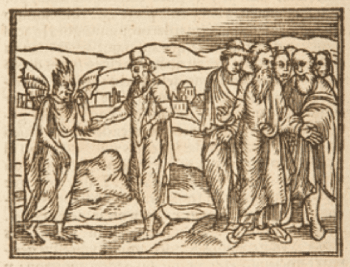
Image #84: Cieza de León, 1553, Chronica del Peru. From williamreesecompany.com
Here we see how the demonization of coca from the mid 1500s through to the late 1700s evolved into a simple, racist stigmatization by the 1900s.
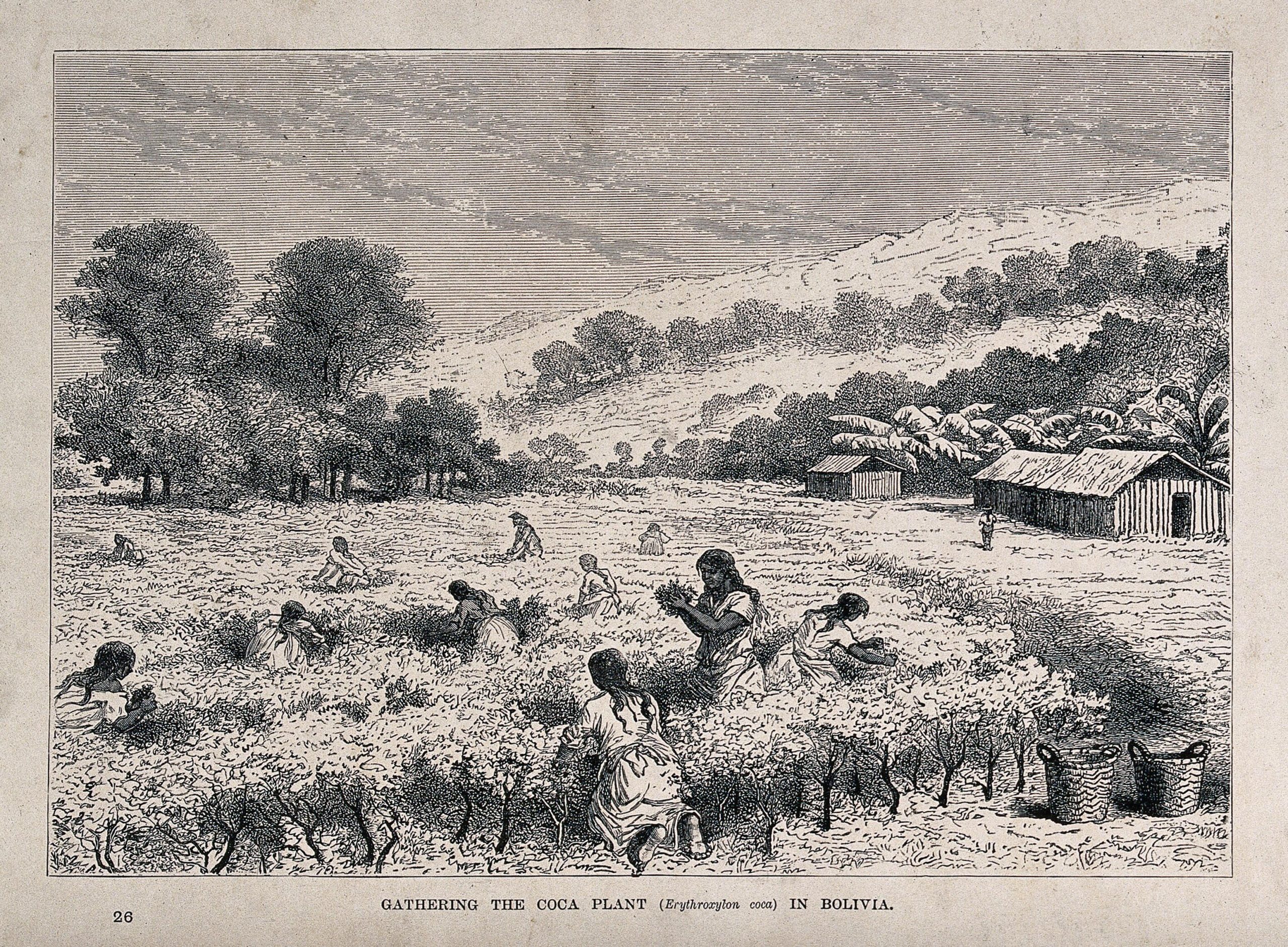
Image #85: “GATHERING THE COCA PLANT (Erythroxylon coca) IN BOLIVIA”, Wood engraving, c. 1867. Bates, Henry Walter, 1825-1892. From wellcomecollection.org
Yet another parallel between coca and cannabis is the fact that former coca prohibitionists transformed themselves into coca suppliers, or more accurately coca monopolists – just like cops and politicians in Canada have created a pot cartel for themselves, when only a few years ago they were totally against legalization;
“Despite coca leaves being highly prized by the indigenous peoples, Spaniards deemed the plant unworthy or a ‘savage means of intoxication’. The newcomers’ abhorrence of the custom became even stronger with time so that in ‘1569 the Spanish audience in Lima, composed of bishops of all parts of South America, denounced coca, because, as they asserted, it was a pernicious leaf, the chewing of which the Indians supposed gave them strength’. However, coca survived this early bitter persecution despite the cruel treatment of the people who regarded it as sacred. Eventually, those who orchestrated this war against coca profited not only by owning coca plantations but also by trading it to mining centers such as Potosi; the coca trade became so lucrative that it was second only to brandy.” (118)
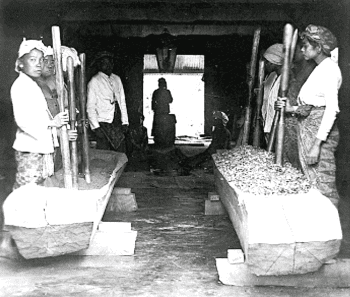
Image #86: “Workers in Java prepared coca leaves. This product was mainly traded in Amsterdam, and was further processed into cocaine. (Dutch East Indies, before 1940.)” From wikipedia.org: coca
As for the other impetus for prohibition – a monopoly over inferior substitutes – early examples can also be found. As was pointed out by a coca historian 120 years ago, the same scam has been tried on nearly every drug;
“Tea, coffee and chocolate have each been denounced, and from very high sources too. ‘A lover of his country,’ as he designated himself, in 1673, proposed to Parliament ‘the prohibition of brandy, rum, coffee, chocolate and tea, and the suppressing of coffee houses. These hinder greatly the consumption of barley, malt and wheat, the product of our land.’ Here would seem to be an ulterior motive that is almost suggestive of the commercial spirit often now displayed, which would suppress one product that another may be permitted to flourish regardless of merit.” (119)

Image #87: “By the King. A PROCLAMATION FOR THE Suppression of Coffee-Houses.” Charles II, 1675. From guernseydonkey.com
Both the enslavement of people and the monopoly of coca – or the prohibition of coca to favour the sale of other stimulants – stem from greed. It’s a type of greed that most of the European conquerors were unable to admit existed, so instead rationales were invented. The initial rationale involved the devil. Because – from the age of superstition right through to the age of science – the subjugation survived (with actual slavery transforming into wage slavery), the superstitious rationales evolved into scientific rationales.

Image #88: boredpanda.com
It is only relatively recently that anyone in the academic world has even taken notice of the enslavement aspect of coca prohibition;
“The recent attempts to suppress and control the use of coca can be interpreted only as the latest step in the white man’s attempt to exterminate the Indian way of life and make him completely dependent on the alien society and economy which has gradually surrounded him. Henri Lehmann has very accurately stated the severity of the problem in the conclusion to his paper, ‘The Suppression of the Sale of Coca in Columbia’: ‘The prohibition of the sale of coca is a step forward in the Indians’ dependence, it is a step toward his complete enslavement. It is the duty of all the Indian Institutes to interfere in the policy of their administrations to the end that such steps shall not be taken, before it is too late. For several years now, the fight against the Indians has taken new forms. With the pretext of liberating the Indian, for example, many communal lands were dissolved, which has permitted the whites to buy up Indian lands and evict the natives. The fight against coca by means of such methods as we have here described, has turned upon the very people it is trying to safeguard.’” (120)

Image #89: “INCANS GATHERING COCA.” & “COCA PICKERS” After De Bry, 1600. W. Golden Mortimer, M.D., Peru – History Of Coca – “The Divine Plant” Of The Incas, 1901, pp. 152, 173
The prohibition – and subsequent cartelization – of the coca economy helped the white man to enslave non-whites in South America, just as the prohibition of cocaine helped the white man enslave non-whites in North America. The 13th Amendment (coming a mere six years after the invention of cocaine) – a product of the Union victory over the pro-slavery Confederate States during the American Civil War – outlawed slavery “except as a punishment for crime whereof the party shall have been duly convicted …” (121) Cocaine prohibition helped to create more slaves, in the form of prison labourers. As the hip-hop artist Killer Mike recently pointed out;
“They declared the war on drugs, like a war on terror. But what it really did was let the police terrorize whoever . . . ‘Cause slavery was abolished, unless you are in prison. You think I am bullshittin’, then read the 13th Amendment. Involuntary servitude and slavery it prohibits. That’s why they givin’ offenders time in double digits.” (122)

Image #90: “Reagan”, Killer Mike, 2012. Image from youtube.com
Of course, it wasn’t “the devil” that U.S. whites used as a pretext to enslave African Americans. It was the myth of the coked-up black rapist or murderer;
“However cocaine use started among Southern blacks, articles began to appear on the subject expressing more than a little concern. In 1898, the Medical News carried a story which especially associated cocaine abuse with Southern blacks. In 1900 an editorial in the Journal of the American Medical Association told its readers: ‘The Negroes in some parts of the South are reported as being addicted to a new form of vice – that of cocaine ‘sniffing’ or the ‘coke habit’!’ By 1902 enough attention had been given [to] the subject that the British Medical Journal printed a piece entitled, ‘The Cocaine Habit Among Negroes,’ in which it was revealed that ‘On many Yazoo plantations this year the Negroes refused to work unless they could be assured that there was some place in the neighborhood where they could get cocaine, and it is said that some planters kept the drug in stock among the plantation supplies and issued regular rations of cocaine just as they used to issue regular rations of whiskey.’ This use of cocaine by Southern blacks coincided with that period when the white South was in the last stages of dismantling the remnants of Reconstruction. Legal segregation, voting laws shaped to deprive blacks of any share in the political process, and lynchings to impress them of the realities of life in the South, were all at their peak during the last decade of the nineteenth century. Quite naturally, the whites responsible for these actions were a bit uneasy, and there uneasiness was not lessened by the generally held belief that cocaine would act as a ‘spur to violence against whites.’ . . . Newspaper articles appeared linking cocaine with black violence. In 1903, the New York Tribute printed a statement by one Colonel Watson of Georgia alerting the country to the dangers of allowing blacks to use cocaine. According to him, Atlanta was a hotbed of black ‘coke’ use and he urged that legal action be taken to stop the sale of Coca-Cola. (The company responded by voluntarily eliminating cocaine from the drink that same year.) The colonel was convinced that “many of the horrible crimes committed in the Southern States by the colored people can be traced directly to the cocaine habit. This ploy, the association of cocaine with crimes allegedly committed by blacks, became immensely popular . . . The equating of blacks and cocaine with crime was so firmly established by 1910 that when Dr. Christopher Koch, the leader of a Philadelphia crusade against the drug, in testimony before a congressional committee holding hearings on the possibility of drafting a federal anti-narcotics law, pointed out the dangers the country faced at the hands of cocaine-crazed Southern blacks, his testimony went unchallenged. Dr. Koch was later quoted as asserting that “Most of the attacks upon white women of the South are the direct result of a cocaine-crazed Negro brain,” a piece of nonsense which, so far as I can determine, also went unchallenged. But by this time the chance of common sense’s intervening and asserting facts about the effects of cocaine couldn’t be said to exist. Once the equation blacks plus cocaine equals raped white women, had taken hold in the national consciousness and the deepest sexual fears of white America stirred, any argument likely to aid in the total outlawing of cocaine was both believed and welcomed.” (123)

Image #91: THE CASE OF The DOPE DEALERS, THE SEXTON BLAKE LIBRARY, NO. 270, Martin Frazer, Image from mark-hodder.com
As drug historian Dr. David Musto pointed out back in 1986, “cocaine justified the oppression that was already under way” (124) – one could even argue it was a new way of justifying an old oppression that had existed since the first slaves were worked to death by their European masters at the beginning of the 1500s. (125)
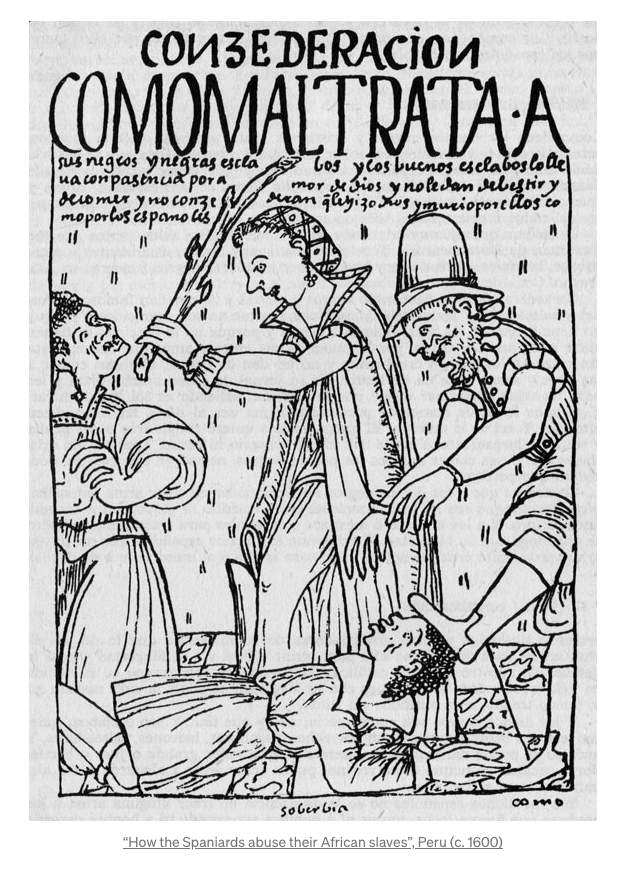
Image #92: “How the Spaniards abuse their African slaves”, Peru, circa 1600. Image from limerick1914.medium.com
A closer examination of the tactics of the establishment media is instructive. Every depiction of every illegal drug – opium, cocaine, cannabis or otherwise – is a depiction of abusive use, and beneficial use is seen as an impossibility. This strategy hasn’t changed much in over a hundred years – today’s newspapers and network television broadcasts are filled with the same type of story, even around relatively harmless drugs like cannabis. Added to this tactic were the tactics of xenophobic stereotypes and parental hysteria – also used today quite frequently to justify various drug prohibitions or drug cartels.
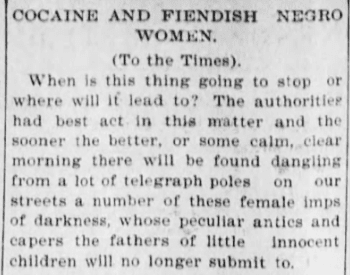
Image #93: “COCAINE AND FIENDISH NEGRO WOMEN.”, The Times, Shreveport, Louisiana, September 9th, 1896, p. 8
For example, an 1896 headline from a Louisiana newspaper: “COCAINE AND FIENDISH NEGRO WOMEN.” There was no mention of cocaine in the body of the text. It was a letter to the editor, from “A Father”, threatening to lynch some black women who supposedly assaulted white girls on the street. The cocaine use was implied both as an explanation for the bad behaviour of the scapegoated community in question, and as a justification for murder and terrorism on the part of the scapegoater. (126) A year later, another Louisiana newspaper justified harsh punishment in court because the targets were “a couple of negro cocaine fiends”. (127)

Image #94: The Shreveport Journal, Shreveport, Louisiana, December 10th, 1897, p. 4
A story from an Indiana newspaper from 1898 titled “Cocaine Fiends” blamed the poverty the black community suffered from on use of the drug;
“Tintown, a suburb, is the home of a colony of Negro cocaine-users. They live in squalid huts, without regard for sex and family. Most of the time they are under the influence of the drug, and none of them was ever known to work. Just how they live is a mystery.” (128)

Image #95: “COCAINE HABIT IS INCREASING,” The Brooklyn Citizen, Brooklyn, New York, December 18th, 1898, p. 34
Once in a while, the scapegoaters added some actual demonization to their stigmatization, just to maximize the hysteria;
“It is the very devil himself in the form of an innocent-looking crystal, and the way the much-to-be-pitied cocaine user is dragged slowly but with awful certainty down to insanity and death is a terrible tribute to the strength of the demon that lurks in the drug.” (129)
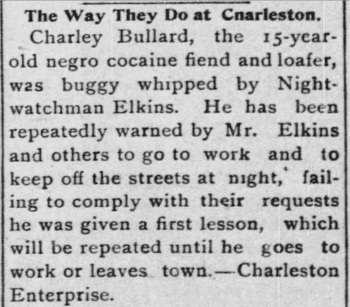
Image #96: “The Way They Do at Charleston”, The Democrat-News, Fredericktown, Missouri, May 27th, 1899, p. 3
The newspapers would use the term “cocaine fiend” anytime an assault on an African American needed justification – even if it was a child (130), usually for such crimes as “vagrancy” (homelessness) or “disturbing the peace” (offending the white community with one’s existence) (131) – often with banishment as a prerequisite to avoid further assaults and/or more jail time.
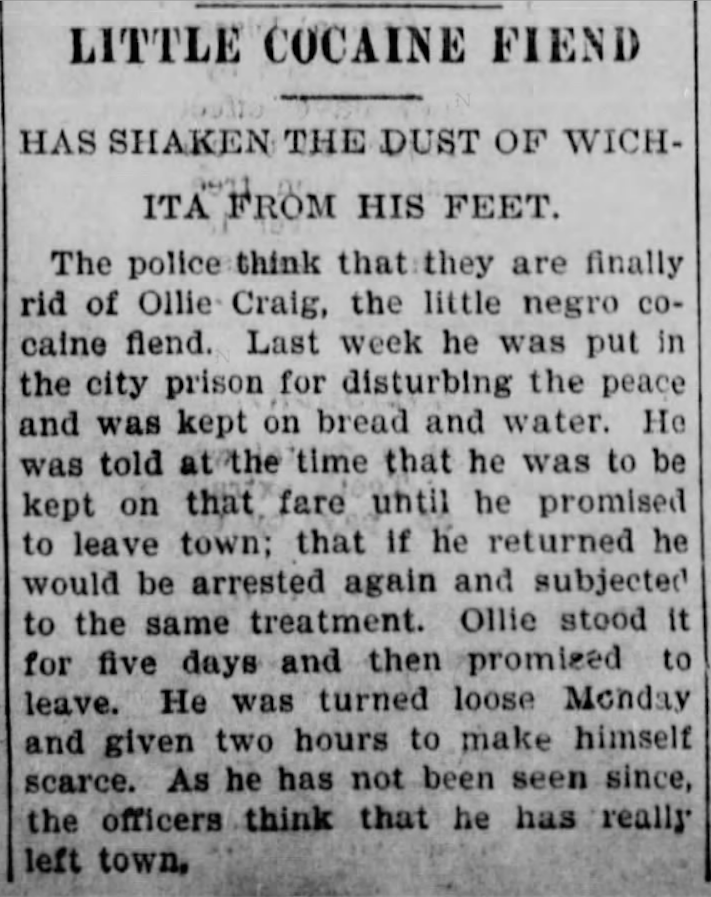
Image #97: “LITTLE COCAINE FIEND”, The Wichita Beacon, Wichita, Kansas, June 15th, 1899, p. 6
The term “negro cocaine fiend” was even used as an explanation for the ongoing African American genocide – a cover for the predictable, genocidal consequences of the lynchings, the effects of poverty from a racist economic system, and the effects of a racist media, racial profiling from the police, and a racist justice system;
“Another and a most deplorable thing that is militating against the negroes is the cocaine habit. This habit is a new acquisition and no greater course could have fallen upon this simple people than this will prove to be. Two years ago a negro cocaine fiend was almost an unknown quality. To-day each city has its horde. As yet the habit has not reached the country negro, but his brother of the city knows the drug well. Unless something is done to break up the custom one more nail will be driven into the national negroid coffin. . . The likelihood of this disappearance carries no joy to the hearts of the southern whites. They do not want and will not have negro domination or any racial trouble, but neither do they wish to bid good-bye to the race beside whom they have lived so long and with whom the traditions of their country are so closely woven. They see the Indians dying out without any special regret; they will not watch unmoved the fading of this other people who have shared so closely their domestic lives.” (132)
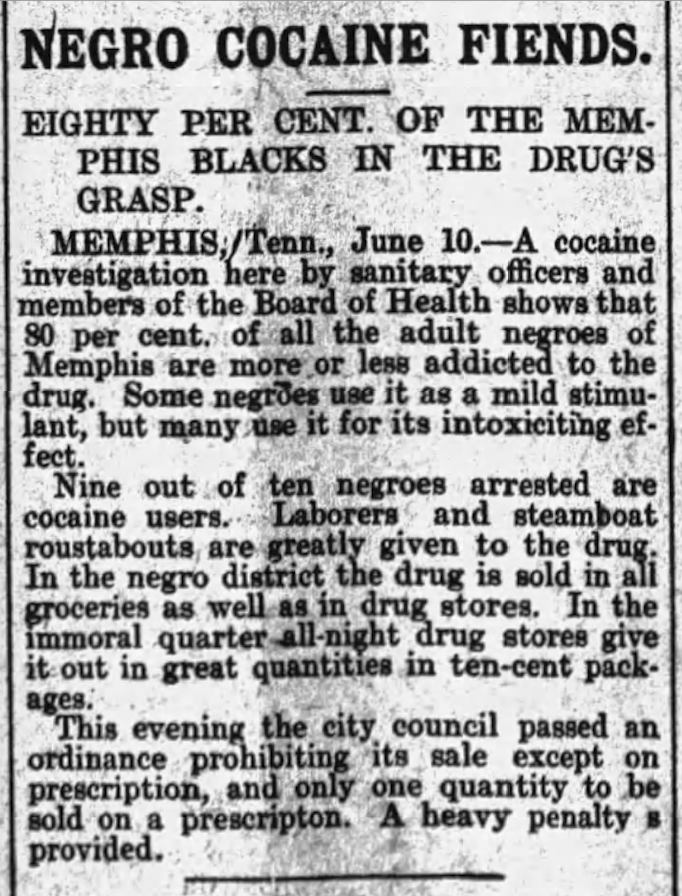
Image #98: “NEGRO COCAINE FIENDS.” The Wilkes-Barre News, Wilkes-Barre, Pennsylvania, June 11th, 1900, p. 6
Translation: “It’s their own damn fault they’re dying out. We only kill them when they get uppity. We whites are cool with the ongoing genocide of the Indigenous peoples of America, but we’ll really miss the African Americans, because they cooked, cleaned and looked after the kids.”
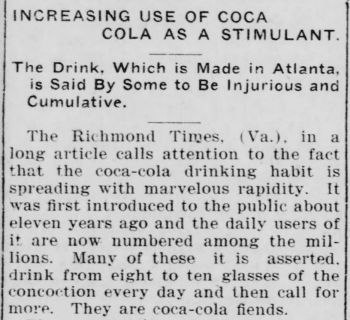
Image #99: “INCREASING USE OF COCA COLA AS A STIMULANT.” El Paso Herald, El Paso, Texas, May 20th, 1901, p. 2
In 1901, stories of “coca-cola fiends” began appearing, tying Coca Cola to the “cocaine fiend” narrative already in progress. One article, from the Times of Richmond, Virginia, was titled “COCO-COLA (sic) FIENDS GROW TO MULTITUDINOUS ARMY”, (133) mentioning the fact that “PRODUCT COMES FROM ATLANTA”, which was considered an oasis of African American culture and education for decades. (134) Later that year, the Atlanta Constitution reported on the illegal sales of cocaine and the “use of the drug among negroes is growing to an alarming extent”, and without mentioning Coca Cola by name, mentioned that;
“It is stated that quite a number of the soft drinks dispensed at soda fountains contain concaine (sic), and that these drinks serve to unconsciously cultivate the habit with the user.” (135)
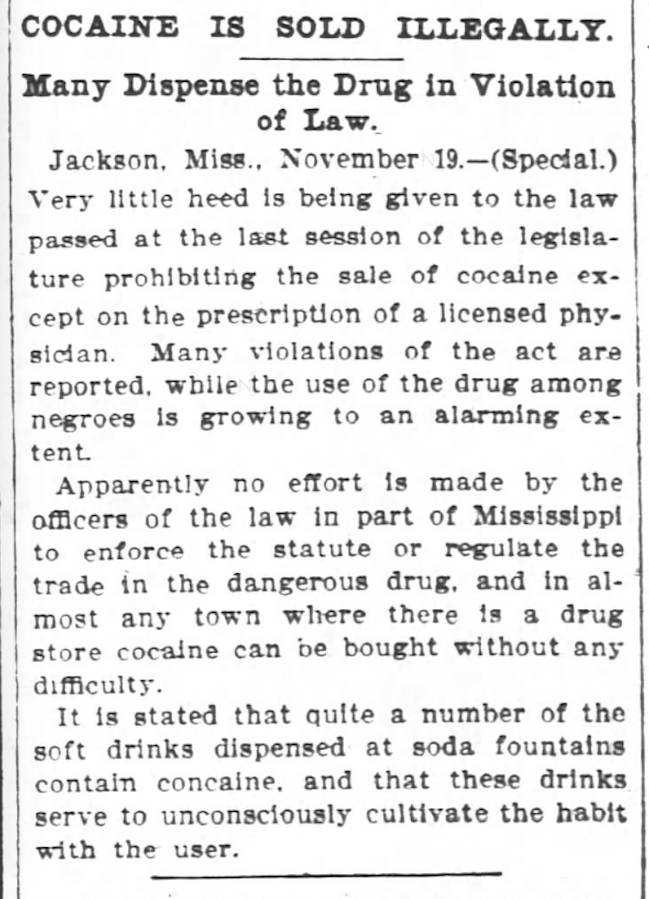
Image #100: “COCAINE IS SOLD ILLEGALLY.” The Atlanta Constitution, Atlanta, Georgia, November 20th, 1901, p. 5
It is said that this attempt at creating an association between Coca-Cola and “negro cocaine fiends” was one of the the primary motivating factors that resulted in Coca-Cola removing the cocaine from its product. (136)
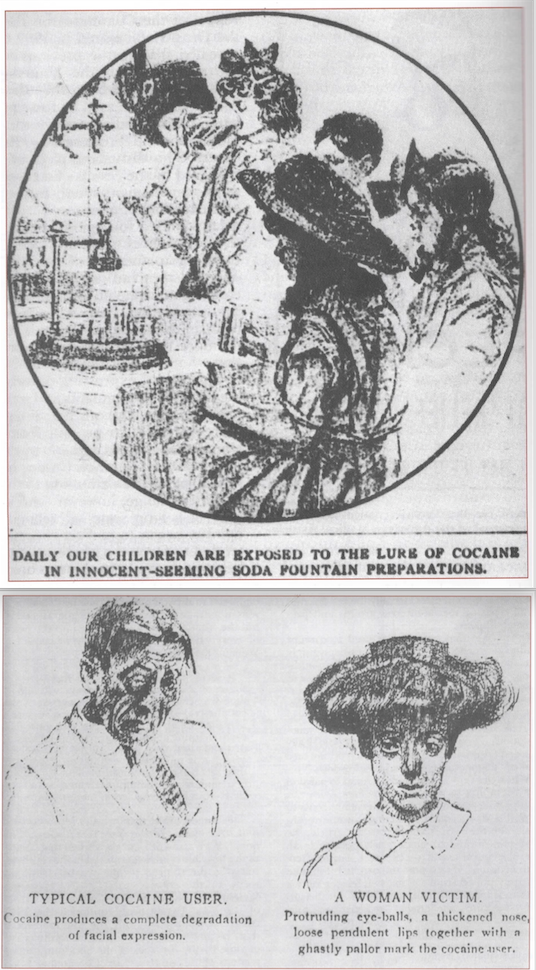
Image #101: Child-victims of Coca Cola & adult victims of cocaine, Hampton’s Magazine, May 1911. From Coca Wine, Aymon De Lestrange, 2016, pp. 148-149
Occasionally, the newspapers would report honestly about one of the reasons African Americans were using cocaine disproportionately – they were being exploited by employers who expected long hours of them. But the papers still called them “negro cocaine fiends” rather than “exploited workers”;
“The cocaine habit began among the Negro roustabouts of New Orleans, who found that the drug enabled them to perform more easily the extraordinarily severe work of loading and unloading steamboats at which, perhaps for 70 hours at a stretch, they have to work, without sleep or rest, in rain, in cold and in heat.” (137)
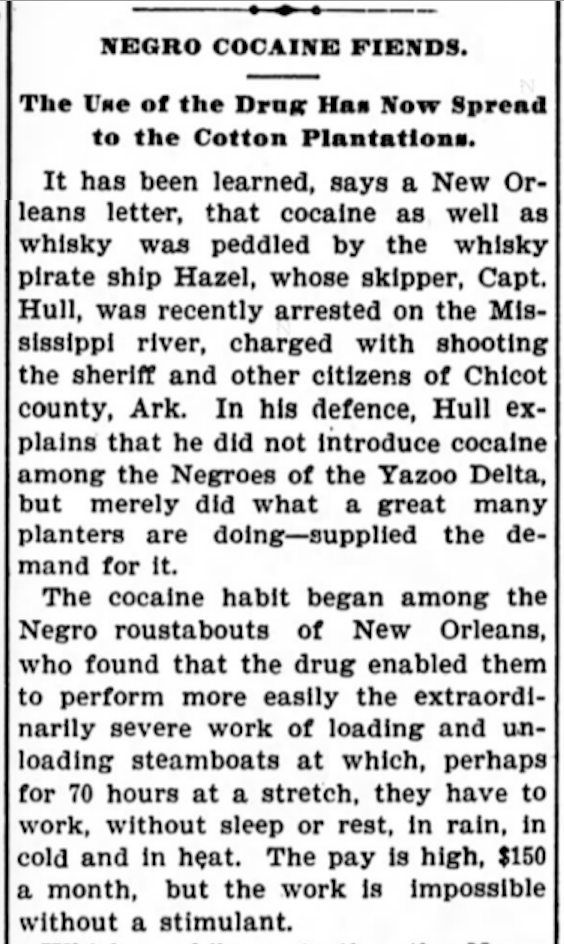
Image #102: “NEGRO COCAINE FIENDS.” Yorkville Enquirer, York, South Carolina, November 8th, 1902, p. 1
In 1903 Robert Rauson – a “negro cocaine fiend” – was sent to an insane asylum because he was making “all kinds of trouble for the police”. (138) The next year Fen Mitchell – another “negro cocaine fiend” – was beaten bloody by the police “because he was ugly”. (139)
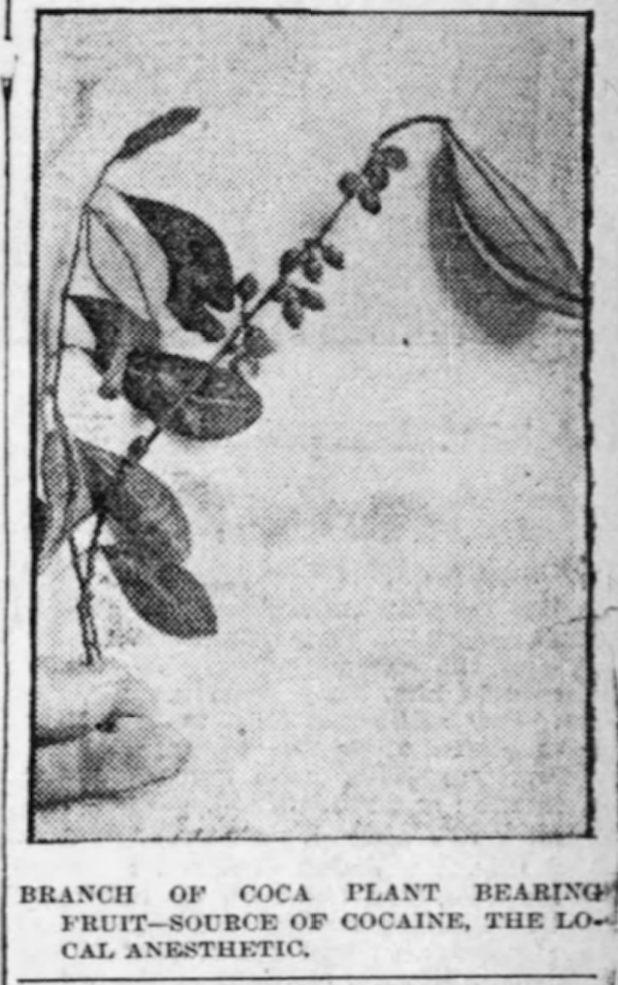
Image #103: “UNCLE SAM’S POISON FARM.” The Boston Globe, Boston, Massachusetts, January 10th, 1904, p. 45
Just in case the illiterate public didn’t hear about the “negro cocaine fiends”, the Atlanta Constitution decided to draw them a picture. Accompanying a 1905 story about African Americans and their “terrible cocaine habit” was four racist cartoons complete with the most derogatory imagery possible, along with the typical racist, condescending narrative found nearly everywhere in the media at the time;
“For five years has cocaine been used by negroes in Atlanta, and it has taken that length of time for the terrible drug to show its full work of mental and physical ruin. Never until now have the police realized the frightful havoc the poison has wrought, and although every possible effort has been made to save the wrecked and misguided negroes in spite of themselves, the work of wrecking human minds has gone steadily and surely on.” (140)
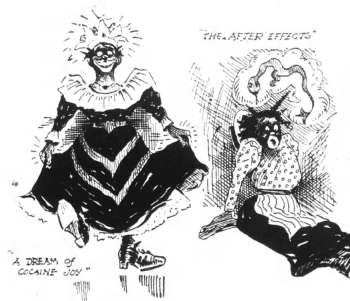
Image #104: “Pen Pictures of Cocaine Fiends, Showing Some of the Effects the Drug Works Upon Its Unfortunate Victims”. “HOW HUMAN VICTIMS ARE WRECKED BY THE TERRIBLE COCAINE HABIT,” The Atlanta Constitution, Atlanta, Georgia, January 15th, 1905, p. 7
The same year, a story about the “cocaine war” from Missouri mentioned that “two-thirds” of violent crimes were “caused by cocaine”, which the “colored residents” were “especially addicted to the use” of. (141) The next year, a self-described “manager and overseer of negro labor” from Alabama lamented how cocaine was “dragging down our weaker race to ruin”. (142)

Image #105: “Pen Pictures of Cocaine Fiends, Showing Some of the Effects the Drug Works Upon Its Unfortunate Victims”. “HOW HUMAN VICTIMS ARE WRECKED BY THE TERRIBLE COCAINE HABIT,” The Atlanta Constitution, Atlanta, Georgia, January 15th, 1905, p. 7
In 1910, Hamilton Wright – the first U.S. “Opium Commissioner” (America’s first Drug Czar-esque position) and delegate to the first international drug commission in 1909 – accused cocaine of causing the corruption of young girls into the “white-slave traffic” as well as causing African Americans to rape;
“It is certain, however, that the use of cocaine among the lower order of working negroes is quite common . . . Inquiries have been made as to whether or not cocaine is forced by contractors on the humble negro worker. There is some evidence that they do so under the impression that they can get more and better work from their employees. Looking at the wider aspect of the use of cocaine throughout the United States, there is absolutely truthworthy information that the use of this drug has spread widely among the criminal classes of our large cities, that it is used by those concerned in the white-slave traffic to corrupt young girls, and that when the habit of using the drug has been established it is but a short time before the latter fall to the ranks of prostitution . . . It has been authoritatively stated that cocaine is often the direct incentive to the crime of rape by the negroes of the South and other sections of the country.” (143)

Image #106: “The U.S. delegation to the International Opium Conference at The Hague. America’s first Opium Commissioner Hamilton Wright is at left. (DEA Museum)” 1909. Image from washingtonpost.com
He was interviewed in the New York Times the next year where he could continue to associate cocaine use with crime, murder, white slave traffic, and just how “common” it was for the “lower order of working negroes” to use it, just in case the readers were wondering who was perpetrating the aforementioned criminal activities. (144) The “cocaine-crazed negro rapist” narrative that Wright and others like him spread around led to the first national drug prohibition law in the U.S. (145) – the Harrison Narcotics Act of 1914, (146) written by Francis Burton Harrison.
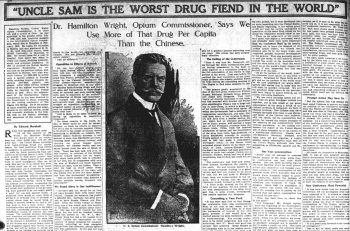
Image #107: “UNCLE SAM IS THE WORST DRUG FIEND IN THE WORLD”
Hamilton Wright, New York Times March 12, 1911, p. 12 (p. 48)
Harrison, who – along with President Taft and Henry L. Stimson, took the position of Governor General of the Philippines (where drug prohibition was first attempted), and, who – along with Taft and Stimson – was a member of the Skull & Bones fraternity, which also gave birth to both the international drug control treaties, and the entity who made the most of those treaties by making billions from drug smuggling: the CIA. (147)
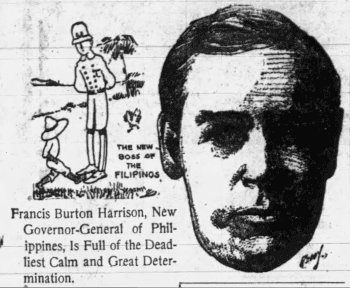
Image #108: “ON CAPITOL HILL”, Buffalo Evening News, Buffalo, New York, September 11th, 1913, p. 5
In 1913, the hype was so powerful an Oklahoma newspaper felt comfortable blaming unsolved axe murders on cocaine-crazed negroes, without a shred of evidence to back up their musings;
“I believe that when the solution of the murders of B. F. Richardson and C. S. Everett has been reached it will be found that a negro cocaine fiend is the murderer. Cocaine is the most dangerous ‘dope’ that is used by the ignorant and degenerate people, either white or black. The instincts of a negro are naturally savage and with cocaine added to these instincts there is no limit to the length they will go.” (148)

Image #109: “DRUG-CRAZED MIND KILLED MERCHANTS SCIENCE’S THEORY”, Muskogee Daily Phoenix and Times-Democrat, Muskogee, Oklahoma, December 4th, 1913, p. 1
All of the actual police suspects of these murders ended up being white – including one who actually confessed to some of the murders. (149)
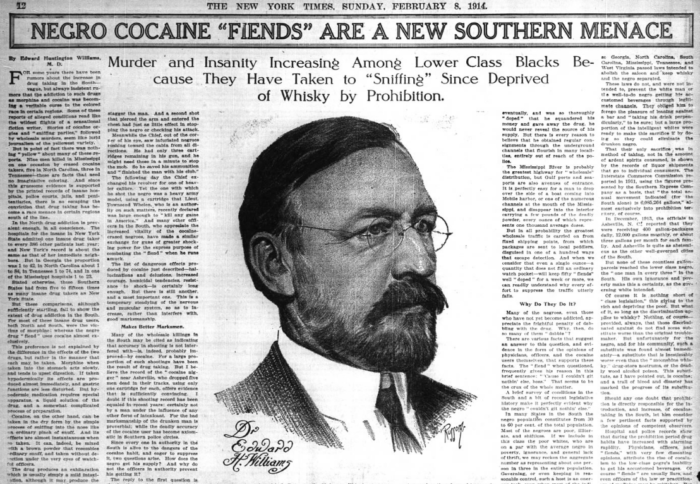
Image #110: “NEGRO COCAINE ‘FIENDS’ ARE A NEW SOUTHERN MENACE”, The New York Times, February 8th, 1914, p. 12 (p. 48)
To make sure the Harrison Narcotic’s Act passed, the New York Times did a feature story in early 1914 on how dangerous cocaine made African Americans – ordinary bullets couldn’t kill them, and they wouldn’t miss if given the chance to shoot back;
“For some years there have been rumors about the increase in drug taking in the South – vague, but always insistent rumors that the addiction to such drugs as morphine and cocaine was becoming a veritable curse to the colored race in certain regions. Some of these reports of alleged conditions read like the wildest flights of a sensational fiction writer. Stories of cocaine orgies and ‘sniffing parties’ followed by wholesale murders, seem like lurid journalism of the yellowest variety. But in point of fact there was nothing ‘yellow’ about many of these reports. Nine men killed in Mississippi on one occasion by crazed cocaine takers, five in North Carolina, three in Tennessee – these are facts that need no imaginative coloring. And since this gruesome evidence is supported by the printed records of insane hospitals, police courts, jails, and penitentiaries, there is no escaping the conviction that drug taking has become a race menace in certain regions south of the line . . . And many other officers in the South, who appreciate the increased vitality of the cocaine-crazed negroes, have made a similar exchange for guns of greater shocking power for the express purpose of combating the ‘fiend’ when he runs amuck. The list of dangerous effects produced by cocaine just described – hallucinations and delusions, increased courage, homicidal tendencies, resistance to shock – is certainly long enough. But there is still another, and a most important one. This is a temporary steadying of the nervous and muscular system, so as to increase, rather than interfere with, good marksmanship . . . I believe the record of the ‘cocaine nigger’ near Asheville, who dropped five men dead in their tracks, using only one cartridge for each, offers evidence that is sufficiently convincing.” (150)

Image #111: “NEGRO COCAINE FIEND KILLS POLICE CHIEF; LYNCHING THREATENED”, The Austin American, Austin, Texas, June 20th, 1914, p. 2
That same year, the “negro cocaine fiend” narrative was used as an excuse for mass murder and/or ethnic cleansing;
“Two men are dying and there is grave danger of a general lynching of all negroes here as a result of an attempt to arrest a negro cocaine fiend named Edwards. Edwards wrested the weapon of James May, town marshal, from his hand and shot him twice. V. V. Bower, who started in pursuit of Edwards, was shot in the abdomen. Edwards escaped on a freight train, but was arrested in Lincoln County. Citizens of Shoshone have ordered all negroes to leave the city.” (151)

Image #112: “Hague Convention, 1899” by Granger, from fineartamerica.com
Collective punishment – the punishing of a group of people for the crimes of one of the members – was already considered a war crime by 1899. (152) However, it was the cocaine users were (considered) the crazy ones – racism and war crimes were “sane”. The “negro cocaine fiend” narrative also helped to explain mysterious deaths of African Americans in jail. (153)

Image #113: Hamilton Wright, 1909. From wikipedia.org
The first international drug treaty, arising from the International Opium Convention of 1912, was implemented in 1915 by the U.S., the Netherlands, China, Honduras, and Norway, and was put into force globally in 1919 when it was made a part of the Treaty of Versailles, which was the agreement that defined what the spoils of World War 1 were. (154) The title only mentioned opium, but the U.S. delegation – led by Hamilton Wright – made sure cocaine was also a target. (155)

Image #114: “William Orpen – The Signing of Peace in the Hall of Mirrors, Versailles 1919,” from Treaty of Versailles, wikipedia.org
In October of 1917, just as Russia was swept up in Revolution, Aleister Crowley published his essay “Cocaine” in the art magazine The International. The missive was a mixture of really good ideas and really bad ideas, can be found online, and is worth reading in its entirety, but a few selected short passages will have to suffice for the purposes of today’s article;
“To one the drug may bring liveliness, to another languor; to another creative force, to another tireless energy, to another glamor, and to yet another lust. But each in his way is happy. . . Give cocaine to a man already wise, schooled to the world, morally forceful, a man of intelligence and self-control. If he be really master of himself, it will do him no harm. He will know it for a snare; he will beware of repeating such experiments as he may make; and the glimpse of his goal may possibly even spur him to its attainment by those means which God has appointed for His saints. But give it to the clod, to the self-indulgent, to the blase — to the average man, in a word — and he is lost. He says, and his logic is perfect; This is what I want. He knows not, neither can know, the true path; and the false path is the only one for him. There is cocaine at his need, and he takes it again and again. . . It should be shown that not even in the most arguable case is a government justified in restricting use on account of abuse . . . I will not here argue the grand thesis of liberty. Free men have long since decided it. Who will maintain that Christ’s willing sacrifice of his life was immoral, because it robbed the State of a useful taxpayer? No; a man’s life is his own, and he has the right to destroy it as he will, unless he too egregiously intrudes on the privileges of his neighbors . . . I still say that prohibition is no cure. The cure is to give the people something to think about; to develop their minds; to fill them with ambitions beyond dollars; to set up a standard of achievement which is to be measured in terms of eternal realities; in a word, to educate them.” (156)

Image #115: Cover of The International, October 1917, from Cocaïn: History & Culture, Armand Limnander, 2018, p. 107
Unfortunately, these little bits of wisdom hidden amongst the more outrageous pronouncements which make up the rest of Crowley’s argument were also overshadowed by Crowley’s reputation as “The Beast,” along with the distraction of the Russian people figuring out exactly what kind of rulers they should suffer under. The vast majority of the public continued to ignore obscure art magazines and instead pay careless attention to the major media and the sensationalist press.

Image #116: Dope Darling, Leda Burke (David “Bunny” Garnett), 1919. From raunerlibrary.blogspot.com
Once the national and international drug laws were firmly in place, the overtly racist rhetoric was replaced with more subtle tactics such as fear-mongering about “crystal death” (157), or how using cocaine would give one “exalted notions” about beating the “trusts or combines” (unfair monopolies) (158) and how “comparatively easy” it would be to “tackle the problem” by keeping “control over all the cocaine factories”, because “the whole process is extremely technical and scientific”. (159)

Image #117: Coca Museum, Cusco, Peru. Image from google.com/maps
Incidentally, the simple 5-step process by which one can turn coca leaves into cocaine is summarized in a visual exhibit at the Coca Museum of Peru, which one can easily find through Google Maps, then by scrolling through the photos until the processing exhibit is found, and then by translating the simple instructions with the aid of Google Translate. It’s not rocket surgery.
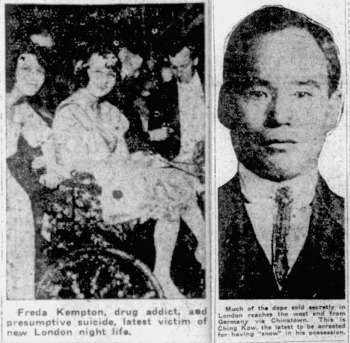
Image #118: “SCANDAL OF DOPED GIRLS IN LONDON DANCE ‘CLUBS’ APPALLING ALL BRITAIN” Buffalo Courier, Buffalo, New York, May 14th, 1922, p. 13
Canada’s first judge – Emily Murphy – got into the action in her 1922 book “The Black Candle”, when she wrote about how “cocaine is sold to school-children” and how this would “hinder development” of “boys and girls” who were “still in a development period” (160) – the exact same excuse used today to justify the cannabis cartel. (161) Murphy also perpetuated the “cocaine-rapist” myth. (162) Those who reviewed her book in the papers echoed the parental hysteria elements of her anti-cocaine propaganda. (163)
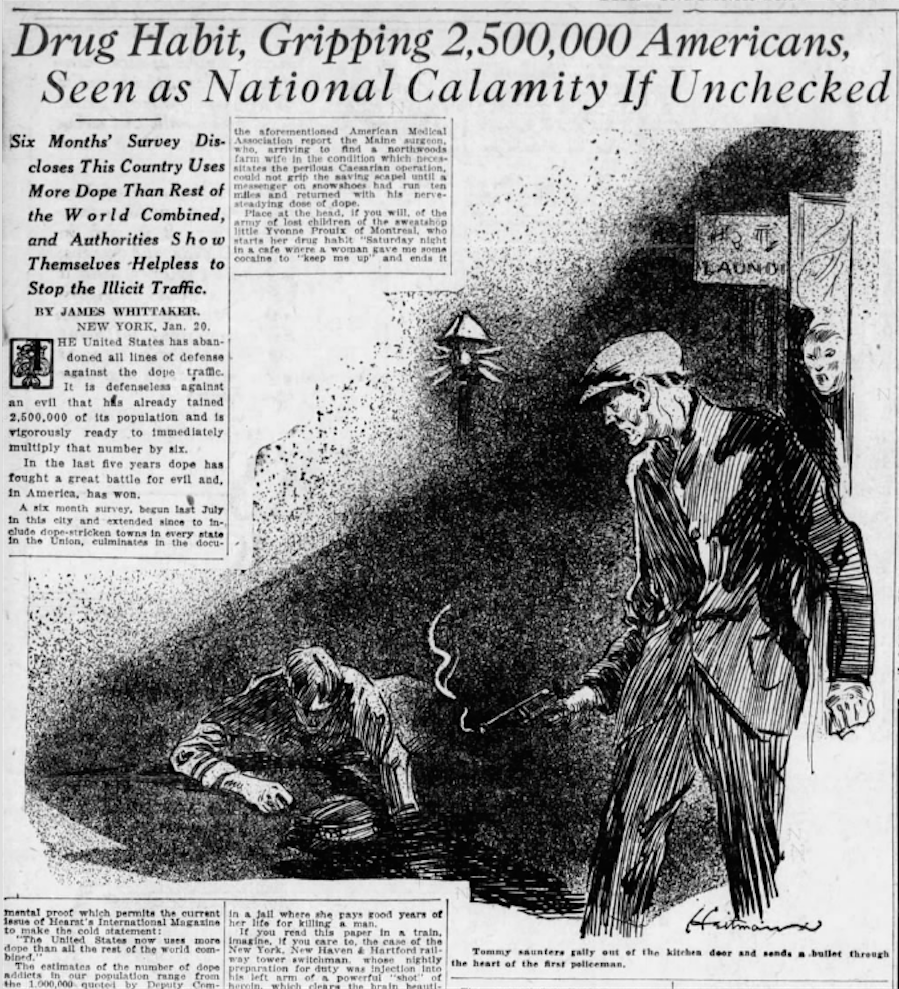
Image #119: “Drug Habit, Gripping 2,500,000 Americans, Seen as National Calamity If Unchecked”, The Indianapolis Star, Indianapolis, Indiana, January 21st, 1923, p. 23
Newspapers in the 1920s focused on the “gnawing desire” (164) habit/dependence and the “cocaine-inspired butchery” of the “unbalanced drug-fiends” (165) or how the “civilized nations” had to save the world from descending to the level of the Inca savages;
“Employed in an infusion, like tea, cocaine is widely employed by natives of the Andes as a medicament . . . Thus humanity has descended to the level of the ancient Incas and worshipped this drug as the savages did of old. To stifle the cocaine evil two measures must be taken by all civilized nations, banded together: First: Bolivia and the other Central American nations must be forced to abandon the harvesting of the coca plant and an international police force should be present at harvest time to burn the entire crop. Second: Germany should prohibit the manufacture of cocaine. Drastic measures such as these, would kill the evil at its source.” (166)

Image #120: “Cocaine and Morphine Users”, The Tulsa Tribune, Tulsa, Oklahoma, June 8th, 1923, p. 14
Meanwhile, academics in 1924 focused their attention on finding “substitutes” for cocaine. They mentioned Butyn and Novocaine, (167) which were used as substitutes for some of cocaine’s anaesthetic applications, but the job of substitution of its stimulating properties first fell on Ephedrine, which “came into commercial use in 1926” (168) just in time to replace the now-heavily restricted pharmaceutical cocaine, and then later on, in the 1930s, Ephedrine began to be replaced with amphetamine (169), and in the 1940s and 1950s, with methamphetamine (170) the last two of which were arguably more toxic and dangerous than cocaine – but cheaper to make.
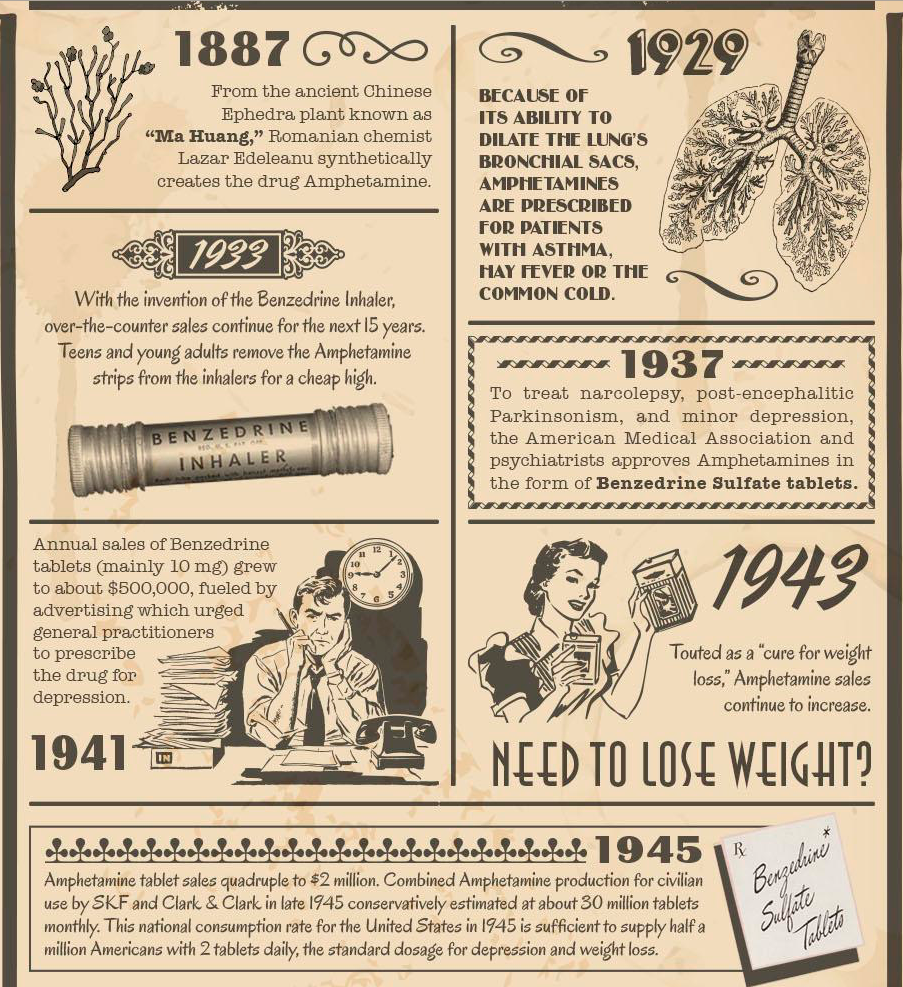
Image #121: Detail, “The History of Amphetamines”, produced by the recovery village, from reddit.com

Image #122: “Poster by Rene Gaillard for Louis le Gouriadec’s play Cocaine, 1926”, Image from Coca Wine, Aymon De Lestrange, 2016, p. 179

Image #123: Poster for the film “Laster der Menschheit” (Vices of Mankind), 1927. Image from imdb.com
By 1928, cocaine (nearly impossible to obtain legally but now widely available on the black market) was being blamed for “60 percent of the crimes of violence in America today.” (171) Three years later, Mrs. M. Grieve – author of the popular A Modern Herbal – would write that “the use of Coca in any form” – including just chewing the leaves – “is attended with grave risks” and “eventually ruins the health”. (172) It is in the late 1920s and early 1930s that the mass media perfected drug hysteria – using colourful, sexy images and scandalous drug stories to make lots of sales in the guise of valuable public service announcements.
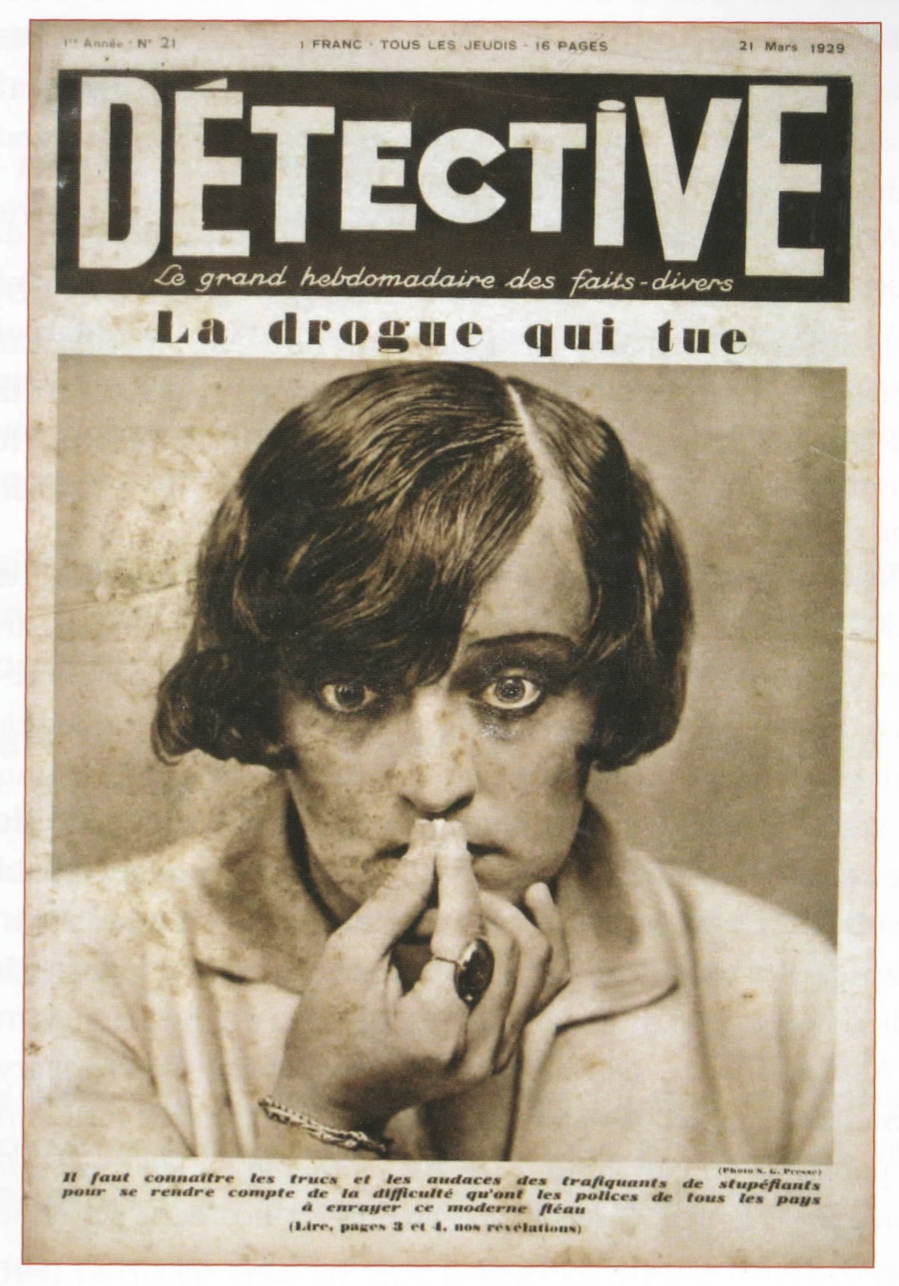
Image #124: Detective Magazine, March 21st, 1929. Image from Coca Wine, Aymon De Lestrange, 2016, p. 159

Image #125: “POISON BLANC” (WHITE POISON), Police Magazine, December 14th, 1930. Image from Coca Wine, Aymon De Lestrange, 2016, p. 161
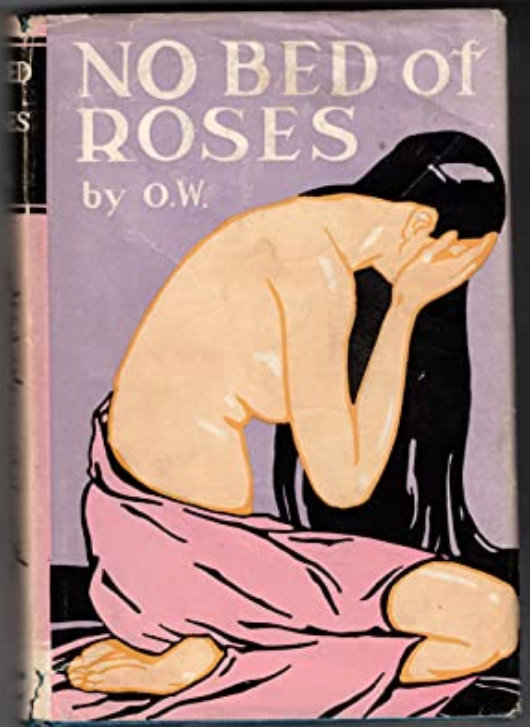
Image #126: NO BED of ROSES, by O.W. (Marjorie Erskine Smith), 1930. Image from abebooks.com
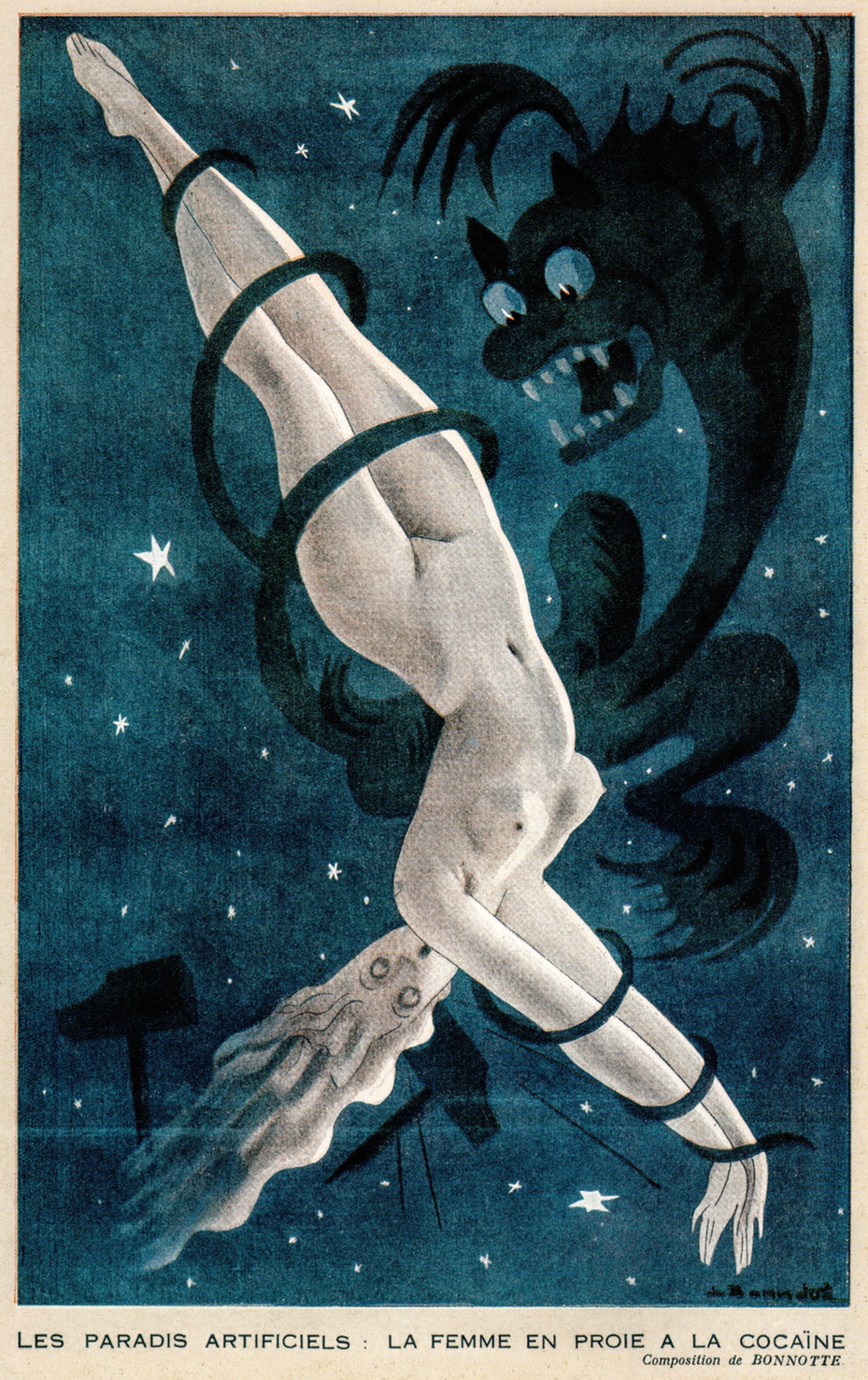
Image #127: “LES PARADIS ARTIFICIELS: LA FEMME EN PROIE A LA COCAINE” (ARTIFICIAL PARADISES: A WOMAN RACKED BY COCAINE). Illustration by Louis Bonnatte in Fantasio, December 16th, 1933. Image from Cocaïn: History & Culture, Armand Limnander, 2018, p. 101
In 1936, a cartoon from Punch Magazine (a humor/satire magazine from London which arguably invented cartoons) depicted a “post-surrealist” artist in his studio, working on a very trippy painting with the aid of “cocaine mixture” and “laughing gas”. (173) The Surrealist movement in art – which the post-surrealist movement had grown out of – had also concerned itself with the use of drugs in general and cocaine in particular. (174) But the artists and musicians that fought periodically for medical autonomy were no match for the businessmen, spies, politicians, academics, doctors, psychiatrists, pharmacists, novelists, film makers, playwrights, magazine and newspaper editors determined to eradicate the medically autonomous – at least until the cultural revolt of the late 1960s made the battle a bit more interesting.

Image #128: “THE POST-SURREALIST”, Punch magazine, December 2nd, 1936, p. 627. Image from ebay.com
In 1946, a doctor, researcher and director of the Institute of Andean Biology – Carlos Monge Medrano – published an article in the journal Annals of the Faculty of Medicine, which pointed out that the traditional use of coca in the Andes was a necessity for life high in the mountains, and that;
“In summary, it can be concluded that the habit of “coqueo” (chewing coca leaves) does not cause clinically established disease, nor does it offer the characteristics common to drug addiction. Rather, it is possible to assume that it acts as a pharmacological agent that enhances the humoral reactions that allow a greater performance to the individual. The latter is a working hypothesis currently being studied by the members of the Institute of Andean Biology.” (175)
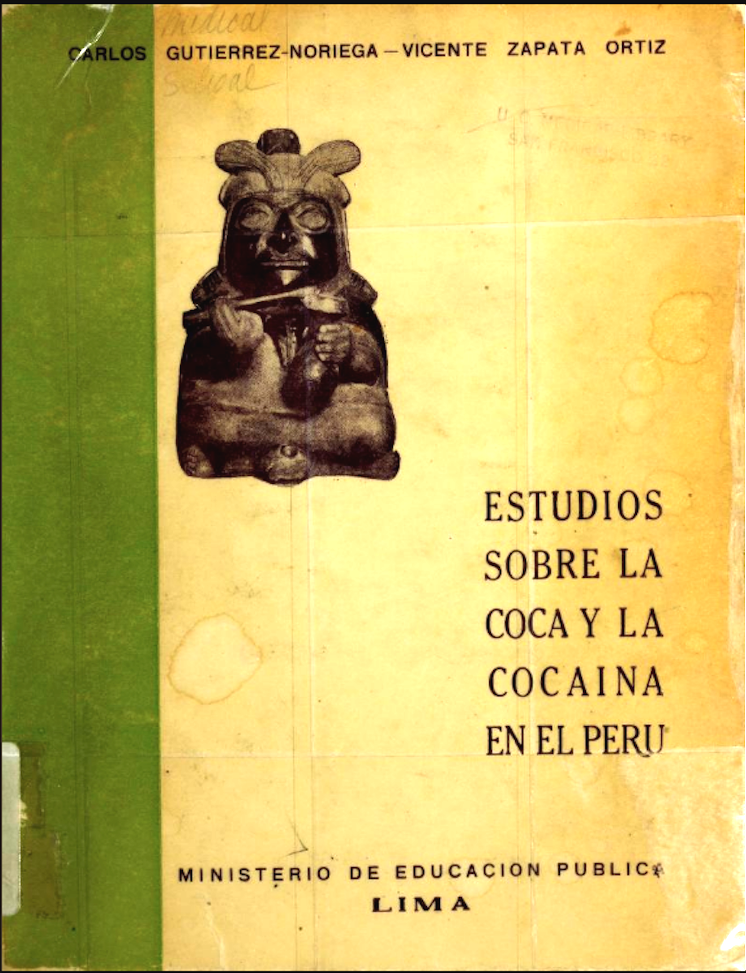
Image #129: “ESTUDIOS SOBRE LA COCA Y LA COCAINA EN EL PERU” (STUDIES ON COCA AND COCAINE IN PERU), Carlos Gutierrez-Noriega & Vincente Zapata Oritz, 1947
The Peruvian medical establishment immediately lost their shit. How does one maintain the oppression of the coca leaf chewers if their herb of choice is viewed as beneficial? The founder of Peruvian pharmacology – Carlos Gutierrez-Noriega – and his associate Dr. Vicente Zapata Oritz of the University of Lima set about to attempt to prove that coca chewing was closely related to illiteracy, negative attitudes towards higher culture, introversion, autism, and “distancing the subject from reality”. (176)

Image #130: “Other manifestations of the hunger for cocaine of habituated dogs. . . View G shows the last dog that spontaneously adopts the supine position in which it is customary to inject the drug.” “ESTUDIOS SOBRE LA COCA Y LA COCAINA EN EL PERU” (STUDIES ON COCA AND COCAINE IN PERU), Carlos Gutierrez-Noriega & Vincente Zapata Oritz, 1947, p. 39
They published their argument for this being the case in 1947, in a book titled “Studies on coca and cocaine in Peru”. (177) Finally getting the “evidence” they needed to justify a crackdown on coca chewers, the United Nations got into the picture and immediately created a commission to decide what to do about the coca problem. The person they chose as chairman of the commission was Mr. H. B. Fonda, Senior Vice-President of the Burroughs-Wellcome Company, Incorporated, of New York (178) – the same Burroughs-Wellcome Company that manufactured cocaine products!
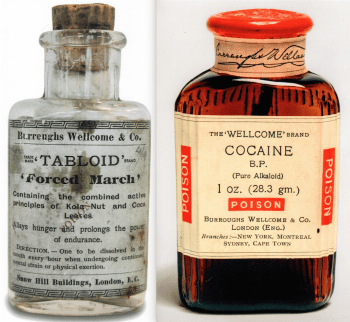
Image #131: Burroughs-Wellcome cocaine products. Images from Cocaïn: History & Culture, Armand Limnander, 2018, pp. 67, 21
The first report of the commission, issued in 1949, argued that the world couldn’t “control” cocaine without first “controlling” coca;
“The leaves which go to satisfy the appetites of the coqueros form also the raw material from which the dangerous drug cocaine is produced; and all the experience in the international control of narcotics shows that the production of a drug cannot be effectively controlled throughout the world unless the production of the raw material from which it is made is also subject to some measure of control.” (179)
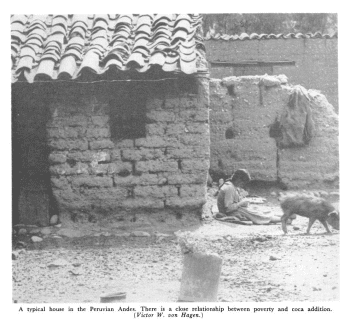
Image #132: “A typical house in the Peruvian Andes. There is a close relationship between poverty and coca (addiction).” “The Strange Case of the Coca Leaf”, Carlos Gutierrez-Noriega and Victor Wolfgang Von Hagen, The Scientific Monthly, February 1950, p. 88
An ECOSOC (United Nations Economic and Social Council)-mandated study published in May 1950 as the Report of the Commission of Enquiry on the Coca Leaf, argued that coca chewing was harmful, in that;
“It inhibits the sensation of hunger and thus maintains, by a vicious circle, a constant state of malnutrition . . . It induces in the individual undesirable changes of an intellectual and moral character . . . It reduces the economic yield of productive work, and therefore maintains a low economic standard of life.” (180)
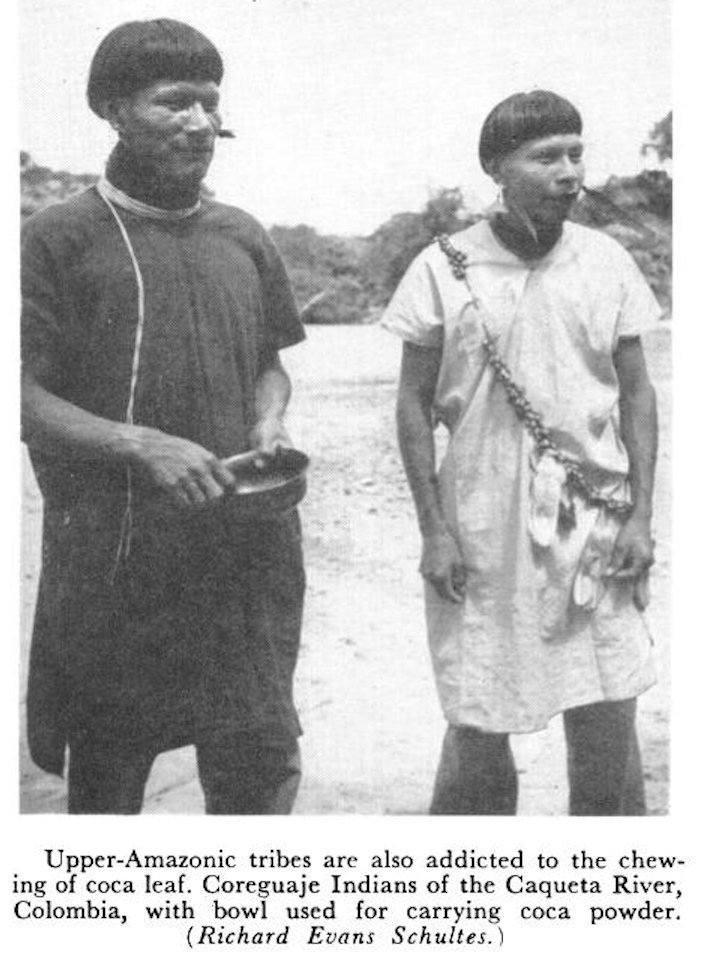
Image #133: “Upper-Amazonic tribes are also addicted to the chewing of coca leaf. Coreguaje Indians of the Caqueta River, Columbia, with bowl used for carrying coca powder.” “The Strange Case of the Coca Leaf”, Carlos Gutierrez-Noriega and Victor Wolfgang Von Hagen, The Scientific Monthly, February 1950, p. 87
In the general recommendation section of the report, nations were instructed to create gradual limitations “of the production of coca leaf for chewing”. Most of the commissioners suggested coca chewing should be phased out in 15 years (181) but the chairman and pharmaceutical industry representative H. B. Fonda recommended it be 5 years instead. (182)
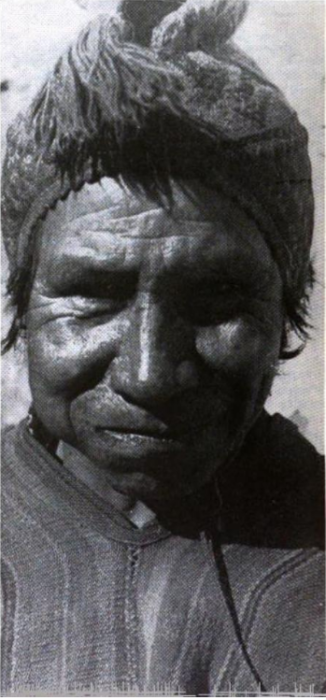
Image #134: “Indian peasant chewing coca leaf: notice the bowl in the right cheek”, Bulletin on NARCOTICS, Vol. 2, No. 4, October 1950, p. 6. Image from books.google.ca
A recommendation to “limiting immediately and, later, eradicating this very general custom (of coca chewing) in the interests of the native population” was made to the Peruvian military government, along with a recommendation to establish “the Coca Monopoly” for the sake of the pharmaceutical industry. (183) Argentina was instructed to create laws designed “for the progressive total elimination of coca-leaf chewing.” (184)
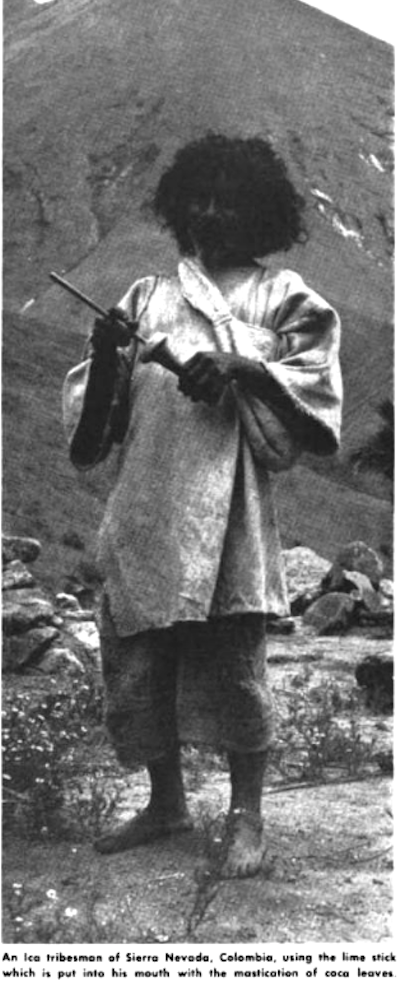
Image #135: “An Ica tribesman of Sierra Nevada, Columbia, using the lime stick which is put into his mouth with the mastication of coca leaves”, Bulletin on NARCOTICS, No. 1, October 1949, p. 23. Image from books.google.ca
In 1952 a similar report was created for the Columbian government. It called coca leaf chewing a “vice”, prohibited the cultivation of coca and cannabis, automatically considered the simple possession of any “narcotic” evidence of trafficking, and created a coca leaf monopoly for certain pharmacies. (185)
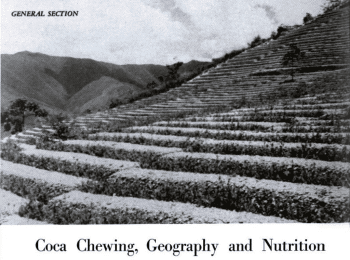
Image #136: “Coca Chewing, Geography and Nutrition”, Bulletin on NARCOTICS, Vol. 2, No. 4, October 1950, p. 2. books.google.ca
The true concern of modern-day elites, expressed candidly in a 1952 United Nations document, is that coca chewing might awaken the Indigenous people to their exploitation and wage slavery. But rather than end that exploitation, the elites recommend the prohibition of coca, to help prevent the awakening. The inconsistency in thinking is revealed by this excerpt, which both blames coca for ambition and at the same time a lack of ambition;
“This display of muscular energy is the result of the euphoria and optimism which flood the intoxicated subject’s entire organism and border on megalomania, since he believes himself to be the owner of the land he is working, of the flocks and herds around him and of the countryside as far as the eye can see. Two hours later, the pleasurable intoxication has evaporated and the Indian once again becomes aware of his true condition; he realizes once more how utterly wretched he is; the spectre of apathy and ancestral woe once more overshadows his feckless existence. Another chew, and the same joyous sensation that began the long day fills him again, and so the vice goes on indefinitely. Many of the most striking psychological symptoms and impairments observed in the native coca addict are also common to most forms of drug addiction; indifference to economic problems, for example, and lack of ambition and aspirations.” (186)

Image #137: “Rural Exploitation”. Image from fineartamerica.com
Instead – as in the United States – of cocaine use justifying “the oppression that was already under way,” it was coca leaf chewing itself doing this, in spite of a massive amount of evidence to the contrary. The Indigenous people of South America weren’t poor, malnourished, illiterate and contemptuous of the dominant culture because of coca chewing – they were suffering these conditions because they were exploited, discriminated against, and every time anyone tried to bring about a change in their situation that might help improve their condition they were called “disloyal”, or “infidels” or later “communists” and attacked by death squads, coups, assassinations or embargos – first by the Incan royalty, (187) then Spanish rulers, (188) then local elites, (189) then finally by the military (190) and the CIA. (191) The Indigenous people were suffering under the crushing heel of Babylon, and coca was their anti-Babylon medicine. Of course, Babylon would blame the coca for their suffering.
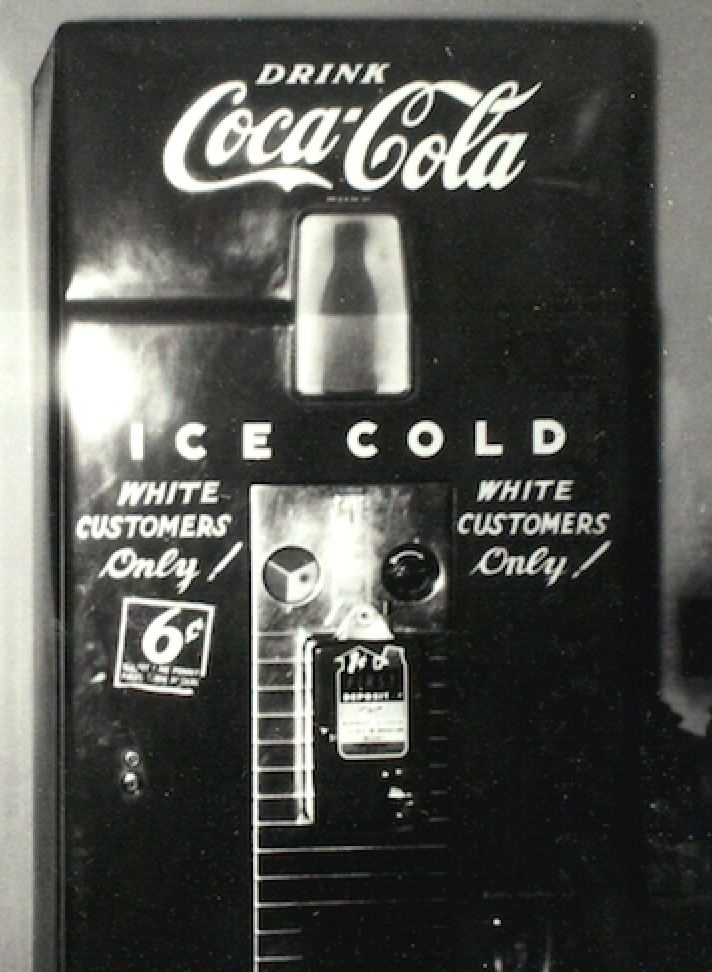
Image #138: “In 1961, Preston E. Stewart, a dean at Lane College in Jackson, TN, was arrested and fined for photographing a Coca Cola machine displaying the segregationist message: ‘White Customers Only!’” Image from Herb Museum collection.
By the 1970s, drug policy researchers began to see these coca-chewing reports from the 1940s and 1950s for what they were – an attempt at confusing the effects of cocaine with the effects of the chewed leaf (192) or pretending the symptoms of poverty and malnutrition were actually the causes of poverty and malnutrition, in order to justify the genocide of the Indigenous people of South America. (193)
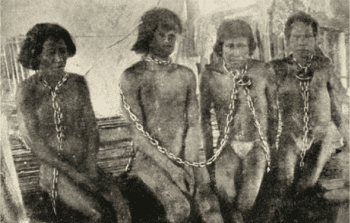
Image #139: “A photo of enslaved Amazon Indians from the 1912 book ‘The Putumayo, the Devil’s Paradise’” by Walter Hardenberg. wikipedia.org: Amazon Rubber Boom
By the 1970s, Babylon was ready to bring the stigma and rhetoric to the next level. In the United States, the drug war was being ratcheted up again, first by Richard Nixon, who on June 19th, 1971, declared drug abuse “public enemy number one”, adding another $155 million to the anti-drug budget, bringing the total up to $371 million for a year’s worth of prohibition. (194)
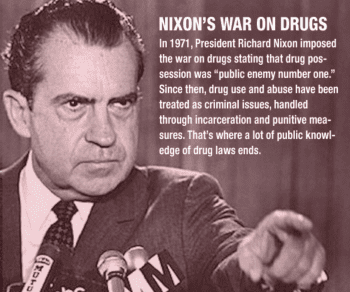
Image #140: kipuhealth.com
New York State’s Rockefeller Drug Law, named after Nelson Rockefeller, the state’s governor at the time, was signed into law on May 8, 1973, and became the toughest drug law in the country. Under the Rockefeller drug laws, the penalty for selling two ounces (57 g) or more of heroin, morphine, “raw or prepared opium”, cocaine, or cannabis or possessing four ounces (113 g) or more of the same substances, was a minimum of 15 years to life in prison, and a maximum of 25 years to life in prison. Other states, such as Michigan, soon followed New York’s lead. (195)
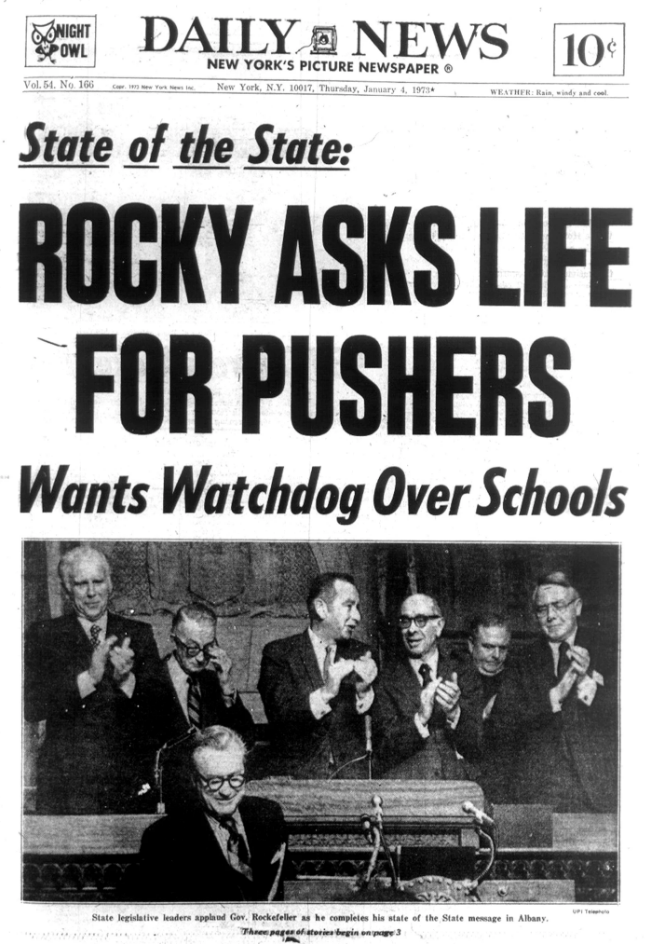
Image #141: “The Jan. 4, 1973, edition of the New York Daily News reports that Gov. Rockefeller’s State of the State speech called for a life sentence for drug pushers.” New York Daily News via Getty Images, from npr.org
On July 1st, 1973, Nixon established the DEA – consolidating all other drug enforcement agencies to date. (196) The DEA’s budget for 2021 is $3.5 billion dollars. (197) In order to increase the number of people going to jail for drug crimes, the police began to routinely assign retail drug values for bulk purchases, in order to inflate the worth of the drugs in question, a practice likened to “attributing the value of 100 Christian Dior dresses to a bale of cotton.’” (198)
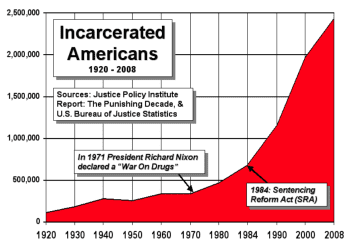
Image #142: “Total incarceration in the United States by year”, wikipedia.org: War on drugs
The presidency of Ronald Reagan, which began in 1980, saw a further expansion of the drug war. In his first term, Ronald Reagan signed the Comprehensive Crime Control Act of 1984, which expanded penalties towards possession of cannabis, established a federal system of mandatory minimum sentences, and established procedures for civil asset forfeiture. (199) In September 1986 – at the height of the 1980s CIA cocaine smuggling operations and less than a month before the Iran-Contra scandal began – Reagan said this about cocaine and crack:
“Despite our best efforts, illegal cocaine is coming into our country at alarming levels, and 4 to 5 million people regularly use it . . . Today there’s a new epidemic: smokable cocaine, otherwise known as crack. It is an explosively destructive and often lethal substance which is crushing its users. It is an uncontrolled fire.” (200)
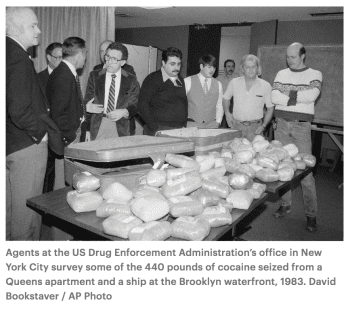
Image #143: “Agents at the US Drug Enforcement Administration’s office in New York City survey some of the 440 pounds of cocaine seized from a Queens apartment and a ship at the Brooklyn waterfront, 1983.” David Bookstaver / AP Photo, from topic.com
Reagan’s Anti-Drug Abuse Act of 1986 (201) mandated a minimum sentence of 5 years without parole for possession of 5 grams of crack cocaine – used mainly by African Americans – while it mandated the same for possession of 500 grams of powder cocaine – used mainly by white Americans.

Image #144: “Number of People in Prisons and Jails for Drug Offenses, 1980 vs 2018”, from kipuhealth.com

Image #145: These four men 1) shaped the drug war in the US and abroad, and 2) were all members of Skull & Bones, a fraternity at Yale founded by opium smuggler Samuel Russell, his cousin William Huntington Russell and Alphonso Taft.
When “ex” CIA director George H.W. Bush – the “Biggest. Drug Lord. Ever.” (202) – was elected president in 1989, his inaugural address included a mention of cocaine:
“There are few clear areas in which we as a society must rise up united and express our intolerance. The most obvious now is drugs. And when that first cocaine was smuggled in on a ship, it may as well have been a deadly bacteria, so much has it hurt the body, the soul of our country. And there is much to be done and to be said, but take my word for it: This scourge will stop.” (203)
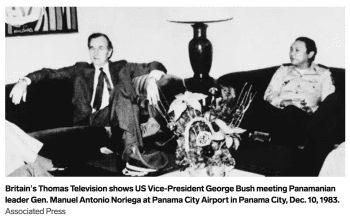
Image #146: Bush and notorious drug criminal Manuel Noriega, December 10th, 1983, during Iran-Contra cocaine-smuggling years. Image from businessinsider.com

Image #147: Bush and Félix Rodríguez, assassin, drug smuggler and Iran Contra participant, May 1986.

Image #148: Bush and Oliver North (the man who supervised Iran Contra cocaine smuggling for Bush and reported to him), Christmas 1986. Image from North’s 1991 autobiography, “Under Fire”, opposite p. 271.
Bush instituted the Office of National Drug Control Policy (ONDCP), the director of which is commonly known as the Drug Czar. The current annual budget of the ONDCP is over $379 million dollars. (204) It currently costs at least $10 billion per year to lock up people in US state and federal prisons for drug-related offences. (205) One estimate of the current total budget for US drug prohibition is $47.9 billion per year, while at the same time the U.S. is missing out on $58.8 billion in taxes. (206)

Image #149: Black people continue to be overrepresented in jails and prisons. Image from businessinsider.com
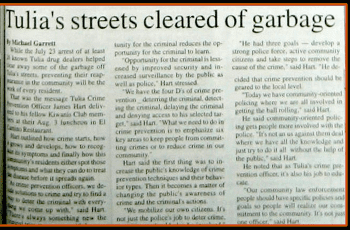
Image #150: Racist article from the Tulia Sentinel in support of using the laws against cocaine as a way to rid the town of black people. Tulia Sentinel, August 12th, 1999, p. 1
The overt, undeniable racism that was everywhere at the beginning of the war on drugs still pops up from time to time. In 1999, there was the Tulia, Texas drug arrests scandal. Ten percent of the town’s black population was busted on bogus accusations of cocaine dealing, with zero evidence – just one police officer’s testimony. Many were sentenced to dozens if not hundreds of years of jail time. (207) Perhaps the most horrifying aspect was that, rather than investigate and expose the obviously bogus drug charges, local reporters joined in with the stigmatization and ethnic cleansing;
“The most shocking of the Sentinel features was an article that got national attention by being included in the feature on CBS’ 60 Minutes in September 2003. The headline of that story read ‘Tulia’s streets cleared of garbage’ and the lead said, ‘While the July 23 arrest of at least 26 known Tulia drug dealers helped clear away some of the garbage off Tulia’s streets (emphasis by the researcher), preventing their reappearance in the community will be the work of every resident” (Garrett, Aug. 12, 1999, p. 1).” (208)

Image #151: Drug raid at Stratford High School, Goose Creek, South Carolina, November 5th, 2003. Image from wistv.com
In 2003, there was the Stratford High School drug raid in Goose Creek, South Carolina. On November 5th, 2003, over a dozen police raided Stratford High School looking for drugs. (209) They held the students – mostly black – at gunpoint, tying some of their wrists with restraints while a drug dog sniffed their bags and the white students watched through windows. They found zero drugs – not even a roach. The students knew it was a racist raid;
“We looked to the other side of the hallway, where most of the caucasian kids were – not a lot of police and stuff was down there.” (210)

Image #152: Drug raid at Stratford High School, Goose Creek, South Carolina, November 5th, 2003. Image from postandcourier.com
Today, the racist nature of the war on drugs is best understood by looking at the justice system;
“At year-end 2019, more than 1% of black adults were serving a sentence in state or federal prisons (1,446 per 100,000 black adult U.S. residents) . . . The imprisonment rate of black adults at year-end 2019 was more than five times that of white adults (263 per 100,000 white adult U.S. residents) and almost twice the rate of Hispanic adults (757 per 100,000 Hispanic adult U.S. residents).” (211)

Image #153: “Drug arrest rates for blacks and whites per 100,000 population, 1972 to 2011.” Taken from The Growth of Incarceration in the United States: Exploring Causes and Consequences (2014) Chapter: 2 Rising Incarceration Rates, p. 61, The National Academies Press, nap.edu
Black people make up approximately 12.3% of the U.S. population but make up 32.9% of the prison population, while Black males age 18-19 are 12.7 times more likely to be imprisoned than white males of the same age, and Black people are over 4 times more likely than white people to be under parole supervision. (212)
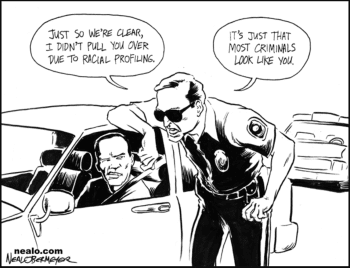
Image #154: Racial profiling. Image from jfcy.org
But it’s not just white supremacy (and the funding of CIA black ops) that the war on drugs – especially the war on cocaine – maintains. It’s also the pharmaceutical monopoly on stimulants. And it’s the genocide of the medically autonomous, which manifests in many ways, and was predicted back in 1989 by writer William S. Burroughs in the film Drugstore Cowboy;
“Narcotics have been systematically scapegoated and demonized. The idea that anyone can use drugs and escape a horrible fate is anathema to these idiots. I predict in the near future right-wingers will use drug hysteria as a pretext to set up an international police apparatus. But I’m an old man and I may not live to see a final solution of the drug problem.” (213)
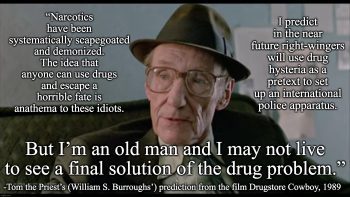
Image #155: Image from the film Drugstore Cowboy, 1989, taken from youtube.com/movieclips.com
In North America, the drug war results in about one person being killed every week by police through the enforcement of drug laws, and untold more dying from horrific prison conditions. (214) Things are considerably worse in other countries. For example, in the Philippines, where the US began experimenting with drug prohibition, thousands are killed every year by drug war death squads. (215)

Image #156: Image from the trailer to On The President’s Orders, a Frontline documentary on the genocidal drug war in the Philippines. Image from youtube.com
If things continue the way they are currently going, most of the cocaine and coca users – all the poor ones – will be hunted down and jailed or forced into treatment, all the cocaine dealers except for those connected to the CIA will be executed or given massive prison sentences, and all the coca bushes will be eradicated except for those used by Coca Cola and the right-wing death squads. Eradication of coca chewing is the stated goal of the United Nations.
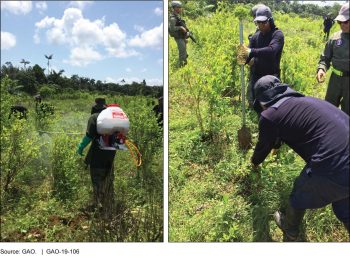
Image #157: “U.S. Government Accountability Office from Washington, DC, United States – Figure 6: Colombian Manual Eradicators Destroying Coca Fields”. wikipedia.org: coca eradication
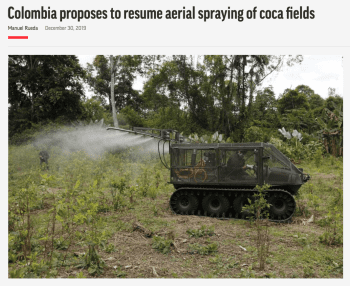
Image #158: From apnews.com
Rather than continue the racist, ecocidal, genocidal policies of cocaine prohibition until they swallow up the entire world, consolidate white supremacy forever and eradicate all vestige of medical autonomy, many policy analysts are now calling for a change of thinking on coca, given the already substantial gains made by the cannabis community towards legitimacy;
“The fanatic campaign against the coca leaf based on religious, racist or self-righteous fervour evident in many decades of the twentieth century must be understood within the context of those times, even if it may be hard to accept today. What should not be accepted today is that critical questioning and decision-making are still influenced and dictated by attitudes and laws that are based on those earlier concepts. Almost two decades into the twenty-first century, a more enlightened approach is called for.” (216)
The Return of Coca
“According to research, the consumption of the coca leaf dates back to 3000 years before Christ. Now 2000 years after Christ, how can you abolish coca chewing in 25 years? Knowing that chewing coca leaves is not at all harmful to human health? The mastication of the coca leaf is this. It does not harm anybody.”
The speech of Evo Morales Ayma, President of Bolivia, spoken while chewing actual coca leaves, at the High-level Segment of the United Nations Commission on Narcotic Drugs, March 11-12, 2009 in Vienna. (217)

Image #159: Evo Morales, speaking in Vienna at the United Nations Commission on Narcotic Drugs, March 11-12th, 2009. Image taken from youtube
The election of Evo Morales – a one-time coca farmer and Indigenous Bolivian – as President of Bolivia in 2006 was definitely a sign of the ineffectiveness of the stigma put upon coca leaf chewing, at least in Bolivia. The struggle by many Bolivians to re-brand coca as a medicine and a nutritional supplement can be better understood by an examination of the steps Morales took to become President.

Image #160: Evo Morales in 1977. Image taken from globalvoices.org
Morales became a coca farmer in the late 1970s, and then joined a trade union of “cocaleros” or coca growers. In 1982 Morales took a leadership role in the union, and resisted the local politician’s and military’s attempt at coca eradication. In the 1980s and 1990s, Morales organized direct-action resistance to eradication efforts, “by occupying local government offices, setting up roadblocks, going on hunger strike, and organizing mass marches and demonstrations”. (218)
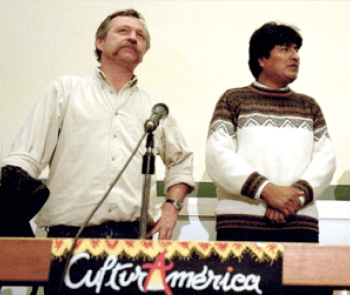
Image #161: “Evo Morales (right) with French labor union leader José Bové in 2002.” From wikipedia.org: Evo Morales
Facing routine beatings, torture and the threat of being killed, Morales decided he would not resist violence with more violence, instead choosing to pursue a political path. Formed in 1998, the party, named Movement for Socialism–Political Instrument for the Sovereignty of the Peoples continued to gain momentum every election, with the vast majority of the MAS-IPSP councillors elected in the 1999 municipal election being Indigenous. (219) Morales’ victory in 2006 was not only a major victory for coca farmers all over South America, but was the first Indigenous presidency in Bolivia’s history. (220)
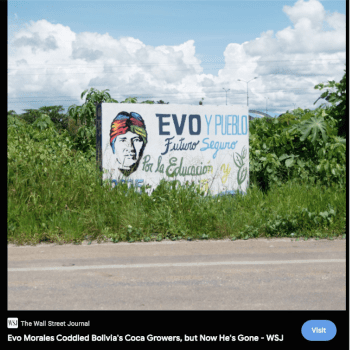
Image #162: From wsj.com
In spite of Morales chewing coca at the United Nations Commission on Narcotic Drugs (CND) meeting in 2009, the UN commissioners have consistently maintained a prohibitionist stance on coca growing and chewing, insisting in 2019 that they would
“Decide to establish 2019 as a target date for States to eliminate or reduce significantly and measurably: (a) The illicit cultivation of opium poppy, coca bush and cannabis plant . . . ” (221)
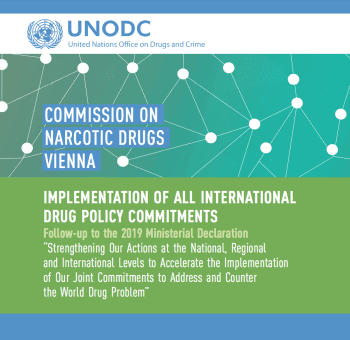
Image #163: From unodc.org
The CND’s 2019 report contains no mention of the already quite successful moves to legalize medical and recreational cannabis in various places all over the world, (222) which makes the CND’s prohibitionist position seem even less grounded in reality than it was pre-legalization.
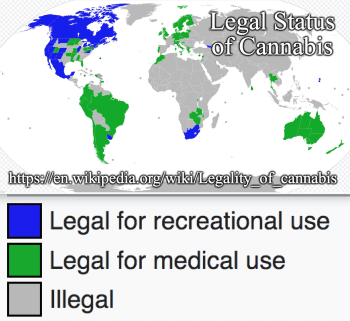
Image #164: From wikipedia.org: Legality of Cannabis
There have been attempts by the research community at making the United Nations and the World Health Organization form policies on coca and cocaine based in fact, which were resisted by the institutional leadership;
“In 1992, the PSA launched the “WHO/UNICRI Cocaine Project”, which according to a press release in March 1995 was the largest global study on cocaine use ever undertaken. The conclusions strongly conflicted with accepted paradigms so that almost as soon as the Briefing Kit started to circulate in the UN corridors, USA officials used their full weight to prevent the release of the study. Years of work and hundreds of pages of valuable facts and insights about coca and cocaine by more then 40 researchers were, in effect, ‘burned’.” (223)

Image #165: From tni.org
The Briefing Kit of the WHO/UNICRI (World Health Organization/United Nations Interregional Crime and Justice Research Institute) Cocaine Project can still be found online. When one reads it, one can see why efforts were made to destroy the research, as it was created by a team of incredibly well-accredited researchers, and the document is filled with statements such as this;
“Use of coca leaves appears to have no negative health effects and has positive therapeutic, sacred and social functions for indigenous Andean populations.” (224)

Image #166: From tni.org
Part of the actual report – the part that survived the WHO/UN censorship – is also available online, in case anyone should want to read some of the massive amount of evidence that led to the above conclusion. (225)

Image #167: From un.org
In September of 2007, the UN adopted the Universal Declaration of the Rights of Indigenous Peoples, also known as UNDRIP. Article 24-1 of UNDRIP guarantees the right of indigenous peoples to their “traditional medicines” and “conservation of their vital medicinal plants”. Article 31-1 also guarantees the right of indigenous peoples to “control” their “genetic resources, seeds, medicines, knowledge of the properties of fauna and flora”. (226) As usual, the parts of the United Nations that actively promote genocide ignore the parts that are designed to guard against genocide.

Image #168: From ipsnews.net
In 2009, the government of Bolivia proposed to amend the 1961 Single Convention by removing two sub paragraphs of article 49 that ban coca leaf chewing. (227) A US-led coalition presented objections and blocked the amendment. (228) In July of 2011 Bolivia doubled-down and denounced the 1961 Single Convention. (229)

Image #169: From thedrinksbusiness.com
The attempt to return coca to its original place of respect and dignity and utility in society has not been limited to farmers, union leaders, politicians and researchers. Entrepreneurs, too, have become active in this capacity. For example, in 2016, Vin Mariani returned to the wine market. (230) In October 2020, long-time cannabis activist Dana Larsen opened up the Coca Leaf Café in Vancouver. The café sells coca tea, Coca Cola (the “real thing” mixture), coca chews, coca gum, coca pain patches and live coca plants, as well as magic mushrooms, mushroom grow kits, peyote & san pedro cacti, analogues of popular hallucinogens for microdosing, along with a wide variety of books, posters, postcards, t-shirts, jewelry and original artwork. (231) Drug-peace activism has been taken to the next level. Direct action gets results, both in the ability to educate the public and to generate revenue in order to make sure all manner of activist efforts can be funded.
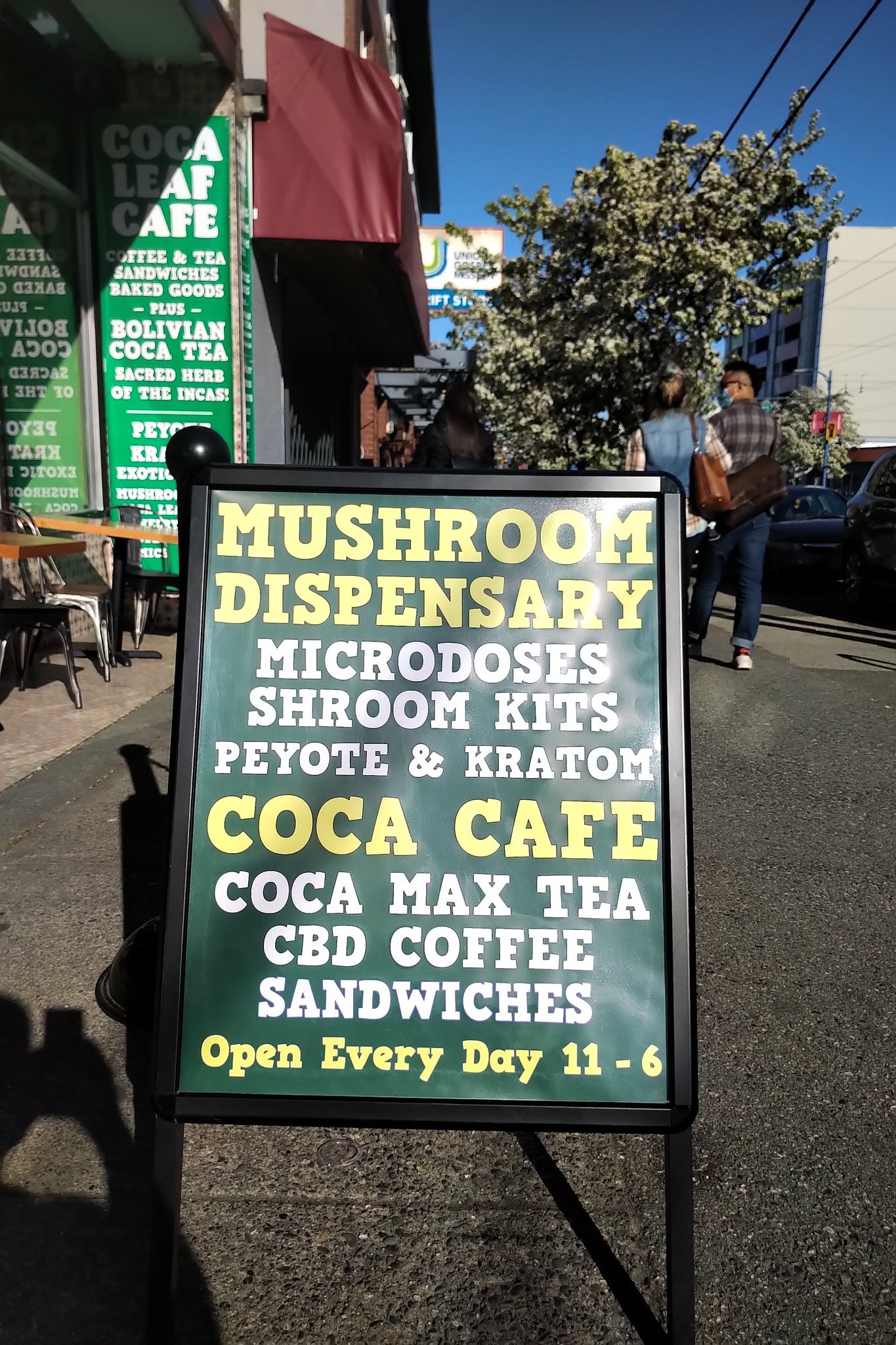
Image #170: From Dana Larsen, twitter.com, April 13th, 2021
If people wish to participate in the return of the coca plant, there are still many activities in addition to the education, lobbying, coca wine making, and Coca Café retail that currently exists. Thought could be given to the creation of a coca leaf cigarette, similar to the product that Parke Davis once produced. (232) Engaging exhibits such as the Coca Museum in Peru (233) could be created in other countries. Coca tea tasting parties, coca-themed street art, and coca-based catering companies are just some of the many direct-action destigmatization efforts that could be pursued. The goal with drug-peace direct action is to create the distribution model you wish to see, and then defend it in the court of public opinion, and – if need be – a court of law.

Image #171: Detail from the Great Mural of Cusco, considered to be the biggest mural of South America.
However one decides to help destigmatize coca, the end goal should be the same as the current goal (in my opinion) for cannabis activists – to create a non-monopolistic legal distribution system for coca that includes everyone within a legal cultivation, legal distribution and legal use framework, focusing on education, organic and fair-trade standards (regulations that would actually address legitimate concerns) rather than regulations that unjustly exclude some users from legitimacy and/or unfairly limits the number of growers or retailers – as has been the case with cannabis legalization regulations so far. We can’t leave the establishment any targets to maintain some type of prohibition – everyone needs to come off the drug war battlefield.
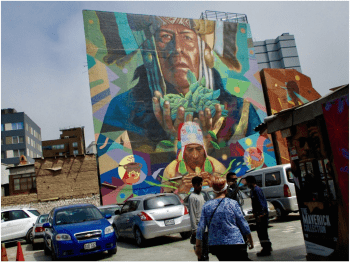
Image #172: Coca leaf mural in Lima, Peru. Photo taken May 3rd, 2019. From dorihoch.org
It is important for activists to stress the difference between the grey-market coca products that currently exist and products from a completely legal model, so the public can understand the difference between black-market-related quality control issues versus those under an ideal system. The Transform Drug Policy Foundation – a UK-based charity – has already taken steps to map out a quality-control system for legal coca tea;
“Drugs of sufficiently low risk, such as coffee or coca tea, require relatively few or no licensing controls. However, they should still be subject to conventional food or beverage regulation concerning ingredients, production practices, labelling, etc. As with food, requirements on labelling and packaging information — as well as warnings — can be established through general legislation operating outside of, or alongside, a licensing system.” (234)

Image #173: There is a mass movement in South America to legalize and legitimize coca, similar to the movement in North America to legalize and legitimize cannabis. Image from elmercuriodigital.net

Image #174: “NO TOCAR SAGRADA” (DO NOT TOUCH THE SACRED). Image from revolviendolasopa.blogspot.com
Comparing herbal medicines like cannabis and coca with coffee and tea has been a long-time strategy of drug peace activists. In the opinion of this writer, it is a mistake to compare cannabis or coca with hard drugs like alcohol and tobacco, as this leaves over-regulation – and cartelization – open to regulators. It is best to stick to arguments that compare soft drugs (drugs with acceptable risks & unlikely to result in death or abuse) with other soft drugs;
“One of the distorting effects of categorizing drugs as ‘good,’ ‘bad,’ and ‘nondrugs’ is to protect the ‘nondrugs’ such as caffeine from warranted criticism while subjecting the illicit drugs to widely publicized attacks – regardless of the relevance of the data to the human condition. Thus we come to the paradox – the question of how a drug so fraught with potential hazard can be consumed in the United States at the rate of more than a hundred billion doses a year . . . without doing intolerable damage – and without arousing the kind of hostility, legal repression, and social condemnation aroused by the illicit drugs. The answer is quite simple. Coffee, tea, cocoa, and the cola drinks have been domesticated. Caffeine has been incorporated into our way of life in a manner (though it does not altogether eliminate) the hazards inherent in caffeine use. Instead of its being classified as an illicit drug, thereby grossly amplifying caffeine’s potential for harm, ways to make caffeine safer have been searched for and found. In the first place, people generally take caffeine in forms so diluted as to make it highly unlikely that excessive doses––– more than 300 or 400 milligrams at a sitting––– will be ingested, The contrast here with alcohol is noteworthy. Whiskey, gin, and other distilled beverages, in contrast to light wines and beer, increase the likelihood that excessive amounts of alcohol will be ingested. Again, coffee is customarily served with cream or milk, which may at least partially protect the lining of the stomach from the irritation the coffee might otherwise produce . . . People have also developed the custom of drinking coffee and tea after a meal – further protection for the stomach lining. Cocktails, in contrast are usually drunk before a meal, increasing the inherent hazards. By keeping coffee legal, society has avoided extortionate black-market prices that might otherwise bankrupt coffee drinkers and lead them into lives of crime. And coffee drinkers are not stigmatized as criminals, driven into a deviant subculture with all that criminalization entails.” (235)
The Benefits of Legal Cocaine
“The fact that cocaine remains illegal with street prices inflated 100 times the legitimate pharmaceutical price does not benefit the great majority of society. It does benefit the forces of organized crime, the gangsters who masquerade as our police, and the Government in whose interests it is to keep people divided with racism, and to terrify people with the largely manufactured, ever accelerating specter of crime.”
“Snows Up The Nose: A History of COCAINE”, Michael Castleman, Ann Arbor Sun, January 17, 1975 (236)
“That’s what I hate about the war on drugs – I’ll be honest with you – that’s what I can’t stand is all day long we see those commercials: ‘Here’s your brain. Here’s your brain on drugs. Just say no. Why do you think they call it dope?’ And then the next commercial is: ‘This Bud’s for you!’ Come on everybody, let’s be hypocritical bastards! It’s OK to drink your drug! We meant those other drugs – those untaxed drugs. Those are the ones that are bad for you.”
Bill Hicks, One Night Stand, 1991 (237)
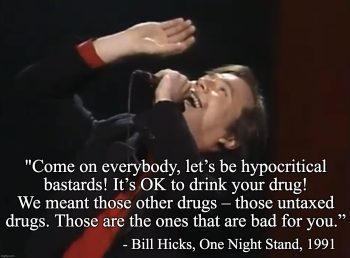
Image #175: From youtube.com
The problems with the prohibition of cocaine are many: jacked-up prices, adulterants and contaminants, zero educational context, profits are funnelled to gangsters/right-wing paramilitary governments/terrorists/black-ops-involved intelligence agencies and other dangerous people. Farmers are easily exploited, sprayed with chemicals by prohibitionists, their crops periodically destroyed and they and their families brutalized. Abusive patterns of cocaine use are encouraged. Civil liberties are minimized. Medical autonomy is non-existent, with the result that humans will eventually evolve into a type of livestock.
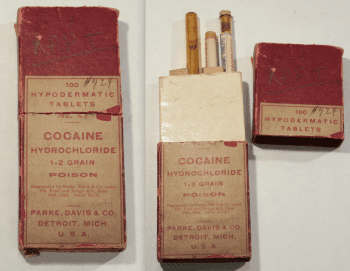
Image #176: Parke, Davis & Co. Cocaine Hydrochloride Hypodermatic Tablets. Photo by Bert Easterbrook, from the Herb Museum collection.
The greatest benefits of legal cocaine are not a result of easy, affordable access to a beneficial-when-used-properly medicinal tool. That’s a benefit, but not the greatest benefit. The greatest benefits of legal cocaine are that all of the above problems involving black-market cocaine would be reduced significantly (if not disappear entirely) if cocaine were legalized and available for drastically-reduced prices in pharmacies – either by prescription, or even on demand like powdered caffeine is today. When alcohol prohibition ended, getting drunk was OK, but not getting machine-gunned in gangster turf wars – or not going blind from bathtub gin – was even better.
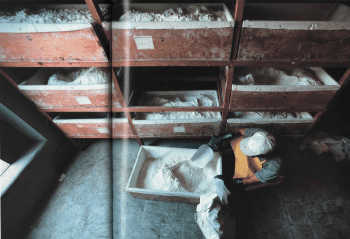
Image #177: “The world buys pharmaceutical cocaine, or the coca leaves to produce it, from Peru’s National Coca Enterprise. Three separately guarded keys are needed to unlock the vault.” Image from “COCA: An Ancient Indian Herb Turns Deadly”, National Geographic magazine, January 1989, pp. 36-37
The key aspect to remember when making the argument to legalize cocaine is that – for the vast majority of cocaine users – use is beneficial and non-problematic. One would never know this if one limited one’s research to high-profile users, who’s high profile is often accompanied with great wealth and a lifestyle of excess. But cocaine-legalization activists need to be able to differentiate between, and help their audience differentiate between, problematic and non-problematic cocaine use. Activists must use arguments such as the following, made by cocaine-legalization activists from the Transnational Institute (TNI), an international coalition of progressives;
“Health problems from the use of legal substances, particularly alcohol and tobacco, are greater than health problems from cocaine use. Cocaine-related problems are more common for intensive, high-dosage users and either unknown or very rare for occasional, low-dosage users. Cocaine use should be treated by providing correct information on its health effects and addictive qualities, not by incarcerating users. First and foremost, an evidence-based health based approach should be given priority over law enforcement. Comprehensive treatment strategies should be available at all times. A clear distinction needs to be made between recreational use and problematic use of cocaine. Prevention, treatment and health care measures should focus on problematic use.” (238)

Image #178: Image from algonquincollege.com
The Ottawa-based Algonquin College has produced a cocaine “how-to” pamphlet for novice users and those interested in cocaine harm-reduction strategies. (239) A modified version of this – one that takes into account quality-control issues have been addressed through legalization – should be available at a safe-point of sale post-legalization.
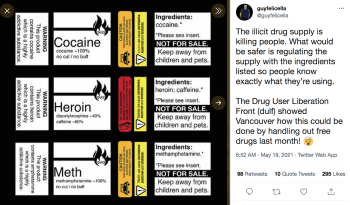
Image #179: Image from instagram.com
A cost/benefit analysis in 2014 of Safer Smoking Facilities and crack harm-reduction kits provided by Vancouver-based VANDU (Vancouver Area Network of Drug Users) concluded that such services were “an efficient and effective use of financial resources in the public health domain” and should therefore be assisted by local health authorities. (240)

Image #180: Images from “How to regulate Stimulants: A practical guide” – available online at transformdrugs.org
In November of 2020, Oregon became the first U.S. State to decriminalize the possession of small amounts of cocaine and heroin. (241) Possession of small amounts of cocaine is legal in Columbia, Mexico and Peru (with limited legal cultivation also legal in Bolivia, Columbia and Peru) (242) and Columbia is currently contemplating the legalization of medicinal cocaine production;
“The bill attempts to create a legal industry that distributes cocaine to users for pain relief, not recreational use. Like that in Bolivia, it also hopes to bring hundreds of thousands of illegal coca farmers out of the shadows into a legal, homegrown industry.” (243)

Image #181: Legal Status of Cocaine, from commons.wikimedia.org
Given the pattern set by cannabis activists, with decriminalization followed by medicinal cannabis legalization followed by recreational cannabis legalization, can recreational cocaine legalization be right around the corner? This author hopes so.

Image #182: From instagram.com
There is an ancient Andean myth regarding the return of the coca plant. It is a story of hope for the oppressed of the world, and a warning to the oppressors. This author enjoys stories like that, so I choose to leave it here, at the end of this article, as a final thought to contemplate;
“The Incas held the coca plant in such high regard that they called it ‘K’oca,’ which means sacred, exalted, and unique. The elders and medicine men used its leaves to predict good fortune or disaster. The story is told that during the reign of Atahualpa there lived on an island in Lake Titicaca a very wise and holy man, named Khana Chuyma. He was High Priest and guardian of the Sun God’s treasures. By that time, the Spanish conquerors had come to these lands, greedy for gold, and had subjugated the native people, sacked their temples, and blasphemed their gods. Resolved to prevent the sacred gold of the Sun God from falling into the hands of the invader, Khana Chuyma secretly hid the gold on the shores of the lake. Every day, he climbed to the highest bluff and scanned the horizon, dreading the approach of Pizarro’s soldiers. One day, he spied their columns of gleaming armor approaching from afar, and, without wasting a moment, he cast the Sun God’s treasure into the depths of the lake. Knowing that he had hidden the gold, the Spaniards took hold of Khana Chuyma, supposing that by brute force they could get him to divulge the secret of the treasure. But Khana Chuyma stoically withstood the cruelest of tortures without a word about the gold’s whereabouts escaping his lips. Tired of torturing the holy man to no effect, the soldiers relented and left him for dead in a nearby field. That night, amidst his agony, Khana Chuyma had a glorious vision: the Sun God appeared to him, a resplendent figure perched atop the highest of peaks, and said: ‘My son, you deserve to be generously rewarded for your heroic sacrifice. Ask of me whatever you wish, and I will grant it.’ ‘Oh my beloved God, what favor can I ask of you in this time of pain and defeat, but for the redemption of my people and the expulsion of the invaders?’ ‘That which you ask of me,’ said the Sun, ‘is now impossible. I am powerless against these intruders. Their god has defeated me, and I too must flee, to hide myself amidst the mysteries of time. But before I leave, I would like to bestow upon you something that is within my powers.’ Khana Chuyma responded: ‘Since it is impossible to restore the freedom which my people once enjoyed, as you leave us I ask only for something to help us endure the slavery and hardships that await us – something which is not gold, so that our conquerors do not covet it. I ask you for a secret comfort which would allow my people to ease the yoke of slavery and humiliation which our oppressors will impose upon us.’ ‘So be it,’ said the Sun. ‘Look in the field around you. Do see the plants whose green, oval leaves are budding as we speak? Tell your people that they should cultivate these plants with care and pick its leaves, taking care not to harm the stem. After the leaves have been dried, they should be chewed, for their juice will be a balsam to relieve the sufferings of your people. When your people chew the leaves, they will share brotherhood and solidarity. When they lie exhausted from the endless toil for which they are destined, these leaves will give your people new vitality. On their long journeys through the inclement highlands, coca will alleviate hunger and cold and make their way more tolerable. In the mines, where their new masters will force them to work, the fetidness, darkness and terror of the deep caves will be unbearable without the help of this plant. When they wish to gaze into the future,’ the deity continued, ‘a handful of these leaves tossed to the winds will reveal the mysteries of fate. But while these leaves will signify health, strength, and life for you and your people, they are accursed for your oppressors. When they attempt to exploit its virtues, the coca will destroy them. What for your people will be divine nourishment, will be for the invader a degrading vice, inevitably sowing discord among his kind. This sacred plant is the legacy that I leave you. Take care that it not be extinguished, and make good use of it.’” (244)

Image #183: “Kogi mamo (tribal priest) at Ciudad Perdida, Colombia (2017)”. Image from wikipedia.org: Kogi people
Disclosure:
This author did not use cocaine during the writing of this article. This author did enjoy many cups of coca tea while researching this article, working at the Coca Leaf Café, reading books when business was slow. This author tried using cocaine only once – he did a line of cocaine heavily adulterated with baby powder 32 years ago. This author is awaiting cocaine to be legalized so he can enjoy a line of pure pharmaceutical-grade, ethically-harvested, non-CIA cocaine once per year on his birthday, but can also live without it. As a friend once told him many years ago – “Cocaine helps you be happy, but I can be happy without using cocaine. Pot slows time down, and I can’t slow time down without pot.”
Additional resources:
https://wellcomecollection.org/works?query=coca
https://www.docdroid.net/c1QgM8Z/david-lees-cocaine-handbook-an-essential-reference-pdf#page=129
COCAINE: 1977 EDITORS: Robert C. Petersen, Ph.D. Richard C. Stillman, M.D. NIDA Research Monograph #13 May 1977 https://archives.drugabuse.gov/sites/default/files/monograph13.pdf
http://www.mamacoca.org/Coca_cocaina_historia/MamaCoca_English/The_Making_of_Coca_Simplistically_into_Just_Cocaine_in_Colombia.html
https://www.tni.org/en/primer/coca-leaf-myths-and-reality
https://www.newspapers.com/
https://chroniclingamerica.loc.gov/
http://www.herbmuseum.ca/category/exhibits/exhibits/cocaine
https://cocaleafcafe.com/about-coca/
Citations:
1) Peru – History Of Coca – “The Divine Plant” Of The Incas, W. Golden Mortimer, M.D., 1901, Fitz Hugh Ludlow Memorial Library Edition, San Francisco, 1974, p. xiv
Free online: https://archive.org/details/peruhistoryofcoc00mortrich/mode/2up
2) “Traces of coca leaves found in northern Peru dates the communal chewing of coca with lime (the alkaline mineral, not the citrus fruit) 8000 years back.” https://en.wikipedia.org/wiki/Coca#History
See also: “Chewing coca in South America began by at least 8000 cal BP: our authors found and identified coca leaves of that date in house floors in the Nanchoc Valley, Peru. There were also pieces of calcite — which is used by chewers to bring out the alkaloids from the leaves. Excavation and chemical analysis at a group of neighbouring sites suggests that specialists were beginning to extract and supply lime or calcite, and by association coca, as a community activity at about the same time as systematic farming was taking off in the region.”
Dillehay, T., Rossen, J., Ugent, D., Karathanasis, A., Vásquez, V., & Netherly, P. (2010). Early Holocene coca chewing in northern Peru. Antiquity, 84(326), 939-953.
https://www.cambridge.org/core/journals/antiquity/article/abs/early-holocene-coca-chewing-in-northern-peru/6452FDEFF4B27959A376256AFCFAEECE
“5000 BCE: Evidence of coca chewing by people in northwestern Peru. Archaeologists have found both chewed leaves and calcium-rich rocks that would have provided the lime that is used to this day in conjunction with coca chewing. Evidence suggests it was produced as a community activity at about the same time as systematic farming was being developed in the region.” https://www.erowid.org/plants/coca/coca_timeline.php
“On the sites of Culebras (2500-1800 BCE), Asia I (1800 BCE), and in the Chillon Valley (1900-1750 BCE) and Ancon (1800-1400 BCE) in the south of Peru, archaeologists discovered bags filled with coca leaves as well as limestone containers.”
Aymon De Lestrange, Coca Wine, Park Street Press, Rochester, Vermont, 2016, p. 10
3) “Artefacts such as lime pots date back to 7000 BC.”
https://evolutionofdruguse.wordpress.com/drivers/technologyscience/cocaine/
4) “Coca was domesticated by 3000 BC. This is evident from the spread and distribution of coastal and highland species of coca.” Ibid.
5) “Coca is one of the oldest, most potent and most dangerous stimulants of natural origin. Three thousand years before the birth of Christ, ancient Incas in the Andes chewed coca leaves to get their hearts racing and to speed their breathing to counter the effects of living in thin mountain air. Native Peruvians chewed coca leaves only during religious ceremonies. This taboo was broken when Spanish soldiers invaded Peru in 1532. Forced Indian laborers in Spanish silver mines were kept supplied with coca leaves because it made them easier to control and exploit.” https://www.drugfreeworld.org/drugfacts/cocaine/a-short-history.html
See also: “It was during the Inca Empire – starting from the 13th century – that it acquired a particular religious and socio-economic role.” https://www.storicang.it/a/coca-pianta-sacra-e-curativa-degli-antichi-inca_14907
“. . . since the coca leaf aroused strange sensations, it was called a ‘divine plant,’ and its use was limited to members of the Inca aristocracy.” The Strange Case of the Coca Leaf, Carlos Gutierrez-Noriega & Victor Wolfgang Von Hagen, February 1950, The Scientific Monthly, p. 81
https://www.jstor.org/stable/19900?refreqid=excelsior%3Ab0b8ed7c9365343bb60e6bdd2e52043b
6) “Archaeological and paleo-botanic evidence indicates that humans first recognized coca’s physiological effects 7,000 years ago, and Andean people have routinely chewed its leaves ever since, particularly during arduous labor, such as agriculture and mining. Sharing and chewing coca are also important in social gatherings, when coca acts as a symbol of friendship and community, and in ceremonial practice, when it is offered to the earth (pachamama) and the mountain gods (apu). The earliest known representations of chewing coca are modeled ceramic vessels from the Valdivia culture found in Ecuador about 1600 BC. Later examples include those found in Moche (AD 1–550), assemblages from the north coast of Peru and Tiwanaku (AD 600–1000), and vessels from Bolivia and southern Peru. Inca craftsmen also produced miniature gold and silver anthropomorphic figurines with bulges in their cheeks. Bulges also commonly appear in a range of media as common representations of coca chewing in pre-Hispanic Andean art.”
https://www.bgc.bard.edu/research-forum/articles/79/jar-with-depiction-of-human
7) “The entire aboriginal American race was regarded by the invaders as little more than savage devils worthy only of extermination. Thus Pedro Cieza de Leon, who wrote at the time of the Conquest, garnished his tales with pictures and stories of the Prince of Evil, with whom the Indian was inferred to be in close compact. Cieza was a mere boy of fourteen when he embarked with Don Pedro de Heredia, in 1532, to seek fortune in the New World. … Throughout his writings Cieza refers frequently to Coca, though he has not given any very concise botanical description of the plant, referring more particularly to its common use. In the first part of his chronicles of Peru, he says: ‘In all parts of the Indies through which I travelled I noticed the Indians delighted to carry herbs or roots in their mouths; in one province of one kind, in another another sort, et. In the Districts of Quimbaya and Anzerma they cut small twigs from a young green tree, which they rub against their teeth without cessation. In most of the villages subject to the cities of Cali and Popayan they go about with small Coca leaves in their mouth, to which they apply a mixture which they carry in a calabash, made from a certain earth-like lime. Throughout Peru the Indians carry this Coca in their mouths; from morning until they lie down to sleep they never take it out. When I asked some of these Indians why they carried these leaves in their mouths, which they do not eat, but merely hold between their teeth, they replied that it prevents them from feeling hungry, and gives them great vigor and strength. I believe that it has some such effect, although perhaps it is a custom only suitable for people like these Indians.’” (emphasis by DML)
Peru – History Of Coca – “The Divine Plant” Of The Incas, W. Golden Mortimer, M.D., 1901, Fitz Hugh Ludlow Memorial Library Edition, San Francisco, 1974, pp. 149, 150-151
See also: “Coca played a very important role in medicine, religion, leisure time, and work for the Indian population. During the Inca dynasty (thirteenth to sixteenth centuries), the coca-chewing habit spread among the population.”
Aymon De Lestrange, Coca Wine, Park Street Press, Rochester, Vermont, 2016, p. 10, 12
“Despite the assertions of minute usage, the commercial prominence of coca when the Spaniards arrived in Peru indicated substantial consumption.” Coca Prohibition in Peru: The Historical Debates, Joseph Gagliano, University of Arizona Press, Tucson, 1994, pp. 22-23
https://books.google.ca/books?id=2NPMcjUIWc4C&printsec=frontcover#v=onepage&q&f=false
http://www.mamacoca.org/docs_de_base/Cifras_cuadro_mamacoca/Vasquez_ManuelHoracio_La_Route_de_la_Feuille_de_Coca_1492-1992-Entre_lhistoire_la_memoire_et_loublie_2001.pdf
8) “The Aymara people are an indigenous population of the Andes and Altiplano regions of South America. ‘Khoka’ is an Aymara word that means ‘the tree.’ This is the origin for our modern usage of ‘coca’. The coca shrub is indigenous to South America, Mexico, Indonesia, and the West Indies. It is one of the oldest cultivated plants of South America. Cultivated coca plants belong to two distinct species of the genus Erythroxylum (family Erythroxylaceae): Erythroxylum coca Lam. and Erythroxylum novogranatense (Morris) Hieron. There are two varieties to be found within each of the cultivated species of coca. E. coca Lam. var. coca is also known as ‘Bolivian’ or ‘Huanuco’ coca. This is the best-known variety and continues to be widely cultivated throughout the Andean region for both legal uses and the illegal production of cocaine. Other varieties are found in smaller areas and are mainly cultivated for coca chewing or other traditional uses by local peoples.” https://www.hindawi.com/journals/emi/2016/4048764/
9) “South Americans have cultivated coca plants for about 8,000 years. Valuing the leaves as highly as gold, the Inca treasured coca not only for its myriad medicinal properties, but also for the integral part it played in their sacred rites and rituals. A legend from the Andes tells the tale of Kuka, a woman of such extraordinary beauty that none in the entire empire could resist her. Aware of her power, Kuka used her charms to take advantage of men until word of her misdeeds reached the Great Inca’s ears. He ordered that she be sacrificed, cut in half, and buried. From her grave a miraculous plant sprouted. It gave strength and vigor and alleviated pain and suffering. The people called it coca, in honor of that beautiful and irresistible woman.”
https://stravaganzastravaganza.blogspot.com/2016/11/coca-leaves-were-sacred-to-incas.html
10) “His wife’s name is given as Mama Tankariy Yachiy, or Tacucaray, or Mama Cuca.” https://en.wikipedia.org/wiki/Mayta_C%C3%A1pac
11) “At the time of Mayta Ceapac – the fourth Inca, his queen was designated Mama Coca – ‘the mother of Coca,’ as the most sacred title which could be bestowed upon her. From so exalted a consideration of the plant by royal favor, it was but a natural sequence that the mass of the people should regard Coca as an object for adoration worthy to be deemed ‘divine’.”
Peru – History Of Coca – “The Divine Plant” Of The Incas, W. Golden Mortimer, M.D., 1901, Fitz Hugh Ludlow Memorial Library Edition, San Francisco, 1974, p. 152
12) The Encyclopedia of Aphrodisiacs, Christian Ratsch & Claudia Muller-Ebeling, Park Street Press, Rochester, Vermont, 2013, p. 177
13) The Encyclopedia of Psychoactive Plants, Christian Ratsch, Park Street Press, Rochester, Vermont, 2005, p. 259
14) Ibid.
15) “Ceramic fragment from Valdivia culture which represents a face with a lump in the cheek of the coca chewer Pre 3000 BC”
Cocaine Technology https://evolutionofdruguse.wordpress.com/drivers/technologyscience/cocaine/
16) “We left this port and sailed along the coast, always seeing people on the beach, and at the end of many days we came to in a port, by reason of the necessity for repairing one of our ships, which made much water. Here we found many people, but were unable, either by force or persuasion, to establish any intercourse with them. When we went on shore they opposed the landing fiercely, and when they could do no more they fled into the woods and did not wait for us. Seeing that they were such barbarians we departed thence, and, sailing onwards, we came in sight of an island which was fifteen leagues from the land. We decided upon going to see whether it was inhabited. We found on it the most bestial and the most brutal race that has ever been seen, and they were of this kind. They were very brutish in appearance and gesture, and they had their mouths full of the leaves of a green herb, which they continually chewed like beasts, so that they could hardly speak; and each had round his neck two dry gourds, one full of that herb which they had in their mouths, and the other of white flour that appeared to be powdered lime. From time to time they put in the powder with a spindle which they kept wet in the mouth. Then they put stuff into their mouths from both, powdering the herb already in use. They did this with much elaboration; and the thing seemed wonderful, for we could not understand the secret, or with what object they did it.”
Second Voyage of Amerigo Vespucci, 1504
https://www.gutenberg.org/files/36924/36924-h/36924-h.htm#page1
“The more important letter of Vespucci, containing the account of his alleged four voyages, was written in September 1504, a short time before he left Portugal.”
The Letters of Amerigo Vespucci and other documents illustrative of his career, August 3, 2011
https://www.gutenberg.org/files/36924/36924-h/36924-h.htm
Other contenders for “first European to notice coca chewing” include Ramon Pane, Bartolome de las Casas, and Tomas Ortiz. See Coca Prohibition in Peru: The Historical Debates, Joseph Gagliano, University of Arizona Press, Tucson, 1994, p. 27
https://books.google.ca/books?id=2NPMcjUIWc4C&printsec=frontcover#v=onepage&q&f=false
“After Hispaniola they made a brief slave raid in the Bahamas, capturing 232 natives, and then returned to Spain.” https://en.wikipedia.org/wiki/Amerigo_Vespucci
17) The chemistry of common life by Johnston, Jas. F. W. (James Finlay Weir), 1796-1854; Griffiths, L. M. (Lemuel Matthews), Provenance; Bristol Medico-Chirurgical Society. Library, Provenance; University of Bristol. Library, pp. 137-161 https://archive.org/details/b21443798_0002/page/n5/mode/2up
See also: See also: Exploration of the Valley of the Amazon, Part II (of 2), by Lardner Gibbon, 1854 https://www.gutenberg.org/files/57771/57771-h/57771-h.htm#i-082
18) “THE CHYMISTRY OF COMMON LIFE”, James F. W. Johnston, The Times, London, England, January 20th, 1855, p. 12
19) https://en.wikipedia.org/wiki/Paolo_Mantegazza
20) Dr. Paolo Mantegazza, ON THE DIETETIC AND MEDICINAL PROPERTIES OF ERYTHROXYLON COCA, American Journal of Pharmacy, Volume 32, 1860, p. 417 https://books.google.ca/books?id=_z4fAQAAIAAJ&printsec=frontcover#v=onepage&q&f=false
21) “An epoch in the introduction of Coca to the medical men of Europe was marked by the prize essay of Dr. Paola Mantegazza, published in Milan on his return after a residence in Peru, where he had been engaged in practice. He refers to the employment of Coca not only as a medicine but also as an article of food, a use not confined to the rich, like luxuries usually, but which, on the contrary, is prevalent among the working Indians, who enjoy Coca as a nutriment and restorative. So that a laborer in contracting for work bargains not only for the money which he shall receive but the amount of Coca which shall be furnished him.”
Peru – History Of Coca – “The Divine Plant” Of The Incas, W. Golden Mortimer, M.D., 1901, Fitz Hugh Ludlow Memorial Library Edition, San Francisco, 1974, p. 176
22) Aymon De Lestrange, Coca Wine, Park Street Press, Rochester, Vermont, 2016, p. 19
23) https://en.wikipedia.org/wiki/Albert_Niemann_(chemist)
Ueber eine neue organische Base in den Cocablättern, Niemann, Albert, January 1, 1860 https://zenodo.org/record/1424541
24) Aymon De Lestrange, Coca Wine, Park Street Press, Rochester, Vermont, 2016, pp. 24-26
25) Ibid, pp. 72-111
26) The Coca Leaf And Cocaine Papers, George Andrews and David Solomon, Eds., Harcourt Brace Jovanovich, New York, 1975, pp. 12-13
27) Le château de la grippe /par A. Robida ; ill. de quarante compositions en noir et en couleurs par mad[emois]elle Émilie Robida, 1904
https://archive.org/details/lechteaudelagrip00robi/page/n61/mode/2up
28) https://en.wikipedia.org/wiki/John_Stith_Pemberton
29) Aymon De Lestrange, Coca Wine, Park Street Press, Rochester, Vermont, 2016, pp. 138-140
30) Turnera diffusa Wild (Turneraceae) recovers sexual behavior in sexually exhausted males, Journal of Ethnopharmacology Volume 123, Issue 3, 25 June 2009, Pages 423-429 https://www.sciencedirect.com/science/article/abs/pii/S0378874109001883
https://pubmed.ncbi.nlm.nih.gov/19501274/
Exploring scientifically proven herbal aphrodisiacs, Sabna Kotta, Shahid H. Ansari, and Javed Ali, Pharmacogn Rev. 2013 Jan-Jun; 7(13): 1–10. https://www.ncbi.nlm.nih.gov/pmc/articles/PMC3731873/
Anti-Aromatase Activity of the Constituents from Damiana (Turnera diffusa) https://www.ars.usda.gov/research/publications/publication/?seqNo115=242750
31) Aymon De Lestrange, Coca Wine, Park Street Press, Rochester, Vermont, 2016, pp. 141
32) Did Robert Louis Stevenson’s horror classic emerge from a drug-induced nightmare? https://dancingledge.blog/2015/11/13/did-robert-louis-stevensons-horror-classic-emerge-from-a-drug-induced-nightmare/
See also: “Another literary figure of the same time has been suspected of being into coke. Robert Louis Stevenson wrote his first draft of Dr. Jekyll and Mr. Hyde in three days in 1885, and it has been suggested — even in the pages of the Journal of the American Medical Association — that the book owes something to Stevenson’s being treated with cocaine for his case of tuberculosis. The speed of writing the book might suggest cocaine’s stimulant effects, though it should be noted that Stevenson had been worrying for weeks about money and had been scouting about for a plot for a commercial potboiler of a novel, even to the point of cultivating his nightmares. But the suggestion that the potion changes the respectable Dr. Jekyll into the debased Mr. Hyde has something to do with cocaine is a lot less probable. If Stevenson were ever treated with cocaine, it must have been for a very short time. Both the novelist and his doctor, Thomas Scott Bradley, wrote about Stevenson’s case but neither ever mentioned cocaine, though Bradley made no secret of having tried morphine on him. Stevenson couldn’t have been in a position to experience the degenerative effects of heavy cocaine use. And besides, in the original draft of the novel, the potion Dr. Jekyll takes doesn’t change his personality, much less his metabolism: It only changes his appearance, so that the respectable doctor, thus disguised, can go out and do the terrible things he consciously realizes he wants to do. Some traces of this idea remain in the rewrite. For years, Dr. Jekyll says, “I concealed my pleasures … I already stood committed to a profound duplicity of life.” But at his wife’s suggestion Stevenson rewrote the thriller as an allegory, with the potion revealing a dark side of Jekyll’s nature. Still and all, the second draft was also written in three days…”
Cocaine: The Star-Spangled Powder Or, through history with coke spoon and nasal spray, CHARLES PERRY, Rolling Stone, AUGUST 17, 1972
https://www.rollingstone.com/culture/culture-news/cocaine-the-star-spangled-powder-75483/
33) See letters from APRIL 5TH, 1893, JULY 12TH, 1893, AUGUST 23RD, 1893, and SEPTEMBER 9, 1894. https://en.wikisource.org/wiki/The_Letters_of_Robert_Louis_Stevenson_Volume_2/Chapter_XII
Robert Louis Stevenson even called Doyle’s work a painkiller:
From RLS, 5 April 1893, to Arthur Conan Doyle: “I hope you will allow me to offer you my compliments on your very ingenious and very interesting adventures of Sherlock Holmes. That is the class of literature that I like when I have the toothache. As a matter of fact, it was a pleurisy I was enjoying when I took the volume up; and it will interest you as a medical man to know that the cure was for the moment effectual” robert-louis-stevenson.org/literary-network/
34) A Seven-Percent Solution – Sherlock Holmes and Cocaine
https://www.conandoyleinfo.com/sherlock-holmes/sherlock-homes-and-cocaine/
35) Ibid.
36) The U.S. National Dispensatory, Fifth Edition, Lea Brothers & Co., Philadelphia, 1894, p. 503
37) Peru – History Of Coca – “The Divine Plant” Of The Incas, W. Golden Mortimer, M.D., 1901, Fitz Hugh Ludlow Memorial Library Edition, San Francisco, 1974, p. 176
38) “SEC. 8: That the term ‘misbranded,’ as used herein, shall apply to all drugs, or articles of food, or articles which enter into the composition of food, the package or label of which shall bear any statement, design, or device regarding such article, or the ingredients or substances contained therein which shall be false or misleading in any particular, and to any food or drug product which is falsely branded as the State, territory, or country in which it is manufactured or produced. That for the purposes of this Act an article shall also be deemed to be misbranded: In the case of Drugs: First. If it be an imitation of or offered for sale under the name of another article. Second. If the contents of the package as originally put up shall have been removed, in whole or in part, and other contents shall have been placed in such package, or if the package fail to bear a statement on the label of the quantity or proportion of any alcohol, morphine, opium, cocaine, heroin, alpha or beta eucaine, chloroform, cannabis indica, chloral hydrate, or acetanilide, or any derivative or preparation of any such substances contained therein.” https://en.wikisource.org/wiki/Pure_Food_and_Drug_Act_of_1906
39) ACT NO. 1761 – AN ACT GRADUALLY TO RESTRICT AND REGULATE THE SALE AND USE OF OPIUM PENDING THE ULTIMATE PROHIBITION OF THE IMPORTATION OF OPIUM INTO THE PHILIPPINE ISLANDS IN WHATEVER FORM EXCEPT FOR MEDICINAL PURPOSES, 1907
“Sec. 35. This Act shall take effect on October seventeenth, nineteen hundred and seven.”
https://www.chanrobles.com/acts/actsno1761.html
40) Today in Philippine History, October 10, 1907, the new opium law was passed by the Philippine Commission https://kahimyang.com/kauswagan/articles/1306/today-in-philippine-history-october-10-1907-the-new-opium-law-was-passed-by-the-philippine-commission
41) Citations 26-45, “George H.W. Bush: Biggest. Drug Lord. Ever.,” David Malmo-Levine, May 16, 2017 https://www.cannabisculture.com/content/2017/05/16/george-h-w-bush-biggest-drug-lord-ever/
42) Ibid, see also: “George H.W. Bush: Biggest. Drug Lord. Ever. (Part 2),” David Malmo-Levine, February 1, 2018 https://www.cannabisculture.com/content/2018/02/01/george-h-w-bush-biggest-drug-lord-ever-2/
Vansterdam Comix, David Malmo-Levine & Bob High, WEEDS, Vancouver, 2018, pp. 289-390
43) Citations 19-23, “George H.W. Bush: Biggest. Drug Lord. Ever.,” David Malmo-Levine, May 16, 2017 https://www.cannabisculture.com/content/2017/05/16/george-h-w-bush-biggest-drug-lord-ever/
44) See the films: American Made (2017), Kill the Messenger (2014), Double Crossed (1991), Air America (1990), Scarface (1983). See also: Vansterdam Comix, David Malmo-Levine & Bob High, WEEDS, Vancouver, 2018, pp. 289-390; The CIA As Organized Crime, Douglas Valentine, Clarity Press, Inc., Atlanta, Georgia, 2017; Family of Secrets, Russ Baker, Bloomsbury Press, New York, 2009; Fleshing Out Skull & Bones, Kris Millegan, TrineDay, Waltervill, Oregon, 2003; The Conspirators, Al Martin, National Liberty Press, Montana, 2002; Barry and the Boys, Daniel Hopsicker, Mad Cow Press, Eugene, Oregon, 2001; Drug War, Dan Russell, Kalyx.com, Camden, New York, 1999; Dark Alliance: The CIA, the Contras, and the Crack Cocaine Explosion, Gary Webb, Seven Stories Press, New York, 1998; Defrauding America, Rodney Stitch, Third Edition, Diablo Western Press, Inc., Alamo, California, 1998; Compromised: Clinton, Bush and the CIA, Terry Reed & John Cummings, S.P.I. BOOKS/Shapolsky Publishers, New York, 1994; The Politics of Heroin, Alfred W. McCoy, Lawrence Hill Books, Brooklyn, New York, 1991; Inside the Shadow Government, Christic Institute, Washington, D.C., 1988; “COKE AND DAGGER”, Bill Weinberg, Overthrow magazine, Vol. 9, no. 2, Fall 1997, pp. 1-2, 16The Great Heroin Coup, Henrik Kruger, Black Rose Books, Montreal, 1980; Air America: The Explosive Inside Story Of The CIA’s Supersecret Airline, Christopher Robbins, Avon, New York, 1979; “Marshal Ky: The Biggest Pusher in the World?”, Ramparts magazine, May 1971
See also: CIA – Cocaine Conspiracy (1996) https://www.youtube.com/watch?v=w5tLHdDDPMg&t=1s
Secret Heart Beat of America CIA Drug Ops Conspiracy : (Unaired Documentary) https://www.youtube.com/watch?v=dhBy2jXl-rE&t=3508s Netflix Doc: CIA Flooded Black Communities With Crack, January 5th, 2021 https://www.thedailybeast.com/the-bogeyman-exists-the-agonizing-mystery-of-joshua-waldens-murder-in-chattanooga-tennessee?ref=scroll
45) https://www.docdroid.net/xIhJF4E/by-douglas-valentine-the-cia-as-organized-crime-2859040-z-liborgepub-pdf
46) https://en.wikipedia.org/wiki/Yellow_badge
https://en.wikipedia.org/wiki/The_Holocaust
“Stigmatization of the group by the perpetrators through legal measures, such as withholding citizenship, requiring the group to be identified, or isolating them from the whole could show that the perpetrators viewed the victims as a protected group.” https://en.wikipedia.org/wiki/Genocide
“Mass killing is planned. Victims are identified and separated because of their ethnic or religious identity . . .” https://en.wikipedia.org/wiki/Ten_stages_of_genocide
47) Citations 29-37; “George H.W. Bush: Biggest. Drug Lord. Ever.,” David Malmo-Levine, May 16, 2017 https://www.cannabisculture.com/content/2017/05/16/george-h-w-bush-biggest-drug-lord-ever/
48) THE HISTORY AND DEVELOPMENT OF THE LEADING INTERNATIONAL DRUG CONTROL CONVENTIONS Prepared For The Senate Special Committee On Illegal Drugs Jay Sinha Law and Government Division 21 February 2001 https://sencanada.ca/content/sen/committee/371/ille/library/history-e.htm
49) “Bishop Griffiths, Dr. Re On Holy See U.N. Unit,” The Brooklyn Tablet, February 4th, 1961, p. 16
50) “Article 49. Transitional reservations (e) Coca leaf chewing must be abolished within twenty-five years from the coming into force of this Convention as provided in paragraph 1 of article 41;”
United Nations Office on Drugs and Crime Vienna The International Drug Control Conventions Single Convention on Narcotic Drugs of 1961 as amended by the 1972 Protocol Convention on Psychotropic Substances of 1971 United Nations Convention against Illicit Traffic in Narcotic Drugs and Psychotropic Substances of 1988 with final acts and resolutions UNITED NATIONS New York, 2013, p. 63
https://www.unodc.org/documents/commissions/CND/Int_Drug_Control_Conventions/Ebook/The_International_Drug_Control_Conventions_E.pdf
51) “Article 26. The coca bush and coca leaves 1. If a Party permits the cultivation of the coca bush, it shall apply thereto and to coca leaves the system of controls as provided in article 23 respecting the control of the opium poppy, but as regards paragraph 2 (d) of that article, the requirements imposed on the Agency therein referred to shall be only to take physical possession of the crops as soon as possible after the end of the harvest. 2. The Parties shall so far as possible enforce the uprooting of all coca bushes which grow wild. They shall destroy the coca bushes if illegally cultivated. Article 27. Additional provisions relating to coca leaves 1. The Parties may permit the use of coca leaves for the preparation of a flavouring agent, which shall not contain any alkaloids, and, to the extent necessary for such use, may permit the production, import, export, trade in and possession of such leaves. 2. The Parties shall furnish separately estimates (article 19) and statistical information (article 20) in respect of coca leaves for preparation of the flavouring agent, except to the extent that the same coca leaves are used for the extraction of alkaloids and the flavouring agent, and so explained in the estimates and statistical information.”
Ibid, p. 47
This echoes the wording of the Harrison Narcotic Act, Section 6: “The provisions of this Act shall not apply to decocainized coca leaves or preparations made therefrom, or to other preparations of coca leaves which do not contain cocaine.” The Harrison Narcotics Act, Public Law No. 223, 63rd Congress, approved Dec 17, 1914 https://www.erowid.org/psychoactives/law/law_fed_harrison_narcotics_act.shtml
52) “The Stepan Company (a $400 million American Stock Exchange company) of Maywood, New Jersey imports 175,000 KG of coca leaves into the United States each year. The leaves come from some of the same farms that supply the Colombian drug cartels. Its finished products end up in nearly everyone in the United States. The beverage was named Coca-Cola because, originally, the stimulant mixed in the beverage was coca leaves from South America, which the drug cocaine is derived from. In addition, the drink was flavored using kola nuts, also acting as the beverage’s source of caffeine. The recipe once called for five ounces of coca leaf per gallon of syrup, a significant dose. Coca-Cola did once contain an estimated nine milligrams of cocaine per glass. Coke dropped cocaine from its recipe around 1900, but the secret formula still calls for a cocaine-free coca extract. Today Coca-Cola includes a coca leaf extract prepared by a Stepan Company plant in Maywood, New Jersey. The facility, which had been known as the Maywood Chemical Works, was purchased by Stepan in 1959. The plant is the only commercial entity in the country authorized by the Drug Enforcement Agency to import coca leaves, which come primarily from Peru. The non-narcotic extract is sold to Coke. The cocaine is then sold and delivered in armored trucks to Mallinckrodt Inc., a St. Louis pharmaceutical manufacturer that is the only company in the United States licensed to purify the product for medicinal use. There cocaine containing products are manufactured and sold to the medical industry.”
erocx1.blogspot.com/2007/12/legal-aspects-for-importation-of-coca.html
“The Coca-Cola we know today still contains coca — but the ecgonine alkaloid is removed from it. Perfecting that extraction took until 1929, so before that there were still trace amounts of coca’s psychoactive elements in Coca-Cola. As Dominic Streatfield describes in Cocaine: An Unauthorized Biography, the extraction is now done at a New Jersey chemical processing facility by a company called Stepan. In 2003, Stepan imported 175,000 kilograms of coca for Coca-Cola. That’s enough to make more than $200 million worth of cocaine. They refer to the coca leaf extract simply as ‘Merchandise No. 5.’” Why We Took Cocaine Out of Soda, James Hamblin JANUARY 31, 2013 https://www.theatlantic.com/health/archive/2013/01/why-we-took-cocaine-out-of-soda/272694/
53) “Of some interest is that since 1969 Coca-Cola no longer has to demonstrate for the federal government that the coca leaves are completely decocainized. This led one local forensic chemist to speculate that there was probably some cocaine, if very minute quantities, slipping into Coca-Cola.”
Joel Philips and Ronald Wynne, Cocaine: The Mystique and the Reality, Avon Books, New York, 1980, p. 53
“… you will buy a bottle of Coca Cola, make a dichlor extract, make a basic, neutralize the carbonate, make a dichlor extract … of that Coca Cola, put it down to a fine thing, and stick it in a GCMS. Bwoom! There’s the peak for ecogonine. And you turn the gain up a little bit, about one Coke bottle in five will peak for cocaine.”
Alexander Shulgin, The Nature of Drugs, Transform Press, Berkeley, California, 2021, p. 30
54) “One of the few times I’ve run into prejudice was with Coca-Cola. My agent had a great job all ready to shoot, but as soon as Coca-Cola found out that I was a Negro they cancelled the whole deal.”
“Hugh Bell – Man With A Camera”, The New York Age, New York, April 25th, 1959, p. 9
“Black Coca-Cola Workers Still Angry”, Ben White, April 18, 2002
https://www.washingtonpost.com/archive/business/2002/04/18/black-coca-cola-workers-still-angry/2d9d4610-5c10-4145-914a-e1cd2b1c905b/
55) https://www.nfb.ca/film/coca-cola_case/
https://topdocumentaryfilms.com/the-cost-of-a-coke/
http://killercoke.org/cci_talking_points.php
https://www.theguardian.com/media/2003/jul/24/marketingandpr.colombia
https://www.nytimes.com/2001/07/26/world/union-says-coca-cola-in-colombia-uses-thugs.html
https://prospect.org/features/coca-cola-killings/
https://www.pbs.org/frontlineworld/fellows/colombia0106/video_chapter3.html
https://www.theguardian.com/media/2003/jul/24/marketingandpr.colombia
56) https://www.haaretz.com/israel-news/coca-cola-israel-donated-to-left-bashing-group-im-tirtzu-1.5469052
https://www.972mag.com/jerusalem-court-okay-to-call-im-tirzu-a-fascist-group/
57) https://www.coca-colacompany.com/policies-and-practices/political-contributions
58) https://act.colorofchange.org/sign/stop-sponsoring-donald-trump/
https://www.bloomberg.com/news/articles/2021-01-11/coca-cola-suspends-political-donations-after-capitol-violence
59) Drink of the Death Squads – David Rovics https://www.youtube.com/watch?v=5HFZ3cH1UAI
60) Scarface, 1983, at 203:37
61) Vansterdam Comix, David Malmo-Levine & Bob High, WEEDS, Vancouver, 2018, pp. 326, 328, 362
62) “He also became a member of Skull and Bones Society, . . .” https://en.wikipedia.org/wiki/John_Kerry
The Kerry Committee report, formally titled Drugs, Law Enforcement and Foreign Policy, was the final report of an investigation by the Senate Foreign Relations Committee’s Subcommittee on Terrorism, Narcotics, and International Operations. https://en.wikipedia.org/wiki/Kerry_Committee_report
“He was a member of the Yale Conservative Party, elected president of the Yale Political Union and is a member of Skull and Bones. … He also served as chairman of the Senate Select Committee on Intelligence from 1987 to 1993.” https://en.wikipedia.org/wiki/David_Boren
63) “During the sessions, Bowie was heavily dependent on drugs, especially cocaine, and later claimed that he recalled almost nothing of the production.” https://en.wikipedia.org/wiki/Station_to_Station
64) “As a matter of fact, there is considerable variation in the size and shape of the Coca leaf, a variation not due to the fact that the leaves have been collected from several varieties of Coca or even from several different shrubs, but upon one Coca plant there may be found leaves of varying form and size. The Coca collected by Jussieu was from the Yungas of Bolivia, while the bulk of Coca used by the Andeans is grown in Peru. It is the plant used by these Indians, the properties of which have been exalted from the time of the Incas, to which all the traditions of Coca are attached, and really one would be more justified in saying that the specimens sent by Jussieu from Bolivia were a modification of the historical Incan plant than to say that the Peruvian grown species is a variation. The Indians prefer Peruvian Coca, and but for the importance to Bolivian Coca through cocaine less of the latter variety would be grown. Any attempt to describe Coca as a whole from any one variety, it will be seen, must be confusional, Bolivian Coca being rich in cocaine, while Peruvian Coca is richer in aromatic alkaloids. This variation is still maintained in the plants grown artificially at Paris and in the East.”
Peru – History Of Coca – “The Divine Plant” Of The Incas, W. Golden Mortimer, M.D., 1901, Fitz Hugh Ludlow Memorial Library Edition, San Francisco, 1974, pp. 252-254
See also: “Coca is not cocaine. For centuries prior to the isolation of cocaine as coca’s most active ingredient, the Indians who lived on the eastern slopes of the Andes in Bolivia and Peru chewed the leaves as a way of life. Their knowledge of the plant’s virtues was passed on from generation to generation by wad [sic] of mouth. Coca is consumed by chewing the leaves with a pinch of lime prepared from calcinated seashells or plant ashes. Prior to adding the lime, the leaves are chewed to moisten and break them, as well as remove the stalks and strings. Then the lime is added pinch by pinch until the proper mixture is achieved. The wad of leaves is then kept relatively still between the teeth and cheek; it is sucked on rather than chewed. The amount of lime used is critical to the taste and to the concentration of alkaloid released. It is still a common practice for a mother to introduce her young to the coca experience by preparing the wad of leaves in her mouth and then transferring it to the mouth of her child. In this way, the proper amount of lime will present in the first wad of leaves the child uses, which ensures that the first experience with coca will be a positive one. Since lime is caustic, an excess will burn the mouth. Without any formal knowledge of chemistry, these Indians were extracting the alkaloids from the leaves by making them alkaline. They knew that the lime was the mechanism by which absorption of the alkaloids could be controlled. Thus, if while chewing the leaves a little too much alkaloid was released, one had only to ease up on the lime and let the saliva wash out some of the excess lime into the stomach. The lower concentration of lime would result in a slower absorption of alkaloids. Interestingly, cocaine alkaloid content was not the prime factor in choice of leaves. The Indians consistently chose leaves with a lower cocaine content but a high concentration of sweet, aromatic compounds which gave the wad of coca better flavor. Over the years South American Indians have found the leaf beneficial in numerous ways.” Cocaine Handbook: An Essential Reference, David Lee, What If?, USA, 1983, pp. 23-24
https://www.docdroid.net/c1QgM8Z/david-lees-cocaine-handbook-an-essential-reference-pdf#page=25
“Coca appears to maintain the teeth and gums in a good state of health; it keeps teeth white. The leaf is rich in vitamins, particularly thiamine, riboflavin, and C. An average daily dose of coca leaves (two ounces) supplies an Indian of the High Sierra with much of his daily vitamin requirement. Coca appears to have a beneficial influence on respiration, and is said to effect rapid cure of altitude sickness. It also rids the blood of toxic metabolites, especially uric acid. Indians say the regular use of coca promotes longevity as well. According to Indian tradition, coca was a gift from heaven to better the lives of people on earth.”
Andrew Weil, “The Green and The White,” The Coca Leaf and Cocaine Papers, George Andrews and David Solomon, Eds., Harcourt Brace Jovanovich, New York, 1975, p. 334
65) “In Ceylon the best coffee is grown from 3,000 to 4,500 feet above the sea, where rain is frequent and the temperature moderate, and, like Coca, the higher the altitude in which the shrub can be cultivated without frost, the better is the quality of the product. Although the yield may be less, the aromatic principles are more abundant and finer than that produced in the lowlands.”
Ibid, p. 13
See also: “Of the various species of coca, only two have been used as primary sources of cocaine, and it is these upon which we will focus. Erythroxylum coca, called Huanaco, is primarily cultivated on the eastern slopes of the Andes in Bolivia and Peru. Its greenish-colored leaves are elliptically shaped with parallel longitudinal lines on the underside of the leaf. It has a haylike odor. The plant grows well in altitudes between 500 – 1500 meters where the climate is favorably tropical, high in rainfall, moderate in temperature, and the soils are mineral rich and well drained. E. coca is the most important commercial species of coca and is used to make the majority of the world’s cocaine. In Peru, the leaves from E. coca represent 95% of the total annual crop. As with the other varieties of coca, the alkaloid content is variable both in amount and composition, depending on where it is grown. A variety of E. coca called Ipadu or Amazonian coca is cultivated in the western Amazon of Brazil, Colombia, and Peru. This variety is propagated by cuttings rather than seeds, and prefers moderate temperatures and well-drained soils. The plant itself is taller and more spindly than Huanaco and has weak branches and relatively large elliptical leaves which are blunt or rounded at the apex. Its underside lacks the characteristic parallel lines. Amazonian coca contains very little true cocaine and is primarily used for chewing by the people who cultivate it.”
Cocaine Handbook: An Essential Reference, David Lee, What If?, U.S.A, 1983, pp. 25-29
https://www.docdroid.net/c1QgM8Z/david-lees-cocaine-handbook-an-essential-reference-pdf#page=23
66) “‘The Indian selects a Coca rich in the aromatic and sweet alkaloids instead of the bitter leaf in which cocaine is predominant.’ Since 1885, most of the writings and the experiments of physiologists upon Coca seem to have been based upon the idea of a single active principle which should represent the potency of the leaf. As is clearly indicated in the history which has been traced through nearly four centuries, this is a false supposition. The qualities of Coca are not fully represented by any one of its alkaloids thus far isolated.”
Ibid, p. 183
67) “Over 100 phytocannabinoids have been identified (Brenneisen, 2007; Mehmedic et al., 2010), but many are artefacts of analysis or are produced in trace quantities that have not permitted thorough investigation. … Terpenoids, not cannabinoids, are responsible for the aroma of cannabis. Over 200 have been reported in the plant (Hendriks et al., 1975; 1977; Malingre et al., 1975; Davalos et al., 1977; Ross and ElSohly, 1996; Mediavilla and Steinemann, 1997; Rothschild et al., 2005; Brenneisen, 2007), but only a few studies have concentrated on their pharmacology (McPartland and Pruitt, 1999; McPartland and Mediavilla, 2001a; McPartland and Russo, 2001b).”
Taming THC: potential cannabis synergy and phytocannabinoid-terpenoid entourage effects Ethan B Russo, Br J Pharmacol. 2011 Aug; 163(7): 1344–1364. https://www.ncbi.nlm.nih.gov/pmc/articles/PMC3165946/
68) “Coca contains at least 14 separate alkaloids.” Freye E. (2009) The Different Types of Alkaloids in Coca. In: Pharmacology and Abuse of Cocaine, Amphetamines, Ecstasy and Related Designer Drugs. Springer, Dordrecht. https://link.springer.com/chapter/10.1007/978-90-481-2448-0_5
See also: “The remarkable physiological activity of coca is due primarily to its alkaloids: to date, some 14 alkaloids have been isolated from varieties of the coca plant. The alkaloids belong to the tropane series, together with atropine and scopolamine from the Solanaceous genera Datura, Hyoscyamus, Atropa, etc. The coca alkaloids are a mixture of ecgonines, tropeines and hygrines. The ecgonine derivatives include cocaine (methyl benzoyl ecgonine), methyl ecgonine and cinnamyl cocaine; the tropeines include tropeine and pseudotropine, dihydroxypeine, tropacocaine and benzoyl tropane; the hygrines include hygrine, hygroline and cuscohygrine. The stereoisomers a- and Ptruxilline have also been isolated from coca leaves, and nicotine has been reported. The isolation of cocaine from coca leaves by Niemann of Gbttingen in 1860 and the discovery of its application in local anaesthesia by Dr. Carl Koller in 1884 constituted major advances in the science of pharmacology, and gave the coca plant and its derivatives an important place in the development of modern medicine.”
The Role of Coca in the History, Religion, and Medicine of South American Indians Author(s): Richard T. Martin Source: Economic Botany, Vol. 24, No. 4 (Oct. – Dec., 1970), pp. 422-438 www.mamacoca.org/docs_de_base/Cifras_cuadro_mamacoca/The_role_of_coca_in_history.pdf
69) “The action of Coca and cocaine, while similar, is different. Each gives a peculiar sense of well being, but cocaine affects the central nervous system more pronouncedly than does Coca, not – as commonly presumed – because it is Coca in a more concentrated form, but because the associate substances present in Coca, which are important in modifying its action, are not present in cocaine (italics added). The sustaining influence of Coca has been asserted to be due to its anaesthetic action on the stomach, and to its stimulating effects on the brain and nervous system. But the strength-giving properties of Coca, aside from mild stimulation to the central nervous system, are embodied in its associate alkaloids, which directly bear upon the muscular system.”
The Coca Leaf And Cocaine Papers, George Andrews and David Solomon, Eds., Harcourt Brace Jovanovich, New York, 1975, p. 15
70) La hoja de coca en la cosmovisión andina (The coca leaf in the Andean worldview), Gian Franco Vacchelli Sicheri
https://www.monografias.com/trabajos72/hoja-coca-cosmovision-andina/hoja-coca-cosmovision-andina3.shtml
See also: https://www.monografias.com/usuario/perfiles/gian_franco_vacchelli_sicheri/monografias
http://www.mamacoca.org/docs_de_base/Consumo/Ne_pas_confondre_Coca_et_cocaine_reedite2011.html
71) https://en.wikipedia.org/wiki/Atropine
72) “…there is little information available regarding the pharmacological or toxicological effects that result from consumption of coca tea.”
Identification and quantitation of alkaloids in coca tea Amanda J. Jenkins, Teobaldo Llosa, Ivan Montoya, and Edward J. Cone, Forensic Sci Int. 1996 Feb 9; 77(3): 179–189. https://www.ncbi.nlm.nih.gov/pmc/articles/PMC2705900/
See also: https://en.wikipedia.org/wiki/Coca_alkaloid
73) https://www.cannabisculture.com/content/2020/09/24/covid-19-cannabis-herbal-medicine-part-2-gain-of-function/
https://www.cannabisculture.com/content/2017/09/25/medical-monopoly-works/
https://www.cannabisculture.com/content/2009/09/23/patented-pot-vs-herbal-gold-standard/
https://www.cannabisculture.com/content/2009/08/12/marijuana-monopolies-yesterday-and-today/
74) “The two most important alkaloids in coca leaf besides cocaine are ecgonine and a pungent, volatile aromatic called cuskohygrine. About the latter, little is known but much is suspected. Germany’s professor Otto Nieschulz, writing as late as 1969, stated that cuskohygrine’s pharmacological properties have never been investigated, and are completely unknown. Modern pharmaceutical processing involves the extraction of cocaine from coca leaf by such chemical techniques as leaching in strong alkali. This process removes the ecgonine as well, but Dr. Nieschulz observes: ‘In the leaves of Peruvian origin examined by us, cuskohygrine was present as the second main alkaloid, next to cocaine … It is not one of the ester-alkaloids separable by alkali’ (italics added). Thus the processed decocainized leaves – precisely those leaves that the Coca-Cola Corporation admits using as a flavoring agent – must still retain some cuskohygrine.”
The Coca Leaf And Cocaine Papers, George Andrews and David Solomon, Eds., Harcourt Brace Jovanovich, New York, 1975, pp. 8-9
75) “If cocaine is consumed on its own, it yields two principal metabolites, ecgonine methyl ester and benzoyleconine. Neither compound has any discernible psychoactive effect. Cocaine co-administered with alcohol, however, yields a potent psychoactive metabolite, cocaethylene. Cocaethylene is very rewarding agent in its own right. Cocaethylene is formed in the liver by the replacement of the methyl ester of cocaine by the ethyl ester. It blocks the dopamine transporter and induces euphoria. Hence coca wine drinkers are effectively consuming three reinforcing drugs rather than one.” -Cocaine.org thenonist.com/index.php/thenonist/permalink/vin_mariani/
76) “Traditional medical uses of coca are foremost as a stimulant to overcome fatigue, hunger, and thirst. It is considered particularly effective against altitude sickness. It also is used as an anesthetic and analgesic to alleviate the pain of headache, rheumatism, wounds and sores, etc. Before stronger anaesthetics were available, it also was used for broken bones, childbirth, and during trepanning operations on the skull. The high calcium content in coca explains why people used it for bone fractures. Because coca constricts blood vessels, it also serves to oppose bleeding, and coca seeds were used for nosebleeds. Indigenous use of coca has also been reported as a treatment for malaria, ulcers, asthma, to improve digestion, to guard against bowel laxity, as an aphrodisiac, and credited with improving longevity. Modern studies have supported a number of these medical applications.” https://en.wikipedia.org/wiki/Coca#Medicine
See also: “We know with certainty that the coca leaves were an important medicine in pre-Hispanic times. Unfortunately, the paucity of sources from the period means that we do not have any specific information concerning the ways in which they were utilized . . . Today, the folk medicinal uses of coca are so manifold that it has been called the ‘aspirin of the Andes’. Coca is used for pains of all types, neuralgia, rheumatism, colds, flu, digestive problems, constipation, colic, upset stomachs, altitude sickness, exhaustion and states of weakness and to ease labor. Coca leaves are burned or smoked to treat bronchitis, asthma, and coughs. In the nineteenth century, the popular Encyclopadie der medizinisch-pharmazeutischen Naturalien und Rohwarenkunde of Eduard Martiny (1954) listed coca smoke as a treatment for asthma. Coca leaves appear to have been smoked for this purpose quite often in England, where they were imported under the name Puruvian tobacco. A brewed coca tea ( mate de coca) is recommended in cases of diabetes and to suppress the appetite of people who are overweight, as a stomach tonic, as an aid in digestion, and to treat diarrhea, states of exhaustion, and especially altitude and travel sickness. The tea is effective both therapeutically and as a preventative for soroche or la puna, the altitude sickness that is common on the Altiplano, the high plateau of the Andes (Europeans are especially fond of the tea). In Peru, a tea made with coca leaves and cedrón is drunk to treat stomach pains and other indispositions. The usage information provided for an extract of E. coca var coca produced in Bolivia and is known as Jarabe de coca states that the product will improve physical beauty, sexual functioning, digestion, and mental activity; stimulate the appetite and the circulation; strengthen the bones; and promote liver activity. The wandering Callawaya healers of the Andes use a mixture of coca leaves and other herbs to treat rheumatism. Today, many star athletes (soccer, football, baseball, etc.) utilize pure cocaine as a doping agent. Such use has its roots in the use of coca by the runners who carried messages throughout the Incan empire. These ‘postal runners’ traversed great distances in the high mountains to take the messages contained in knotted strings from one corner of the empire to another. Without coca, this pre-
Hispanic postal service would certainly have collapsed. ” The Encyclopedia of Psychoactive Plants: Ethnopharmacology and Its Applications by Christian Rätsch, Park Street Press, Rochester, Vermont, 1998, pp. 250-251
https://tdtmvjournal.biomedcentral.com/articles/10.1186/s40794-019-0095-7
https://www.yachana.org/teaching/students/webpages/andean2k/cocaine/history.html
https://www.hindawi.com/journals/emi/2016/4048764/
https://www.tni.org/en/primer/coca-leaf-myths-and-reality
https://theculturetrip.com/south-america/bolivia/articles/6-health-benefits-of-the-coca-leaf/
77) Andrew Weil, The Green and the White, quoted in The Coca Leaf And Cocaine Papers, George Andrews and David Solomon, Eds., Harcourt Brace Jovanovich, New York, 1975 pp. 334, 335
78) “When the malarial-bone-racking accompaniment of influenza known as grip raged, Coca was found the most serviceable supporter of the organism during an attack.”
Peru – History Of Coca – “The Divine Plant” Of The Incas, W. Golden Mortimer, M.D., 1901, Fitz Hugh Ludlow Memorial Library Edition, San Francisco, 1974, p. 456
See also: “In his own publications, Mariani said that his wine had medicinal properties and could be prescribed in the following cases: ‘The flu, influenza, nerve disorders, stomach aches, anemia, fever, insomnia, chest diseases, overwork, neurasthenia, convalescence, blood loss, impotence, melancholy, the weakening of the brain, diseases of the throat and lungs, epidemics and contagious diseases, nervous prostration, and finally, general debility.’”
Aymon De Lestrange, Coca Wine, Park Street Press, Rochester, Vermont, 2016, p. 64
“When fighting anything from a case of the sniffles to full-blown influenza, doctors, grandmothers and everyone in between typically suggest a hot cup of tea. Instead of grabbing the standard green or peppermint teas, try tea made from coca leaves. The antioxidants can give the immune system a boost and stimulate alertness. It also goes without saying that staying hydrated is essential during flu recovery; just try to limit your coca tea cups to one or two per day.”
The Potential Health Benefits of the Coca Leaf, Harry Stewart, 25 March 2021 https://theculturetrip.com/south-america/bolivia/articles/6-health-benefits-of-the-coca-leaf/
79) “It is remarkable that, though Coca is not to-day commonly used by the Indians on the coast, these graves all contain Coca among their relics. When these old graves are opened, although there is no apparent odor, those who explore them are very apt to get a very severe sore throat from inhaling the vapors or impalpable dust into which the bodies fall as they are exposed to the air. It has been long a custom to fortify against this condition by the use of Coca, thus illustrating the intuitive adaption of a native remedy empirically, which it has required long years of study to since apply in a scientific way in the treatment of throat troubles.”
Peru – History Of Coca – “The Divine Plant” Of The Incas, W. Golden Mortimer, M.D., 1901, Fitz Hugh Ludlow Memorial Library Edition, San Francisco, 1974, pp. 80-81
80) Coca and its therapeutic application, Angelo Mariani. Mariani, 1892, p. 31 https://wellcomecollection.org/works/qgxczb7a/items?canvas=5
81) Ibid., pp. 31-32
See also: “Coca’s use as an aphrodisiac goes back to ancient times in South America, and it is still very popular for this purpose among the indigenous peoples. They also snort coca powder (Ott and Ratsch 2002). In Westernized nations, cocaine, derived from the leaves, is snorted in order to increase sex drive. Coca leaves are typically chewed with some form of slaked lime. The presence of this alkaline agent helps to release the cocaine present in the leaves so that this can be absorbed through the mucous membranes of the mouth. (Cruz Sanchez and Guillen 1948; Nieschulz and Schmersahl 1969; Rivier 1981). Without the addition of slaked lime, the effects of the leaves are negligible. Dried coca leaves can also be inhaled as an incense or smoked in smoking blends (sometimes mixed with hemp flowers.) Shamans, sorcerers and soothsayers prefer to smoke coca leaves. They say that they cross a “bridge of coca smoke” to get to the world beyond. Once in that world, they will encounter Mama Coca, the young, beautiful, and seductive woman of the coca origin myth. The pre-Columbian Mochica people, who lived in the desert areas of northeastern Peru, used coca as an aphrodisiac and for erotic rituals. These rituals have been immortalized in the predominantly erotica Mochica ceramic pieces unearthed from gravesites. Unfortunately, little is known about these erotic rituals. The ceramic pieces indicate a culture that was extremely openminded in erotic matters. In their view, sex was not only for reproduction (95 percent of the erotic images depict heterosexual anal sex), but rather primarily for bringing about altered states of consciousness, the aim being to gain a view into the invisible world that is inaccessible to everyday consciousness (Larco Hoyle 1979, 145). The Kogi people of the Sierra Madre in Columbia base their use of coca upon a complex system of erotic-sexual symbolism (Baumgartner 1994; Ereira 1993; Muller-Ebeling 19950. During his initiation into adulthood, each boy is given his own lime gourd (poporo), and he will keep this with him for the rest of his life. The initiate is told that the gourd symbolizes a woman. As part of the initiation ceremony, he is ritually married to this woman/goard. During this ritual, the initiate will insert the wooden stick (the utensil that is used to stir the lime) into his gourd for the first time, thereby “deflowering” his “partner” as he takes her for his ‘wife’. The stick represents coitus. The men of the Kogi are required to suppress their sexual activities, and are told that they must continuously consume coca when they do have sex (Reichel-Dolmatoff 1985, 1:87-90B; Uscategiu M. 1959, 282B; Ochiai 1978): “The small, figure-eight shaped gourd [poporo] that serves as a container for lime is an image of the cosmos, and the stick that is inserted into it represents its axis. According to the cosmology of the Kogi, it follows that the gourd represents a uterus and the stick a phallus; the coca leaves they chew are female, while the powdered lime represents the semen of the male.” (Reichel-Dolmatoff 1987, 78)”
The Encyclopaedia of Aphrodisiacs Psychoactive Substances For Use In Sexual Practices. Christian Ratsch and Claudia Muller-Ebeling, Park Street Press, Rochester, Vermont, 2003, pp. 177-178
82) Journal of Ethnopharmacology Volume 3, Issues 2–3, March–May 1981, Pages 367-376 Journal of Ethnopharmacology The therapeutic value of coca in contemporary medicine, Andrew T. Weil www.cienciadelacoca.org/DOCUMENTS/CocaTherapy.pdf
83) “A search of the medical literature has turned up little data to indicate that the chewing of coca leaves or the imbibing of beverages containing small amounts of coca is more damaging to mind or body than the drinking of coffee or tea. Nor are the physiological and psychological effects notably different; both coca and caffeine are primarily stimulants of the central nervous system.”
Edward M. Brecher and the Editors of Consumer Reports, The Consumers Union Report on Coca Leaf and Cocaine, quoted in The Coca Leaf And Cocaine Papers, George Andrews and David Solomon, Eds., Harcourt Brace Jovanovich, New York, 1975 p. 349
84) “…individuals who habitually drink caffeine-contained beverages may develop a physical, emotional, and psychological dependence on it and may experience a caffeine withdrawal syndrome after abrupt cessation of caffeine intake.” Caffeine Withdrawal, Karima R. Sajadi-Ernazarova; Jackie Anderson; Aayush Dhakal; Richard J. Hamilton, StatPearls, June 1, 2021 https://www.ncbi.nlm.nih.gov/books/NBK430790/
85) “A leading American authority on drugs of plant origin used by primitive peoples – Professor Richard Evans Schultes, Director of the Botanical Museum of Harvard University – reports that during his plant explorations in the Amazon Valley he chewed coca leaves daily for eight years, did not become addicted, and suffered no apparent physical harm from the custom.”
Edward M. Brecher and the Editors of Consumer Reports, The Consumers Union Report on Coca Leaf and Cocaine, quoted in The Coca Leaf And Cocaine Papers, George Andrews and David Solomon, Eds., Harcourt Brace Jovanovich, New York, 1975 p. 349
“In the collective investigation among several thousand physicians, this matter was particularly impressed as an important point of inquiry and the answers sustained the facts already explained, that a Coca habit has never existed.”
Peru – History Of Coca – “The Divine Plant” Of The Incas, W. Golden Mortimer, M.D., 1901, Fitz Hugh Ludlow Memorial Library Edition, San Francisco, 1974, p. 21
86) “Tea and coffee were introduced into Europe in the sixteenth century, about the period when we have the first historical record of Coca. They were not then popular beverages as now, and it was only after much prejudice had been overcome that they were considered necessary. As the properties of Coca become better appreciated there is every reason to suppose this substance will come into as general use in every household as a stimulant – rendering a clear head instead of the hot and congested one so apt to follow the use of coffee or tea – Coca does not impair the stomach, while it possesses the added advantage of freeing the circulation from impurities instead of, like tea and coffee, adding additional waste products to the blood stream, as had been suggested by Morton and by Haig.”
Peru – History Of Coca – “The Divine Plant” Of The Incas, W. Golden Mortimer, M.D., 1901, Fitz Hugh Ludlow Memorial Library Edition, San Francisco, 1974, p. 255
87) Neuropsychiatric effects of caffeine, Anthony P. Winston, Elizabeth Hardwick and Neema Jaberi, Cambridge University Press, 02 January 2018 https://www.cambridge.org/core/journals/advances-in-psychiatric-treatment/article/neuropsychiatric-effects-of-caffeine/7C884B2106D772F02DA114C1B75D4EBF
Caffeine dependence tied to physical, emotional problems Photo of Erin Allday Erin Allday March 4, 2014 https://www.sfgate.com/health/article/Caffeine-dependence-tied-to-physical-emotional-5288887.php%23page-1
88) Caffeine acts as a stimulant (increases alertness). Some people are more sensitive to caffeine than others. For these people, too much caffeine can cause: trouble sleeping irritability nervousness rapid heart rate headaches https://www.unlockfood.ca/en/Articles/Caffeine/Facts-on-Caffeine.aspx
89) “Number of American deaths per year that result directly or primarily from the following selected causes nationwide, according to World Almanacs, Life Insurance Actuarial (death) rates, and the last 20 years of U.S. Surgeon Generals’ reports. (figures are for 1988 from the federal government’s Bureau of Mortality Statistics and the National Institute on Drug Abuse): Caffeine (from stress, ulcers and triggering irregular heartbeats, etc): 1,000 to 10,000” tfy.drugsense.org/mjdeaths.htm
90) Clin Toxicol (Phila) . 2010 May;48(4):354-8. doi: 10.3109/15563650903586752. Caffeine fatalities–do sales restrictions prevent intentional intoxications? Gunilla Thelander 1, Anna Kristina Jönsson, Mark Personne, Gunilla Sjölin Forsberg, Kristina Magnusson Lundqvist, Johan Ahlner https://pubmed.ncbi.nlm.nih.gov/20170393/ See also: Forensic Sci Int . 2005 Oct 4;153(1):67-9. Fatal caffeine overdose: two case reports Sarah Kerrigan, Tania Lindsey https://pubmed.ncbi.nlm.nih.gov/15935584/
Caffeine overdose deaths rare, may be underdiagnosed Updated Jan 12, 2019; Posted Jul 10, 2014 https://www.cleveland.com/metro/2014/07/caffeine_overdose_deaths_rare.html
Caffeinated Drink Cited in Reports of 13 Deaths, Barry Meier Nov. 14, 2012
https://www.nationwidechildrens.org/family-resources-education/700childrens/2014/09/the-dangers-of-caffeine-powder
https://www.nytimes.com/2012/11/15/business/5-hour-energy-is-cited-in-13-death-reports.html
https://www.caffeineinformer.com/a-real-life-death-by-caffeine
https://www.caffeineinformer.com/caffeinated-killers
91) “Yet before cocaine was ever dreamed of and during the long centuries in the history of Coca, not one case of poisoning has ever been recorded.”
Peru – History Of Coca – “The Divine Plant” Of The Incas, W. Golden, M.D., 1901, Fitz Hugh Ludlow Memorial Library Edition, San Francisco, 1974, p. 18
92) “Owing to the risk of personal HARM, INJURY, or DEATH with the use or misuse of Pure Caffeine Powder sales are limited to qualified commercial, scientific and business buyers only.” https://purebulk.com/products/caffeine-powder-pure
“The FDA aggressively monitors the marketplace for dangerous products, including dietary supplements consisting of pure and highly concentrated caffeine, and will continue to take action as appropriate. If violations exist, the FDA can pursue enforcement action, such as seizure of the product or an injunction to prevent the firm from continuing to manufacture or market the product.” https://www.fda.gov/food/dietary-supplement-products-ingredients/pure-and-highly-concentrated-caffeine
“Advocates and lawmakers have called on the FDA to ban concentrated caffeine products altogether. The guidance issued Friday doesn’t go quite that far, instead focusing on pure and highly concentrated caffeine sold in large amounts and can’t be easily measured. For example, pills or tables and pre measured packets would be acceptable. So would bulk amounts, as long as they were diluted enough that a measurement error wouldn’t make them toxic.” https://www.cnbc.com/2018/04/13/fda-bans-some-pure-caffeine-powders-and-liquids.html
https://www.naturalproductsinsider.com/regulatory/bulk-powder-caffeine-sales-focus-agency-warning-letter
https://www.canada.ca/en/health-canada/services/food-nutrition/food-safety/food-additives/caffeine-foods/foods.html
93) Peru – History Of Coca – “The Divine Plant” Of The Incas, W. Golden, M.D., 1901, Fitz Hugh Ludlow Memorial Library Edition, San Francisco, 1974, p. xiii
94) https://en.wikipedia.org/wiki/Live_at_The_Gaslight_1962
https://genius.com/Bob-dylan-cocaine-blues-lyrics
95) https://en.wikipedia.org/wiki/Vol._4_(Black_Sabbath_album)
https://genius.com/Black-sabbath-snowblind-lyrics
96) Peru – History Of Coca – “The Divine Plant” Of The Incas, W. Golden, M.D., 1901, Fitz Hugh Ludlow Memorial Library Edition, San Francisco, 1974, p. 403
See also: “The few cases in which ‘cocaine’ has been abused have served as a basis for launching forth a wild and wholesale condemnation of a valuable drug. Not one instance has come to my knowledge in which any preparation of coca, intelligently employed, except the alkaloid, has produced even the faintest toxic symptoms. As well discard morphia, chloral, cannabis indica, and the bromides, for the reason that they count the victims to their abuse by the thousands every year. All potent medicinal agents are placed in our hands to be intelligently and temperately employed, not to excess, and the medical man who would hesitate to call to his aid a medicinal agent for no other reason than it is abused, should be, in my estimation, classed with that horde of fanatics who would interdict the use of alcohol on the ground of its abuse by a small minority of the population. … Linnaeus considered that a medicine differed from a poison more in its dose than in its nature, and this precept seems applicable to the coca leaf.”
Richard T. Martin, The Role of Coca in History, Religion, and Medicine, 1970, quoted in The Coca Leaf And Cocaine Papers, George Andrews and David Solomon, Eds., Harcourt Brace Jovanovich, New York, 1975 pp. 32, 33
97) The Coca Leaf And Cocaine Papers, George Andrews and David Solomon, Eds., Harcourt Brace Jovanovich, New York, 1975, p. 16
98) “It should come as no surprise to learn that cocaine is but one of many physiologically active chemicals in the coca leaf. To date, some fourteen alkaloids have been isolated from varieties of the plant. Pharmacologists have burdened us with the notion that drug plants must owe their properties to a single ‘active principle’ that can be isolated, synthesized, studied, and administered in pure form. This notion may be helpful to pharmacologists in making their experiments simpler, but it is disastrous to the rest of us because it leads us away from natural green medicines in the direction of white powders with far higher potentials for abuse. “
Andrew Weil, The Green and the White, quoted in The Coca Leaf And Cocaine Papers, George Andrews and David Solomon, Eds., Harcourt Brace Jovanovich, New York, 1975 p. 333
See also: “The notion of chemical precision in the use of plants had existed in medieval Europe for hundreds of years. But Paracelsus popularized it. His work was a major step toward the present-day pharmaceutical approach toward plants: Isolate the pure form of plant constituents, particularly the active ingredient.”
Nature’s Medicine – Plants That Heal, Joel L. Swerdlow, National Geographic, Washington, D.C., 1986/2000, p. 113
https://archive.org/details/naturesmedicinep00swer/page/112/mode/2up
99) “Earlier I have examined an analogy between refined white sugar and heroin. I stated my belief that the refining of natural substances into white powders is dangerous because the powders are hard to control. Use of opium can be stabilized and regulated much more easily than the use of heroin. People who have only raw sugar available eat far less sugar than people who use the white stuff. In both cases it seems that the more natural form carries certain messages that dictate appropriate use. These messages may be carried by the associate substances that occur in the plants. Raw sugar has many things in it besides sucrose, the sweet essence, and these other things convey strange tastes that keep us from consuming more than our body wants. When the other things are left behind in molasses, we lose those signals and are able to consume sucrose in huge amounts, bossibly to the detriment of our health. In the same way, opium contains many compounds other than morphine, its active essence, and it is likely that these associate substances provide a kind of pharmacological insulation that protects users from the naked, hard-to-control effects of morphine.”
Andrew Weil, The Green and the White, quoted in The Coca Leaf And Cocaine Papers, George Andrews and David Solomon, Eds., Harcourt Brace Jovanovich, New York, 1975 p. 333
100) “The Effect of Coca on the Healthy Human Body: I have carried out experiments and studied, in myself and others, the effect of coca on the healthy human body; my findings agree fundamentally with Mantegazza’s description of the effect of coca leaves. The first time I took 0.05cg. of cocaïnum muriaticum in a 1% water solution was when I was feeling slightly out of sorts from fatigue. This solution is rather viscous, somewhat opalescent, and has a strange aromatic smell. At first it has a bitter taste, which yields afterwards to a series of very pleasant aromatic flavors. Dry cocaine salt has the same smell and taste, but to a more concentrated degree. A few minutes after taking cocaine, one experiences a sudden exhilaration and feeling of lightness. One feels a certain furriness on the lips and palate, followed by a feeling of warmth in the same areas; if one now drinks cold water, it feels warm on the lips and cold in the throat. On other occasions the predominant feeling is a rather pleasant coolness in the mouth and throat. During this first trial I experienced a short period of toxic effects, which did not recur in subsequent experiments. Breathing became slower and deeper and I felt tired and sleepy; I yawned frequently and felt somewhat dull. After a few minutes the actual cocaine euphoria began, introduced by repeated cooling eructation. Immediately after taking the cocaine I noticed a slight slackening of the pulse and later a moderate increase. I have observed the same physical signs of the effect of cocaine in others, mostly people of my own age. The most constant symptom proved to be the repeated cooling eructation. This is often accompanied by a rumbling which must originate from high up in the intestine; two of the people I observed, who said they were able to recognize movements of their stomachs, declared emphatically that they had repeatedly detected such movements. Often, at the outset of the cocaine effect, the subjects alleged that they experienced an intense feeling of heat in the head. I noticed this in myself as well in the course of some later experiments, but on other occasions it was absent. In only two cases did coca give rise to dizziness. On the whole the toxic effects of coca are of short duration, and much less intense than those produced by effective doses of quinine or salicylate of soda; they seem to become even weaker after repeated use of cocaine. . . . There are said to be people who cannot tolerate coca at all; on the other hand, I have found not a few who remained unaffected by 5cg, which for me and others is an effective dose. The psychic effect of cocaïnum muriaticum in doses of 0.05–0.10g consists of exhilaration and lasting euphoria, which does not differ in any way from the normal euphoria of a healthy person. The feeling of excitement which accompanies stimulus by alcohol is completely lacking; the characteristic urge for immediate activity which alcohol produces is also absent. One senses an increase of self-control and feels more vigorous and more capable of work; on the other hand, if one works, one misses that heightening of the mental powers which alcohol, tea, or coffee induce. One is simply normal, and soon finds it difficult to believe that one is under the influence of any drug at all. . . . I have tested this effect of coca, which wards off hunger, sleep, and fatigue and steels one to intellectual effort, some dozen times on myself; I had no opportunity to engage in physical work. . . . The effect of a moderate dose of coca fades away so gradually that, in normal circumstances, it is difficult to define its duration. If one works intensively while under the influence of coca, after from three to five hours there is a decline in the feeling of well-being, and a further dose of coca is necessary in order to ward off fatigue. The effect of coca seems to last longer if no heavy muscular work is undertaken. Opinion is unanimous that the euphoria induced by coca is not followed by any feeling of lassitude or other state of depression. I should be inclined to think that after moderate doses (0.05–0.10g) a part at least of the coca effect lasts for over twenty-four hours. In my own case, at any rate, I have noticed that even on the day after taking coca my condition compares favorably with the norm. I should be inclined to explain the possibility of a lasting gain in strength, such as has often been claimed for coca by the totality of such effects. It seems probable, in the light of reports which I shall refer to later, that coca, if used protractedly but in moderation, is not detrimental to the body. Von Anrep treated animals for thirty days with moderate doses of cocaine and detected no detrimental effects on their bodily functions. It seems to me noteworthy – and I discovered this in myself and in other observers who were capable of judging such things – that a first dose or even repeated doses of coca produce no compulsive desire to use the stimulant further; on the contrary, one feels a certain unmotivated aversion to the substance. . . . Coca is a far more potent and far less harmful stimulant than alcohol, and its widespread utilization is hindered at present only by its high cost.”
Sigmund Freud, ‘Über Coca,’ Centralblatt für die ges. Therapie, 2, pp. 289–314, 1884 V. https://www.heretical.com/freudian/coca1884.html
See also: “Among those who read Dr. Aschenbrandt’s account with fascination was a poverty-stricken twenty-eight-year-old Viennese neurologist, Dr. Sigmund Freud. Young Freud at the time was suffering from depression, chronic fatigue, and other neurotic symptoms. ‘I have been reading about cocaine, the essential constituent of coca leaves, which some Indian tribes chew to enable them to resist privations and hardships,’ Freud wrote to his fiancee, Martha Bernays, on April 21, 1884. ‘I am procuring some myself and will try it with cases of heart disease and also of nervous exhaustion …” The account of Freud’s experiences which follows is drawn largely from the three-volume Life and Work of Sigmund Freud, by Ernest Jones. Freud ‘tried the effect of a twentieth of a gram [50 milligrams] and found it turned the bad mood he was in into cheerfulness, giving him the feeling of having dined well ‘so that there is nothing at all one need bother about,’ but without robbing him of any energy for exercise or work.’ In addition to taking cocaine himself, Freud offered some to his friend and associate, Dr. Ernst von Fleich-Marxow, who was suffering from an exceedingly painful disease of the nervous system (which was later to prove fatal), and who was addicted to morphine. Freud also prescribed cocaine for a patient with gastric catarrh. The initial results in all three cases were favorable. Freud decided cocaine was ‘a magical drug,’ and he wrote his fiancee, Martha: ‘If it goes well I will write an essay on it and I expect it will win its place in therapeutics by the side of morphium and superior to it. I have other hopes and intentions about it. I take very small doses of it regularly against depression and against indigestion, and which the most brilliant success. . . . In short it is only now that I feel I am a doctor, since I have helped one patient and hope to help more. If things go on in this way we need have no concern about being able to come together and stay in Vienna.”
Edward M. Brecher and the Editors of Consumer Reports, The Consumers Union Report on Coca Leaf and Cocaine, quoted in The Coca Leaf And Cocaine Papers, George Andrews and David Solomon, Eds., Harcourt Brace Jovanovich, New York, 1975 p. 349-350
101) Cocaine Papers, Sigmund Freud, edited by Robert Byck, M.D. and Anna Freud, Stonehill Publishing Company, New York, 1974, p. 129
102) Edward M. Brecher and the Editors of Consumer Reports, The Consumers Union Report on Coca Leaf and Cocaine, quoted in The Coca Leaf And Cocaine Papers, George Andrews and David Solomon, Eds., Harcourt Brace Jovanovich, New York, 1975, p. 350
103) Ibid.
104) “Freud’s haste in publishing his findings may astonish twentieth-century readers. On April 21st, 1884, he was still only planning to secure some cocaine. On June 18th, his essay was completed; and the ‘Song of Praise’ to cocaine was published in the July 1884 issue of the Centralblatt fur die gesammte Therapie. … Freud continued to praise cocaine as late as July 1887, when he published a final defense of the drug. But soon thereafter he discontinued all use of it both personally and professionally. Despite the fact that he had been taking cocaine periodically over a three year-year span, he appears to have had no difficulty in stopping.”
Ibid, pp. 350, 352
“Freud ceased to publicly recommend the use of the drug, but continued to take it himself occasionally for depression, migraine and nasal inflammation during the early 1890s, before discontinuing its use in 1896.”
Masson, Jeffrey M. (ed.) The Complete Letters of Sigmund Freud to Wilhelm Fliess, 1887–1904. Harvard University Press, 1985, pp. 49, 106, 126, 127, 132, 201. https://en.wikipedia.org/wiki/Sigmund_Freud#Cocaine
105) “His abandonment of cocaine was no doubt influenced in large part by the experience of Dr. von Fleischl-Marxow, the patient with whom Freud had shared his initial gram of cocaine. Fleischl suffered from multiple tumors of various peripheral nerves – neuromata – which gave him excruciating pain. He took morphine for this pain. At first Freud’s cocaine proved a welcome substitute for the morphine – but Fleischl found it necessary to escalate his cocaine dose. After a year on cocaine he was taking a full gram of it daily – twenty times the dose Freud himself took from time to time. Indeed; Freud noted, Fleischl had spent $428 for a three-month supply of cocaine, and enormous sum in Vienna in those days. On June 8, 1885, Dr. Jones adds, ‘Freud wrote that the frightful doses had harmed Fleischl greatly and, although he kept sending Martha cocaine, he warned her against acquiring the habit.’ Thereafter Fleischl developed a full-fledged cocaine psychosis, ‘with white snakes creeping over his skin.’ Freud and other physician friends nursed Fleischl faithfully, often throughout the long nights, but to little avail. In June 1885 Freud estimated that Fleischl could live six more months at most he actually survived for six more pain-wracked years. Nor was Fleischl’s experience unique; subsequent observations were to reveal that repeated use of large doses of cocaine produces a characteristic paranoid psychosis in all or almost all users, and that the tendency to overuse is widespread. A peculiar characteristic of this psychosis is ‘formication’ – the hallucination that ants, or insects, or (as in Fleischl’s case) snakes, are crawling along the skin or under it.”
Edward M. Brecher and the Editors of Consumer Reports, The Consumers Union Report on Coca Leaf and Cocaine, quoted in The Coca Leaf And Cocaine Papers, George Andrews and David Solomon, Eds., Harcourt Brace Jovanovich, New York, 1975, p. 352
106) “Several times I have been asked, after spraying the nose, what that medicine was which produced such a marked relief in breathing. The answer is always: a solution of the erythroxylon plant. The words coca and cocaine are not in my vocabulary when addressing patients.”
Dr. Frank W. Ring, Cocaine and Its Fascinations, from a Personal Experience, Medical Record, September 3rd, 1887, quoted in The Coca Leaf And Cocaine Papers, George Andrews and David Solomon, Eds., Harcourt Brace Jovanovich, New York, 1975 p. 257
107) “What Are the Effects of Cocaine? As seen through the history of cocaine, many have turned to the drug because of stimulative physiological effects that increase energy and sociability, or provide a euphoric high. Cocaine can also act as a local anesthetic, another theme in its history, and is used for its effect on the central nervous system. A numbing sensation is created by inhibiting nerve excitation and blocking conduction. Cocaine also constricts blood vessels, which along with anesthetic qualities, give it medical use that is justifiable today. This is seen in cocaine being a schedule II drug in America. Make no mistake, however; cocaine is a drug of abuse. Its effect on neurotransmission — which makes it practical in medical settings — is largely responsible for its addictive potential. Cocaine prevents the natural recycling of dopamine by receptors, and instead allows the chemical to build up and flood the brain. Continued use will disrupt neural communications in the brain so that it expects excess dopamine and will increasingly reward drug-seeking behaviors. The fact that cocaine’s effects are short-lived compounds the problem, forcing drug abusers to seek more frequent use and higher doses. In terms of effects on the body, there are many acute and chronic conditions, as well as the possibility for fatal overdose. These may include: Paranoia, irritability, restlessness, and aggression. Hypersensitivity to light, touch, and sounds. High blood pressure, collapsed veins, and fast or irregular heartbeat. Nosebleeds as well as deviated septums in the long term. Diseases and infections transmitted by shared or dirty needles (e.g. HIV and hepatitis). These risks vary according to the type of use and form of cocaine. Yet they have always been present in some way throughout the history of cocaine.” https://www.recovery.org/cocaines/history/
See also: https://en.wikipedia.org/wiki/List_of_pop_musicians_who_died_of_drug_overdose https://en.wikipedia.org/wiki/List_of_deaths_from_drug_overdose_and_intoxication
108) “Abrupt withdrawal from cocaine is the best method to combat its habitual use, since the withdrawal symptoms are less severe than breaking a caffeine habit.”
Anonymous, The Gourmet Coke Book, quoted in The Coca Leaf And Cocaine Papers, George Andrews and David Solomon, Eds., Harcourt Brace Jovanovich, New York, 1975 p. 343
109) “Cocaine addiction differs from opiate addiction, and from alcohol and barbiturate addiction, in at least two respects. A cocaine user, even after prolonged use of large doses, does not, if deprived of his drug, suffer from a dramatic withdrawal crisis like alcoholic delirium tremens or like the opiate withdrawal syndrome. The physical effects of cocaine withdrawal are minor. This has led many authorities, mistakenly, to classify cocaine as a nonaddicting drug. However, cocaine withdrawal is characterized by a profound psychological manifestation – depression – for which cocaine itself appears to the user to be the only remedy; cocaine addiction in this respect resembles tobacco addiction more closely than it resembles opiate addiction or alcoholism. The compulsion to resume cocaine is very strong.”
Edward M. Brecher and the Editors of Consumer Reports, The Consumers Union Report on Coca Leaf and Cocaine, quoted in The Coca Leaf And Cocaine Papers, George Andrews and David Solomon, Eds., Harcourt Brace Jovanovich, New York, 1975 p. 353
110) “Schrank, who readily concedes there are possible health and addiction risks with marijuana, says he offers his cannabis detox and maintenance protocol to people addicted to crack cocaine as well as those trying to kick opioids. Through the years, he says, he’s treated about 50 people with this technique and expects to see ‘more people wanting to try to have a voice in their recovery rather than just plug into systems telling them what to do.’”
“New potential for marijuana: Treating drug addiction,” Susan Scutti, CNN, May 17, 2017 https://www.cnn.com/2017/05/17/health/addiction-cannabis-harm-reduction/index.html
111) “A drug used to treat patients with cystic fibrosis and heart disease could also help cocaine addicts to quit their habits. Researchers in the United States have found that n-acetyl cysteine (NAC) can help to reduce craving in cocaine users. The medication eliminates the ‘rewards’ associated with taking the drug, which keeps addicts wanting more.” “Drug could help cocaine addicts”, Monday, 9 December, 2002 news.bbc.co.uk/2/hi/health/2549169.stm
See also: The effect of N-acetylcysteine in the nucleus accumbens on neurotransmission and relapse to cocaine, Biol Psychiatry. 2012 Jun 1; 71(11): 978–986. https://www.ncbi.nlm.nih.gov/pmc/articles/PMC3340445/
“In this systematic review we find favorable evidence for the use of NAC in several psychiatric and neurological disorders, particularly autism, Alzheimer’s disease, cocaine, bipolar disorder, depression, trichotillomania, nail biting, skin picking, obsessive-compulsive disorder, schizophrenia, drug-induced neuropathy and progressive myoclonic epilepsy. . . . Overall, NAC treatment appears to be safe and tolerable.”
Clinical trials of N-acetylcysteine in psychiatry and neurology: A systematic review, Slattery J, Kumar N, Delhey L, Berk M, Dean O, Spielholz C, Frye R, Neuroscience & Biobehavioral Reviews Volume 55, August 2015, Pages 294-321 https://www.sciencedirect.com/science/article/pii/S0149763415001190?via%3Dihub
112) “Cocaine craving questionnaires (CCQ-29) demonstrated ibogaine detoxification was effective in blocking drug craving (Table Table55; p < 0.0001). Similar results were obtained using the Minnesota Cocaine Craving Scale (Halikas et al., 1991). We observed that the three-factor assessment of cocaine craving (intensity, frequency and duration) demonstrated significant reductions in the severity of self-reported cocaine craving measures at program discharge (Table Table55; p < 0.0001). In person follow-up assessments were obtained, 1 month after program discharge whenever possible. The results demonstrated beneficial after effects of ibogaine detoxification on drug cravings in opioid and cocaine dependent subjects reported at 1-month assessments. The results demonstrate that opioid and cocaine craving scores were significantly decreased across all subscales (Factors 1–4; Tables Tables4,4, ,55). … Ibogaine reportedly has helped people transition from heroin and cocaine to sobriety (Alper et al., 2008; Brown and Alper, 2017; Davis et al., 2017; Noller et al., 2018).”
Ibogaine Detoxification Transitions Opioid and Cocaine Abusers Between Dependence and Abstinence: Clinical Observations and Treatment Outcomes Deborah C. Mash, Linda Duque, Bryan Page, and Kathleen Allen-Ferdinand, Front Pharmacol. 2018; 9: 529.
https://www.ncbi.nlm.nih.gov/pmc/articles/PMC5996271/
113) Joel Philips and Ronald Wynne, Cocaine: The Mystique and the Reality, Avon Books, New York, 1980, p. 49
114) Diary of a Drug Fiend, Aleister Crowley, Weiser Books, Boston, Massachusetts, 1922/2003, p. 55
115) Peru – History Of Coca – “The Divine Plant” Of The Incas, W. Golden Mortimer, M.D., 1901, Fitz Hugh Ludlow Memorial Library Edition, San Francisco, 1974, pp. 430-431
116) “On the one hand, the Catholic Church perceives the use of coca as a major obstacle in penetrating and capturing the indigenous soul and culture, to such an extent that the Church Council of 1569 decreed the eradication of coca plantings because they believed that the plant had satanic powers. This marked the start of the Narco-Inquisition. In spite of this, the chronicles indicate that the coca crops increased considerably given the social importance the plant had, and still has, for the native population.It was used by the Spaniards for exploitation. They are the ones who distributed the leaf, and in exchange the Indians had to serve, work more, etc., thereby increasing the economic importance of the plant, particularly in silver mining of Greater Potosi. Subsequently, King Philip II of Spain declared coca a product for the welfare of the Andean natives. The Church lifted its prohibition and established a ten per cent tax on coca. During the Colony, the importance and commerce of coca”…supplied a regional market, centered in Potosi, which ranged from Northern Peru, Bolivia, part of Chile, and the north of Argentina, a market which survived until the beginning of this century, due to coca…” https://web.archive.org/web/20210121232148/https://cocamuseum.com/history-of-the-coca-plant/
117) Richard Ashley, Cocaine: Its History, Uses and Effects, Warner Books Edition, New York, 1976, pp. 16-17
See also: “In 1532, a Spanish expedition conquered the Inca. The Spanish conquerors then attempt to eradicate the use of coca in the native cultures. However, after the elimination of coca proved unsuccessful, the Spanish then decided to exploit coca growth. Subsequently, coca use became more widespread throughout the former Incan empire, and the custom of giving agricultural workers a ration of coca leaves along with their daily wage began.”
Coca: The History and Medical Significance of an Ancient Andean Tradition, Amy Sue Biondich and Jeremy David Joslin, Emergency Medicine International / 2016 https://www.hindawi.com/journals/emi/2016/4048764/
118) Ancient use of Coca Leaves in the Peruvian central highlands, Lidio M. Valdez, Juan Taboada, Jovelyn Valdez, January 2015, Journal of Anthropological Research, 71(2):231-258 https://www.researchgate.net/publication/278784662_Ancient_use_of_Coca_Leaves_in_the_Peruvian_central_highlands
119) History Of Coca – “The Divine Plant” Of The Incas, W. Golden Mortimer, M.D., 1901, Fitz Hugh Ludlow Memorial Library Edition, San Francisco, 1974, p. 11
See also: http://www.herbmuseum.ca/content/proclamation-suppression-coffee-houses
120) Richard T. Martin, The Role of Coca in History, Religion, and Medicine, 1970, quoted in The Coca Leaf And Cocaine Papers, George Andrews and David Solomon, Eds., Harcourt Brace Jovanovich, New York, 1975 p. 34
121) 13th Amendment to the U.S. Constitution: Abolition of Slavery (1865) https://www.ourdocuments.gov/doc.php?flash=false&doc=40
122) “They declared the war on drugs, like a war on terror. But what it really did was let the police terrorize whoever. But mostly black boys, but they would call us niggers. And lay us on our belly, while they fingers on their triggers. Boots was on our head, they dogs was on our crotches. And they would beat us up if we had diamonds on our watches. And they would take our and moneys as they pick our pockets. I guess that that’s the privilege of policing for some profits. But thanks to Reaganomics, prison turned to profits ‘Cause free labor’s the cornerstone of US economics. ‘Cause slavery was abolished, unless you are in prison. You think I am bullshittin’, then read the 13th Amendment. Involuntary servitude and slavery it prohibits. That’s why they givin’ offenders time in double digits.” – “Reagan”, Killer Mike, 2012 https://www.youtube.com/watch?v=6lIqNjC1RKU
123) Cocaine: Its History, Uses and Effects, Richard Ashley, Warner Books, New York, 1975, pp. 81 -83,
124) “Blacks in coke scapegoat role – again”, Daily News, New York, New York, February 2nd, 1990, p. 33
125) https://en.wikipedia.org/wiki/Slavery_in_the_United_States#First_enslavements
126) “The authorities had best act in this matter and the sooner the better, or some calm, clear morning there will be found dangling from a lot of telegraph poles on our streets a number of these female imps of darkness, whose peculiar antics and capers the fathers of little innocent children will no longer submit to.”
“COCAINE AND FIENDISH NEGRO WOMEN.”, The Times, Shreveport, Louisiana, September 9th, 1896, p. 8
127) “Mayor McKlellar razzle-dazzled two tramps in police court this morning to the rock pile for sixty days each and read the riot act to a couple of negro cocaine fiends.”
The Shreveport Journal, Shreveport, Louisiana, December 10th, 1897, p. 4
128) “Cocaine Fiends.”, The Mitchell Commercial, Mitchell, Indiana, September 29th, 1898, p. 3
129) “COCAINE HABIT IS INCREASING.”, The Brooklyn Citizen, Brooklyn, New York, December 18th, 1898, p. 34
130) “Charley Bullard, the 15-year-old negro cocaine fiend and loafer, was buggy whipped by Night-watchman Elkins. He has been repeatedly warned by Mr. Elikins and others to go to work and to keep off the streets at night, failing to comply with their requests he was given a first lesson, which will be repeated until he goes to work or leaves town.”
The Democrat-News, Fredericktown, Missouri, May 27th, 1899, p. 3
131) “The police think that they are finally rid of Ollie Craig, the little negro cocaine fiend. Last week he was put in the city prison for disturbing the peace and was kept on bread and water. He was told at the time that he was to be kept on that fare until he promised to leave town; that if he returned he would be arrested again and subjected to the same treatment. Ollie stood it for five days and then promised to leave. He was turned loose Monday and given two hours to make himself scarce. As he has not been seen since, the officers think that he was really left town.”
“LITTLE COCAINE FIEND – HAS SHAKEN THE DUST OF WICHITA FROM HIS FEET.”, The Wichita Beacon, Wichita, Kansas, June 15th, 1899, p. 6
132) “FADING OF NEGRO RACE – Statistics Show It Will Eventually Disappear From America”, The Anaconda Standard, Anaconda, Montana, November 19th, 1899, p. 8
133) “COCO-COLA FIENDS GROW TO MULTITUDINOUS ARMY”, The Times, Richmond, Virginia, April 14th, 1901, p. 6
134) https://en.wikipedia.org/wiki/African_Americans_in_Atlanta
135) “COCAINE IS SOLD ILLEGALLY.” The Atlanta Constitution, Atlanta, Georgia, November 20th, 1901, p. 5
136) “At some point during the first trial, the accumulation of such testimony, combined with adverse press coverage and the spread of bottled Coca-Cola among black consumers, forced him to remove the cocaine.”
For God, Country and Coca-Cola, Mark Pendergrast, Scribner’s, New York, 1993, pp. 84, 89-90
137) “NEGRO COCAINE FIENDS.”, Yorkville Enquirer, York, South Carolina, November 8th, 1902, p. 1
138) “Robert Rauson was arrested yesterday afternoon on an insane warrant by Officers Henderson and Reed. Rauson, who is better known as ‘Doc,’ is an old negro cocaine fiend and makes all kinds of trouble for the police while on his coke jags. For the past few months life with him has been one of continuous dream and the officers are of the opinion that the drug has unbalanced his mind. An attempt will be made to send him to the asylum.”
“RAUSON BOUND FOR ASYLUM – Aged Negro Cocaine Fiend Will Be in the Toils.”, The Topeka Daily Capital, Topeka, Kansas, August 8th, 1903, p. 6
139) “Fen Mitchell, a negro cocaine fiend, was arrested and lucked up in the calaboose this afternoon. The police clubbed the prisoner because he was ugly and took him to the station in a bloody condition.”
“Cocaine Fiend Arrested.”, Springfield Leader and Press, Springfield, Missouri, June 17th, 1904, p. 6
140) “HOW HUMAN VICTIMS ARE WRECKED BY THE TERRIBLE COCAINE HABIT”, Atlanta Constitution, Atlanta, Georgia, January 15th, 1905, p. 7 (p. 37)
141) “Fully two-thirds of the shootings, buttings and other crimes committed here are caused by cocaine. The colored residents of the neighbourhood are especially addicted to the use of cocaine, and they lose control of themselves when under its influence or when suffering for lack of the drug.”
“COCAINE WAR ON IN CARR DISTRICT; ONE ARREST OF DEALER”, St. Louis Post-Dispatch, St. Louis, Missouri, August 14th, 1905, p. 2
142) “I wish to say in my experience of 25 years as a manager and overseer of negro labor that until a few years ago the cocaine drug was unknown to the masses of the negro. … I appeal to the good citizens to stand together as a unit to rid the community of such an aweful thing that is dragging down our weaker race to ruin and work with all our might to raise our fellowman to a higher plane of moral lives and conduct.”
“More Anent Cocaine”, The Brewston Standard, Brewston, Alabama, May 17th, 1906, p. 2
143) “REPORT ON THE INTERNATIONAL OPIUM COMMISSION AND ON THE OPIUM PROBLEMAS SEEN WITHIN THE UNITED STATES AND ITS POSSESSIONS”, HAMILTON WRIGHT, 1910, an appendix to Report of the International opium commission, Shanghai, China, February 1 to February 26, 1909 pp. 49-50 (pp. 581-582)
https://archive.org/details/cu31924032583225/page/n581/mode/2up
144) “It is the unanimous opinion of every State and municipal organization having to do with the enforcement of State and municipal pharmacy laws that the misuse of cocaine is direct incentive to crime; that it is perhaps of all factors a singular one in augmenting the criminal ranks. The illicit use of the drug is most difficult to cope with, and the habitual use of it temporarily raises the power of a criminal to a point where in resisting arrest there is no hesitation to murder. It is really more appalling in its effect than any other habit-forming drug in use in the United States. In the South the use of cocaine among the lower order of working negroes is quite common. It is current knowledge throughout the South that on many public works, levee and railroad construction,and in other working camps where large numbers of negroes congregate, cocaine is peddled pretty openly. In all of our large cities the drug is compounded with low grades of spirit, which make a maddening compound. Inquiries have shown that contractors of labor in the South under the impression that cocaine stimulates the negro laborers to a greater output of work, wink at the distribution of the drug to them. there is no doubt that this drug, perhaps more than any other, is used by those concerned in the white slave traffic to corrupt young girls, and that when the habit of using the drug has been established, it is but a short time before such girls fall to the ranks of prostitution.”
“UNCLE SAM IS THE WORST DRUG FIEND IN THE WORLD”
Hamilton Wright, New York Times March 12, 1911, p. 12 (p. 48)
https://www.druglibrary.org/schaffer/History/e1910/worstfiend.htm
145) “One of Wright’s favored authorities was Dr. Christopher Koch of the State Pharmacy Board of Pennsylvania. Koch testified before Congress in 1914 in support of the Harrison Bill, shortly to pass into law as the first criminalization of drug use. Said Koch: ‘Most of the attacks upon the white women of the South are the direct result of a cocaine-crazed Negro brain’ At the same hearing, Wright alleged that drugs made blacks uncontrollable, gave them superhuman powers and prompted them to rebel against white authority.”
Whiteout : the CIA, drugs, and the press by Cockburn, Alexander; St. Clair, Jeffrey, Verso, London/New York, 1998, p. 71 https://archive.org/details/whiteoutciadrugs00cock/page/70/mode/2up
146) https://en.wikipedia.org/wiki/Harrison_Narcotics_Tax_Act
See also: “Symbolically the U.S. Harrison ‘Narcotics’ Tax Act that altogether banned products containing any amount of cocaine alkaloid without a non refillable prescription, was signed by President Woodrow Wilson on December 17, 1914- Mariani’s 1st post death birthday anniversary, him being born in Corsica on that date in 1838.” The Death of Angelo Francois Mariani 1914 April 1, JULY 31, 2012 southmallblogger.blogspot.com/2012/07/the-death-of-angelo-francois-mariani.html
147) “George H.W. Bush: Biggest. Drug Lord. Ever.,” David Malmo-Levine, May 16, 2017 https://www.cannabisculture.com/content/2017/05/16/george-h-w-bush-biggest-drug-lord-ever/
148) “DRUG-CRAZED MIND KILLED MERCHANTS SCIENCE’S THEORY”, Muskogee Daily Phoenix and Times-Democrat, Muskogee, Oklahoma, December 4th, 1913, p. 1
149) https://www.smithsonianmag.com/history/the-ax-murderer-who-got-away-117037374/
https://www.villiscamovie.com/george_kelly.htm
https://www.villiscaiowa.com/the-suspects.php
Axes of Evil: The True Story of the Ax-Man Murders By Todd C. Elliott https://books.google.ca/books?id=QLusBgAAQBAJ&printsec=frontcover#v=onepage&q&f=false
150) “NEGRO COCAINE ‘FIENDS’ ARE A NEW SOUTHERN MENACE”, The New York Times, February 8th, 1914, p. 12 (p. 48)
151) “NEGRO COCAINE FIEND KILLS POLICE CHIEF; LYNCHING THREATENED”, The Austin American, Austin, Texas, June 20th, 1914, p. 2
152) Article 50, Annex to the Convention, Laws of War : Laws and Customs of War on Land (Hague II); July 29, 1899 https://avalon.law.yale.edu/19th_century/hague02.asp https://en.wikipedia.org/wiki/Hague_Conventions_of_1899_and_1907#Hague_Convention_of_1899
153) “One of the negro women arrested by the police Saturday night in the raid of the rag-pickers colony at the foot of Lavaca Street, died in the city jail yesterday about the noon hour. Shortly before death came Dr. Murray, assistant city physician, attended the woman, who, according to the doctor, appeared at that time to be in no particular danger. It is thought that the woman died as the result of habitual use of cocaine. … Four negro women and one woman, who were arrested in the raid were all tried in the corporation court yesterday morning. All were fined on charges of vagrancy. At a special session of the City Council about 12 o’clock yesterday it was decided to instruct the police department to set the women free with the stipulation that they leave the city in twenty-four hours.”
“NEGRO COCAINE FIEND IS DEAD”, Austin American-Statesman, Austin, Texas, August 11th, 1914, p. 7
154) The Convention was implemented in 1915 by the United States, Netherlands, China, Honduras, and Norway. It went into force globally in 1919, when it was incorporated into the Treaty of Versailles. The primary objective of the convention was to introduce restrictions on exports as opposed to imposing prohibition or criminalizing the use and cultivation of opium, coca, and cannabis. https://en.wikipedia.org/wiki/International_Opium_Convention
Article 295 Those of the High Contracting Parties who have not yet signed, or who have signed but not yet ratified, the Opium Convention signed at The Hague on 23 January 1912 agree to bring the said Convention into force, and for this purpose to enact the necessary legislation without delay and in any case within a period of twelve months from the coming into force of the present Treaty. Furthermore, they agree that ratification of the present Treaty should in the case of Powers which have not yet ratified the Opium Convention be deemed in all respects equivalent to the ratification of that Convention and to the signature of the Special Protocol which was opened at The Hague in accordance with the resolutions adopted by the Third Opium Conference in 1914 for bringing the said Convention into force. For this purpose the Government of the French Republic will communicate to the Government of the Netherlands a certified copy of the protocol of the deposit of ratifications of the present Treaty, and will invite the Government of the Netherlands to accept and deposit the said certified copy as if it were a deposit of ratifications of the Opium Convention and a signature of the Additional Protocol of 1914. https://en.wikisource.org/wiki/Treaty_of_Versailles/Part_X
155) The International Opium Convention, signed at The Hague, January 23, 1912, and subsequent relative papers [1922] LNTSer 29; 8 LNTS 187 www.worldlii.org/int/other/LNTSer/1922/29.html
156) Cocaine, Aleister Crowley, The International, October, 1917, pp. 291-294 https://archive.org/details/The_International_-_Oct_1917/page/n3/mode/2up
157) “Cocaine – ‘snow’- is pouring over the frontiers, a steady stream of crystal death. … The slave traffic in girl ‘dope fiends’ will continue and spread, male addicts will become wild animals and prey upon humanity with guns and knives and the jails will be filled with the derelict victims, until some method is found to exclude narcotics from the United States.”
“The Slave Traffic in Girl ‘Dope Fiends’”, Oakland Tribune, Oakland, California, September 4th, 1921, p. 59
158) “The cocaine users, different from the opium and the morphine user, is alert, over enthusiastic, energetic, active, restless and excited every minute he is under his drug … He develops exalted notions. He imagines he can fight the world and beat whatever trusts or combines that ever were created. He feels more powerful than Caesar.”
“Revelations by the Queen of the Underworld”, The Pittsburgh Press, Pittsburgh, Pennsylvania, June 11th, 1922, pp. 90-91
159) “It seems that it is impossible to tackle the problem at the point of the actual production and exportation of the coca leaf, which is grown in Bolivia and Peru especially, although new Dutch plantations are being established in Java. The real centre at which the evil can be tackled, as suggested by Sr. Malcolm Delevingne, is the factory. He showed that, as the whole process is extremely technical and scientific, and the machinery required is elaborate, it would be comparatively easy for the Government of any country to keep control over all the cocaine factories within its own area.”
“OPIUM COMMISSION SEEKS TO CONTROL COCAINE TRAFFIC”, The Gazette, Montreal, Quebec, May 25th, 1922, p. 8
160) “In the United States, cocaine is sold to school-children as ‘coke’ or ‘flake,’ and the vendors of cakes and candies offer it to be snuffed through a small tube. … In an address delivered in 1919 before the Annual American Prison Association, one of the speakers said: ‘It is rare to come in contact with young men between sixteen and twenty-one who are confirmed alcoholics. Compare this with narcotic addicts. The general rule is that addiction is present mainly in youths from sixteen to twenty-one years of age. Narcotics hinder development, and boys and girls are forever wrecked while still in a development period.”
Emily Murphy, The Black Candle, Thomas Allen, Toronto, 1922, pp. 52-53
161) https://www.cannabisculture.com/content/2014/11/11/does-cannabis-inherently-harm-young-peoples-developing-minds/
https://www.cannabisculture.com/content/2021/04/18/the-cannabis-act-is-a-fraud/
162) “‘COCAINE,’ sats Abraham C. Webber, ‘is the most virulent of the habit-forming drugs. It makes maniacs and criminals. Outrages on women in certain sections of America are directly traceable to excessive use of cocaine. … It produces in criminals the most unusual forms of violence and abnormal crime. In resisting arrest, a cocainist will not hesitate to murder.’”
Emily Murphy, The Black Candle, Thomas Allen, Toronto, 1922, p. 220
163) “To my mind this is the saddest feature of the whole business, that boys and girls are forever wrecked while still in the development period. Some frightfully sad first-hand stories are related by Mrs. Murphy from her own experience in dealing with silly girls. She even goes so far as to say that drugs are actually sold to children on the streets of the larger cities of Canada and the United States. … The most violent crimes perpetrated by drug users are the effects of the heroin or cocaine habit. These drugs are also favored by panderers in the white slave traffic and by prostitutes. … It is quite possible, in fact very probable, that the bandits who have been so busy lately robbing banks in southern Manitoba and Saskatchewan have been nerved by cocaine.”
“DRUG ADDICTS RAPIDLY INCREASING IN CANADA”, Victoria Daily Times, Victoria, B.C., October 7th, 1922, p. 17
164) “Cocaine appeals only to the most depraved taste. The exhilaration produced in the early states is of trifling duration and extravagant in its results. Women who take it in the vain hope that they will ‘sparkle’ and amuse, only succeed in looking foolish. Two women seen to sniff a dose of cocaine in Leicester square made an attempt to climb a lamp post. After a time cocaine is not taken to produce excitement, but to satisfy a gnawing desire for the drug and allay the pangs of ceaseless irritation. After a dose the victim is correspondingly exhilarated at the relief from an unpleasant state.”
“NO ROMANCE IN COCAINE”, The Spokesman-Review, Spokane, Washington, December 1st, 1922, p. 7
165) “The police of the cities are content to make masterly arrests of unbalanced drug fiends after they have done some cocaine-inspired butchery. … Like war, dope is too great an evil to be faced by anything less than whole populations.”
“U.S. Defenseless Against ‘Dope’ Traffic, Tainting 2,500,000 Persons in America”, El Paso Times, El Paso, Texas, January 28th, 1923, p. 8
166) “ACTIVITIES OF WORLD-WIDE DRUG RING STIR EUROPEAN POLICE TO NEW CAMPAIGN AIMED AT CURBING SPREAD OF DOPE EVIL”, El Paso Times, El Paso, Texas, April 22nd, 1923, p. 19
167) “Earlier in the year Sir William Bayliss and I had jointly drawn attention to the existence of substitutes for cocaine and had urged that the cultivation of the coca leaf should be suppressed by international action, this being, we were convinced, the only way with cocaine. … I ask the friends of order and decency and youth in Canada and the United States, now fighting under the greatest difficulties against the depredations of the cocaine habit, to observe that, say in Montreal, the drug they fight is grown thousands of miles away in certain countries, extracted from the leaf solely in Germany and Switzerland, and thence sent to do destruction in North America, the chemists of which are fully capable of making novocaine and butyn (first constructed in Chicago) for themselves, so that no need for cocaine exists there at all.”
“ABOLISH COCAINE”, The Guardian, London, England, March 27th, 1924, p. 16
THE POSSIBLE SUBSTITUTES FOR COCAINE, The British Medical Journal, MARCH 22, 1924 p. 511 https://www.ncbi.nlm.nih.gov/pmc/articles/PMC2304048/pdf/brmedj05806-0005.pdf
A Preliminary Report On Cocaine, Butyn. Tutocain, And Other Local Anaesthetics A. J. Copeland The British Medical Journal Vol. 2, No. 3315 (Jul. 12, 1924), pp. 41-44 (4 pages) https://www.jstor.org/stable/20437195
168) https://en.wikipedia.org/wiki/Ephedrine
169) https://en.wikipedia.org/wiki/Amphetamine#History,_society,_and_culture
170) https://en.wikipedia.org/wiki/Methamphetamine#History,_society,_and_culture
171) “Ask the first police official you meet, and he’ll laugh at you. ‘Coke,’ he’ll say. ‘Coke or heroin, or maybe marijuana, but it’s mostly ‘coke.’ Cocaine commits more than 60 per cent of the crimes of violence in America today. The gang that’s going to rob a bank, or hold up a little storekeeper, ‘peps up’ on cocaine to make the killing, and they make their get-away in a high-powered automobile.”
“Cocaine Worst Lure to Youths ‘Hopped-up’ Sneak Turns Killer”, The San Francisco Examiner, San Francisco, California, February 23rd, 1928, p. 2
172) “The actions of Coca depend principally on the alkaloid Cocaine, but the whole drug is said to be more stimulating and to have a mild astringency. In Peru and Bolivia the leaves are extensively chewed to relieve hunger and fatigue, though the habit eventually ruins the health. Coca leaves are used as a cerebral and muscle stimulant, especially during convalescence, to relieve nausea, vomiting and pains of the stomach without upsetting the digestion. A tonic in neurasthenia and debilitated conditions. The danger of the formation of the habit, however, far outweighs any value the drug may possess, and use of Coca in any form is attended with grave risks.” Mrs. M. Grieve, A Modern Herbal, 1931 https://www.botanical.com/botanical/mgmh/c/cocobo78.html
173) Punch magazine, December 2nd, 1936, p. 627
174) “Surrealism opens the doors of dream to everyone for whom the night is miserly. Surrealism is the crossroads of the enchantments of sleep, alcohol, tobacco, ether, opium, cocaine, morphine; but it is also the breaker of chains.”
“The Surrealist Revolution” by J.A. Boiffard, P. Eluard, and R. Vitrac, La Revolution Surrealiste, December 1st, 1924, p. 1
https://gallica.bnf.fr/ark:/12148/bpt6k5844543r/f13.item
175) EL PROBLEMA DE LA COCA EN EL PERU (The problem of coca in Peru), Monge, Dr. Carlos Monge, Anales de la Facultad de Medicina (Annals of the Faculty of Medicine), 1946, p. 315
https://revistasinvestigacion.unmsm.edu.pe/index.php/anales/article/view/9638/8451
https://second.wiki/wiki/informe_de_la_comisic3b3n_de_estudio_de_las_hojas_de_coca
https://tureng.com/en/spanish-english/coqueo
176) https://second.wiki/wiki/informe_de_la_comisic3b3n_de_estudio_de_las_hojas_de_coca
177) Estudios sobre la coca y la cocaína en el Perú, (Studies on coca and cocaine in Peru), Gutiérrez Noriega, Carlos, Zapata Ortiz, Vicente, 1947 https://archive.org/details/estudiossobrelac00guti/mode/2up
178) THE COMMISSION OF ENQUIRY ON THE COCA LEAF, 1949 https://www.unodc.org/unodc/en/data-and-analysis/bulletin/bulletin_1949-01-01_1_page006.html
See also:
Commission of Inquiry Into the effects of chewing the Coca Leaf : note / by the Secretary-General, [New York] : UN, 20 Apr. 1949 https://digitallibrary.un.org/record/1479270?ln=zh_CN
179) THE COMMISSION OF ENQUIRY ON THE COCA LEAF, 1949 https://www.unodc.org/unodc/en/data-and-analysis/bulletin/bulletin_1949-01-01_1_page006.html
180) http://www.undrugcontrol.info/images/stories/documents/coca-inquiry-1950e.pdf
181) Ibid, p. 96
182) Ibid, pp. 96-97
183) Ibid, p. 163
184) Ibid, p. 166
185) “Article 3 In accordance with the provisions of article 1 of Law No. 45 of 1946, the cultivation of coca trees (erythroxylon coca) and varieties thereof and of cannabis sativa (marihuana) and the distribution and sale of the leaves of these plants, are prohibited in the territory of the Republic.
Article 4. Justices of the peace, corregidores and other health and police authorities shall destroy plantations of such trees and confiscate leaves found in the market, other than coca leaves belonging to duly authorized pharmacies, provided that those establishments duly declare them within a period of forty days from the entry into force of this Decree.
Article 5 Any person on whom morphine, cocaine, heroin or any other narcotic drug is found and who has no legal permission to possess them, shall be considered as an illicit trafficker and shall be liable to the penalties prescribed by article 1 of Law No. 45 of 1946. … The report adds that this study will be of great value in the campaign now being undertaken in Colombia to combat the vice of coca-leaf chewing.”
The Coca-Leaf Problem in Colombia, 1952
www.mamacoca.org/docs_de_base/Consumo/incb_the_coca_leaf_problem_in_colombia_1952_jan.html
186) “Further considerations on the coca habit in Colombia”, Jorge Bejarano, M.D., 1952/01/01, Professor Jorge Bejarano, M.D. Former Minister of Health, former Vice-President of the Pan-American Sanitary Bureau, Professor at the National University, Member of the National Academy of Medicine and of the New York Academy of Medicine, President of the National Red Cross Society of Colombia.
https://www.unodc.org/unodc/en/data-and-analysis/bulletin/bulletin_1952-01-01_3_page003.html
187) https://en.wikipedia.org/wiki/Mit%27a#Spanish_rule
188) “The Spanish oppression in Peru, as has been seen, was cruelly severe; the once happy and peaceful Incas were forever destroyed. The progress and advanced socialism of these early people was engulfed in an onward rush of what was supposedly a higher civilization.”
Peru – History Of Coca – “The Divine Plant” Of The Incas, W. Golden Mortimer, M.D., 1901, Fitz Hugh Ludlow Memorial Library Edition, San Francisco, 1974, pp. 116-117
See also: https://en.wikipedia.org/wiki/Encomienda
189) https://en.wikipedia.org/wiki/Hacienda
190) “Once again as presidential nominee, he placed first in the 1962 election, but the Armed Forces issued a veto against him, prompting a military coup that overthrew Prado and prevented his bidding to seal his victory in Congress in favor of Odría.”
https://en.wikipedia.org/wiki/V%C3%ADctor_Ra%C3%BAl_Haya_de_la_Torre
191) Chapter 28: Peru – 1960-1965: Fort Bragg moves to the jungle
William Blum Killing Hope U.S. Military and CIA Interventions Since World War II https://williamblum.org/books/killing-hope/
192) “It is wrong to persist, as Gutierrez-Noriega has, in explaining the effects of coca on the Andean’s psychology from the observations of delinquents, criminals and the mentally ill. Pending definitive evidence, views that Indians living at high altitudes are degenerate and vice-ridden, with ensuing repressive legislation, will lack any scientific validity. … Pharmacological knowledge did not induce the Spanish religious chroniclers to label coca ‘the weed of the devil.’ It is more likely that religious zeal led them to try to rout out customs they took to be pagan. Referring to coca as a ‘gift of the devil,’ they attempted to convince their compatriots and the Indians that the drug was harmful. Among the Indians such propaganda utterly failed, but it appears to have met with success among some contemporary scientists and legislators. Literary authors, as well, tend to serve up historical facts as pharmacological truths, without subjecting them to impartias scientific analysis. Cocaine’s pharmacology has caused and still causes a reaction against coca; but it is perilous and most artificial to confuse the pure chemical alkaloid, injected in large doses, with the orally ingested coca leaf. …. For cocaine to cause genetic degeneracy, with decreases in birth rate, grow, and weight and an augmented death rate, it must be injected into rats in doses that are relatively much higher than those chewed by Andean coqueros. … Without adequate scientific evidence, it is rather simple to blame coca and the Indians who use it for the poverty and backwardness found in the Peruvian Andes. But such an attitude only serves as an expression of the desire to avoid coming to grips with the reality of our social errors.”
Fernando Cabieses Molina, The Anti-fatigue Action of Cocaine and Habituation to Coca in Peru, quoted in The Coca Leaf And Cocaine Papers, George Andrews and David Solomon, Eds., Harcourt Brace Jovanovich, New York, 1975 pp. 267, 268
193) “Despite these facts and despite centuries of evidence to the effect that coca is beneficial to the Andes Indian, that indeed it seems unlikely that they could survive the rigors of their harsh environment without its aid, attempts are still being made to prohibit its use. Whether this stems simply from the natural urge of bureaucrats to extend their power wherever they can, or whether they truly believe that coca has a deleterious effect, it is hard to say. In any case, the prohibitionists bolster their position with exceedingly dubious reports which claim to demonstrate a statistical correlation between illiteracy and coca-chewing, between lack of interest and reduced aptitude in learning and coca-chewing, and between malnutrition and coca-chewing – all of which imply that coca-chewing causes these conditions. Apart from the fact that these reports are the work of people who evince no high regard for the Indian way of life, they continually draw unwarranted conclusions from highly selective data. And they do so with a dogmatic assurance which makes one wonder about the motives of the authors. For example, Marcel Granier-Doyeux, a drug bureaucrat par excellence – vice-president of the International Narcotics Control Board, member of the World Health Organization consultative group on dependence-producing drugs, head of the Department of Pharmacology and Toxicology at the Central University of Venezuela, and president of the Venezuelan Academy of Medicine – writes with that no-nonsense certainty one comes to expect from the elect, that ‘The harmful effects of chewing coca leaves have been clearly established by the Commission of Enquiry appointed by the United Nations in 1949.’ Granier-Doyeux was, of course, a member of the Commission. But the single study he cites to justify the sweeping conclusion of the UN report is that of Gutierrez-Noriega on the relation of coca-chewing and illiteracy, a study which in its conclusions makes the serious, and invalidating, error of selecting one factor in the lifestyle of the Indians and ignoring all others. The other factors in the Indian way of life include wretched poverty, grossly inadequate diets, and living and working at altitudes where the oxygen content of the air is severely restricted – all of which are known to seriously affect learning ability. To put it another way, people living in such conditions would predictably have problems in school whether they chewed coca or not. As for coca-chewing being the cause of malnutrition, this is an uglier and more complicated situation. There is a scarcity of food in the high Andes and without coca the average Indian wouldn’t have sufficient energy to work. Rather than being the cause of malnutrition, coca-chewing is a symptom of malnutrition. Those governments attempting to prohibit coca would better exhibit their concern for the plight of the Indians by providing them with adequate diets, by attacking the cause of malnutrition rather than its symptom. As things now stand, prohibiting coca-chewing without providing the means for an adequate diet is nothing more than a means, conscious or unconscious, of exterminating the Indians.”
Richard Ashley, Cocaine: Its History, Uses and Effects, Warner Books Edition, New York, 1976, pp. 23-24
194) “Nixon Seeks $155 Million To Defeat Drug Enemy”, The Orlando Sentinel, Orlando, Florida, June 18th, 1971, pp. 1, 5
195) https://en.wikipedia.org/wiki/Rockefeller_Drug_Laws
196) https://en.wikipedia.org/wiki/Drug_Enforcement_Administration#History_and_mandate
197) https://drugpolicy.org/issues/drug-war-statistics
198) Edward M. Brecher and the Editors of Consumer Reports, The Consumers Union Report on Coca Leaf and Cocaine, quoted in The Coca Leaf And Cocaine Papers, George Andrews and David Solomon, Eds., Harcourt Brace Jovanovich, New York, 1975 p. 355
199) https://en.wikipedia.org/wiki/War_on_drugs
200) Ronald Reagan, Campaign Against Drug Abuse, September 14, 1986
https://www.pbs.org/wgbh/americanexperience/features/reagan-drug-campaign/
201) https://en.wikipedia.org/wiki/Anti-Drug_Abuse_Act_of_1986
202) https://www.cannabisculture.com/content/2017/05/16/george-h-w-bush-biggest-drug-lord-ever/
https://www.cannabisculture.com/content/2018/02/01/george-h-w-bush-biggest-drug-lord-ever-2/
Vansterdam Comix, David Malmo-Levine & Bob High, WEEDS, Vancouver, 2018, pp. 289-390
https://s3-us-west-1.amazonaws.com/romero-institute/uploads/general/resources/THE-CONTRA-DRUG-CONNECTION.pdf?mtime=20171115163451
203) Inaugural Address of George Bush FRIDAY, JANUARY 20, 1989
https://avalon.law.yale.edu/20th_century/bush.asp
204) https://en.wikipedia.org/wiki/Office_of_National_Drug_Control_Policy
205) https://www.americanprogress.org/issues/criminal-justice/reports/2018/06/27/452819/ending-war-drugs-numbers/
206) https://www.cato.org/tax-budget-bulletin/budgetary-effects-ending-drug-prohibition#conclusion
207) “In his testimony, Coleman gave inaccurate descriptions of the ‘dealers’ from whom he had allegedly bought cocaine. One suspect had his charges dropped when he was able to prove he had been at work during the times he had supposedly sold Coleman cocaine. Another produced bank and phone records indicating she was in Oklahoma City, Oklahoma, at the time of her alleged crime. Many of the accused, however, seeing the long sentences dealt by all-White juries in earlier cases, pled guilty in return for lighter sentences, despite their proclaimed innocence. The remaining defendants were convicted solely on the basis of Coleman’s testimony. The Texas Department of Public Safety and Texas attorney general John Cornyn awarded ‘Lawman of the Year’ to Coleman.”
https://en.wikipedia.org/wiki/Tulia,_Texas#1999_drug_arrest_scandal
See also: https://www.aclu.org/other/racist-arrests-tulia-texas
https://www.villagevoice.com/2001/07/31/tulia-blues/
Lessons of Tulia: Intersection of Race, the War on Drugs, and Mass Incarceration in the 21st Century https://ufdc.ufl.edu/UF00091523/00753
208) NO NEWS IS BAD NEWS: A CASE STUDY OF COMMUNITY CONFLICT COVERAGE BETWEEN FOUR TEXAS NEWSPAPERS, TERESA YOUNG, B.A., December 2003 https://ttu-ir.tdl.org/bitstream/handle/2346/20470/31295018922897.pdf?sequence=1&isAllowed=y
American Drug War: The Last White Hope, 2007, at 37:47 of the video https://www.youtube.com/watch?v=vD3snUVJiQE
https://en.wikipedia.org/wiki/American_Drug_War:_The_Last_White_Hope
209) https://www.aclu.org/press-releases/landmark-settlement-reached-notorious-school-drug-raid-caught-tape
Drug Raid At S.C. High School BY DAVID HANCOCK NOVEMBER 7, 2003 https://www.cbsnews.com/news/drug-raid-at-sc-high-school/#app
Police, school district defend drug raid Monday, November 10, 2003 https://www.cnn.com/2003/US/South/11/07/school.raid/
Goose Creek Raid https://www.youtube.com/watch?v=N6r9neE89Fg
60 Minutes, Ambush At Goose Creek https://search.alexanderstreet.com/preview/work/bibliographic_entity%7Cvideo_work%7C2770620
210) High Society – Obama on Drugs & The Racist Drug War, 2009, at 17:25 of the video https://vimeo.com/4808611
211) E. Ann Carson, PhD. Prisoners In 2019. Washington, DC: US Dept of Justice Bureau of Justice Statistics, October 2020, NCJ255155.
https://www.drugpolicyfacts.org/chapter/race_prison
212) 26 simple charts to show friends and family who aren’t convinced racism is still a problem in America Shayanne Gal , Andy Kiersz , Michelle Mark , Ruobing Su , and Marguerite Ward Jul 8, 2020, https://www.businessinsider.com/us-systemic-racism-in-charts-graphs-data-2020-6
213) Tom the Priest’s (William S. Burroughs’) prediction from the film Drugstore Cowboy, 1989
https://www.youtube.com/watch?v=kZszbqdOq7g
214) “The good news is that drug war deaths are down slightly from last year; the bad news is that people are still being killed at the rate of about once a week, as has been the norm in recent years. There were 49 people killed in the drug war last year. This is the sixth year that Drug War Chronicle has tallied drug war deaths. There were 54 in 2011, 63 in 2012, 41 in 2013, 39 in 2014, and 56 in 2015, That’s an average of just a hair under one a week during the past six years.”
2016: People Still Killed in US Drug War at the Rate of One a Week [FEATURE] by psmith, January 02, 2017 https://stopthedrugwar.org/chronicle/2017/jan/02/2016_people_still_killed_us_drug
215) “Since taking office, President Rodrigo Duterte of the Philippines has orchestrated a brutal campaign of extrajudicial killings, mainly as part of his ‘drug war.’ Credible estimates for the number of dead range from at least 12,000 to a likely 30,000 or more since mid-2016.” https://stopthedrugwar.org/philippines
216) Bauer, I. Travel medicine, coca and cocaine: demystifying and rehabilitating Erythroxylum – a comprehensive review. Trop Dis Travel Med Vaccines 5, 20 (2019). https://tdtmvjournal.biomedcentral.com/articles/10.1186/s40794-019-0095-7
217) Morales is chewing coca at the UN – part 2 [Sub: ENG], beginning at 3:10 of the video. https://www.youtube.com/watch?v=Ilz6WzdaP14
See also part 1: Morales is chewing coca at the UN – part 1 [Sub: ENG] https://www.youtube.com/watch?v=FzuL5vHLMPA
218) https://en.wikipedia.org/wiki/Evo_Morales#General_Secretary_of_the_Cocalero_Union:_1984%E2%80%931994
219) https://en.wikipedia.org/wiki/Movement_for_Socialism_(Bolivia)#Foundation_and_local_elections
220) https://en.wikipedia.org/wiki/Aymara_people#Politics
221) COMMISSION ON NARCOTIC DRUGS VIENNA IMPLEMENTATION OF ALL INTERNATIONAL DRUG POLICY COMMITMENTS Follow-up to the 2019 Ministerial Declaration “Strengthening Our Actions at the National, Regional and International Levels to Accelerate the Implementation of Our Joint Commitments to Address and Counter the World Drug Problem”
https://www.unodc.org/documents/hlr//19-V1905795_E_ebook.pdf
222) https://en.wikipedia.org/wiki/Legality_of_cannabis
223) WHO: ‘Six Horsemen ride out’, 16 June 2010 https://www.tni.org/en/static/item/269-who-six-horsemen-ride-out
See also: “Global study on cocaine use Mr. BOYER (United States of America) drew attention to a WHO press package that had been released in March 1995 to announce a global study on cocaine use undertaken jointly by WHO and the United Nations Interregional Crime and Justice Research Institute. The United States Government had been surprised to note that the package seemed to make a case for the positive uses of cocaine, claiming that use of the coca leaf did not lead to noticeable damage to mental or physical health, that the positive health effects of coca leaf chewing might be transferable from traditional settings to other countries and cultures, and that coca production provided financial benefits to peasants. Although his country reaffirmed its support for WHO’s work on the scheduling of narcotic and psychotropic substances under international conventions, it took the view that the study on cocaine, evidence of WHO’s support for harm-reduction programmes and previous WHO association with organizations that supported the legalization of drugs, indicated that its programme on substance abuse was heading in the wrong direction. The press package undermined the efforts of the international community to stamp out the illegal cultivation and production of coca, inter alia through international conventions. The United States Government considered that, if WHO activities relating to drugs failed to reinforce proven drug control approaches, funds for the relevant programmes should be curtailed. In view of the gravity of the matter, he asked the Director-General for an assurance that WHO would dissociate itself from the conclusions of the study and that, in substance abuse activities, an approach would not be adopted that could be used to justify the continued production of coca. In reply, Dr PIEL (Cabinet of the Director-General) said that the cocaine study was an important and objective analysis by experts using data collected in a large number of countries. It represented the views of the experts, whereas WHO’s continuing policy was to uphold the scheduling under the international conventions on narcotic drugs and psychoactive substances. Consequently, WHO was making its position clear, and because of the wording of the study, which could lead to misunderstanding, was not intending to publish the report as such. It would be looking into the matter carefully. Mr. BOYER (United States of America) took issue with Dr Piel’s characterization of the cocaine study as an important and objective analysis. The study was not in conformity with WHO’s basic and rigorous standards on the conduct of research projects, and he hoped that some way could be found for it to undergo a peer review by people recognized as genuine experts in research, and in conformity with WHO’s rigid research procedures. Dr PIEL (Cabinet of the Director-General) said that that was one of the options the Organization would be considering.”
WORLD HEALTH ORGANIZATION FORTY-EIGHTH WORLD HEALTH ASSEMBLY GENEVA, 1-12 MAY 1995 SUMMARY RECORDS AND REPORTS OF COMMITTEES https://www.tni.org/files/wha48-1995.pdf
224) https://www.tni.org/files/who-briefing-kit.pdf , p. 7
225) THE NATURAL HISTORY OF COCAINE ABUSE: A case study endeavour, WHO/UNICRI, September, 1995 https://www.tni.org/files/natural-history-cocaine.pdf
226) “Article 24 1. Indigenous peoples have the right to their traditional medicines and to maintain their health practices, including the conservation of their vital medicinal plants, animals and minerals. Indigenous individuals also have the right to access, without any discrimination, to all social and health services. 2. Indigenous individuals have an equal right to the enjoyment of the highest attainable standard of physical and mental health. States shall take the necessary steps with a view to achieving progressively the full realization of this right.” “Article 31 1. Indigenous peoples have the right to maintain, control, protect and develop their cultural heritage, traditional knowledge and traditional cultural expressions, as well as the manifestations of their sciences, technologies and cultures, including human and genetic resources, seeds, medicines, knowledge of the properties of fauna and flora, oral traditions, literatures, designs, sports and traditional games and visual and performing arts. They also have the 23 right to maintain, control, protect and develop their intellectual property over such cultural heritage, traditional knowledge, and traditional cultural expressions. 2. In conjunction with indigenous peoples, States shall take effective measures to recognize and protect the exercise of these rights.” United Nations Declaration on the Rights of Indigenous Peoples, Resolution adopted by the General Assembly on 13 September 2007 https://www.un.org/development/desa/indigenouspeoples/wp-content/uploads/sites/19/2018/11/UNDRIP_E_web.pdf
228) https://www.tni.org/en/publication/fact-sheet-coca-leaf-and-the-un-drugs-conventions
229) Ibid.
Unfortunately, Bolivia has been bullied into shrinking the areas devoted to coca growing: “To a question about his Government’s steps to prevent drug traffickers from using coca leaves to produce cocaine, he said coca leaf cultivation should be controlled and limited to what was needed for traditional chewing. Towards that end, the Government was trying to reduce the number of hectares of land used for coca leaf planting from 30,400 hectares at present to 12,000. Last year, it had eliminated 8,000 hectares.”
Press Conference by Bolivia on Amendment to Single Convention on Narcotic Drugs, 28 January 2011
https://www.un.org/press/en/2011/110128_Bolivia.doc.htm
230) https://www.vinmariani.fr/en-fr/house-coca-mariani.php
https://www.corsematin.com/articles/la-renaissance-du-vin-mariani-une-affaire-qui-coule-de-source-61439
https://www.corsematin.com/articles/le-vin-corse-mariani-en-passe-de-conquerir-la-bolivie-71045
231) https://cocaleafcafe.com/
232) “Both Rusby and Stewart had contracts which allowed for a commission on the sales of products which they were responsible for introducing. When Parke, Davis was in the process of developing coca leaf cigars and cigarettes, Stewart reminded the firm that he considered himself responsible for the idea. Davis wrote back to Stewart allowing that a commission would be paid ‘providing that you will undertake to write it up in such a way that will provide us proper material in the way of medical articles for circulation.’ The investment of Parke, Davis was rewarded with the publication of an article on ‘Coca Leaf Cigars and Cigarettes’ in Philadelphia Medical Times of September 1885.” https://citeseerx.ist.psu.edu/viewdoc/download?doi=10.1.1.934.7827&rep=rep1&type=pdf p. 1524s
See also: Reese T. Jones, The Pharmacology of Cocaine Smoking in Humans, in National Institute on Drug Abuse Research Monograph 99, Research Findings on Smoking of Abused Substances, NIDA, Rockville Maryland, 1990, p. 30
https://books.google.ca/books?id=zTcGPvsHQ_gC&printsec=frontcover#v=onepage&q&f=false
https://www.druglibrary.org/schaffer/cocaine/cokesmoke.htm
High Times, January 1980, p. 76
233) https://www.atlasobscura.com/places/coca-museum
234) How to regulate Stimulants: A practical guide, Transform Drug Policy Foundation, 2020 https://transformdrugs.org/assets/files/PDFs/how-to-regulate-stimulants-full-text-hires-2020.pdf
235) Edward M. Brecher and the Editors of Consumer Reports, The Consumers Union Report on Coca Leaf and Cocaine, quoted in The Coca Leaf And Cocaine Papers, George Andrews and David Solomon, Eds., Harcourt Brace Jovanovich, New York, 1975 p. 345
See also:
The Consumers Union Report on Licit and Illicit Drugs by Edward M. Brecher and the Editors of Consumer Reports Magazine, 1972 Part II. Caffeine Chapter 22. Recent findings
https://www.druglibrary.org/schaffer/library/studies/cu/cu22.html
236) “Snows Up The Nose: A History of COCAINE”, Michael Castleman, Ann Arbor Sun, January 17, 1975, pp. 15, 18
https://aadl.org/node/198840
237) Bill Hicks, One Night Stand, 1991
https://www.youtube.com/watch?v=CfdEN4ipoiw at 9:49 of the video
238) https://www.tni.org/en/primer/coca-leaf-myths-and-reality#cocaineuse-alternatives
239) https://www.algonquincollege.com/umbrellaproject/files/2021/02/Safer_Cocaine_Use_Ottawa-Updated-2020_Web.pdf
240) A cost-benefit/cost-effectiveness analysis of an unsanctioned supervised smoking facility in the Downtown Eastside of Vancouver, Canada Ehsan Jozaghi & Vancouver Area Network of Drug Users Harm Reduction Journal volume 11, Article number: 30 (2014) https://harmreductionjournal.biomedcentral.com/articles/10.1186/1477-7517-11-30
241) Oregon becomes the first state to decriminalize hard drugs like cocaine and heroin NOVEMBER 4, 2020 https://www.cbsnews.com/news/oregon-first-state-decriminalize-cocaine-heroin-measure-109/
Oregon’s Pioneering Drug Decriminalization Experiment Is Now Facing The Hard Test, June 18, 2021
https://www.npr.org/2021/06/18/1007022652/oregons-pioneering-drug-decriminalization-experiment-is-now-facing-the-hard-test
242) https://en.wikipedia.org/wiki/Legal_status_of_cocaine
243) https://www.vice.com/en/article/epdv3j/colombia-is-considering-legalizing-its-massive-cocaine-industry
244) “The Legend of Coca: An Andean myth about the origin of the coca plant”
https://www.tni.org/en/article/a-fundamentally-flawed-strategy



